- Skip to content
- Skip to primary sidebar

Food Tours Japan
Eat, Drink & Cook in Japan

Tokyo Food Tours: 12 Best Gourmet Travel Experiences
Taking a food tour in Tokyo is essential for any trip to Japan. With more Michelin-starred restaurants than anywhere else in the world, Tokyo is the world’s number one cuisine city.
For alternative Tokyo gourmet travel experiences, check out:
- Tsukiji Outer Market Tours – experience Tokyo’s atmospheric old fish market district
- Toyosu Market and Tuna Auction Tours – visit the world’s biggest seafood market
- Tokyo Ramen Tours – ramen tasting, eat like a local, vegan and luxury Wagyu beef experiences
- Sake Tasting and Brewery Tours – drink and learn about Japan’s famous sake
- Tokyo Cooking Classes – discover washoku (Japanese cuisine) hands-on
I’ve selected the 12 best Tokyo food tours; let’s dive straight in!
1. Tokyo Private & Personalised Local Food Tour

Flexible start times and meeting points for a tailored Tokyo food tour to suit your needs.
- Discover where the locals eat at markets, shops, street food stalls and restaurants
- Learn about Tokyo’s food and drink culture
- Taste new Japanese dishes and regional specialities
- Get insider recommendations on where to eat your favourite Japanese food
- Try unique flavoured Japanese soft drinks from a vending machine or convenience store
- Includes eight to ten food and drinks, a private and personalised experience, and a walking tour
- Location: Flexible – near your accommodation or a place suggested by your host
- Duration and start time: 3 hours, flexible – choose your own start time
Book Tokyo Personalised Food Tour >>
2. Best of Shibuya Walking Food Tour Tokyo

Get off the beaten track and experience Shibuya’s food and drink scene like a local.
- Eat Kobe wagyu beef skewers, okonomiyaki (savoury pancakes), assorted sushi and dessert
- Explore Shibuya’s hidden back alleys and visit restaurants away from tourists
- Wander through a department store food hall and be amazed at the variety of cuisine
- Sample delicacies from throughout Japan, including Osaka and Hiroshima
- Family-friendly Tokyo food tour starting at 1 pm or 4 pm
- Finish your trip with a newfound appreciation of Japan’s gastronomic culture
- Includes 10 dishes at five food stops, one drink, and a walking tour
- Location: Shibuya
- Duration and start time: 3 hours, 1pm and 4pm

3. Shinjuku Izakaya and Golden Gai Bar Tour in Tokyo
Explore the best of Shinjuku, from neon lights to charming restaurant-filled alleys to retro bars, on this incredible food and drink tour. Get ready to experience Japan’s classic casual culinary culture in the country’s most popular entertainment district.
Immerse yourself in Shinjuku’s legendary food and nightlife scene on this highly rated and excellent-value tour.
- Eat delicious yakitori (chicken skewers) in a historical old-Tokyo-style alleyway brimming with family-run restaurants
- Sample classic Japanese dishes at an izakaya (Japanese-style pub) and drink beer and sake with the locals
- Enjoy a drink and end your tour in Golden Gai—Tokyo’s bar-hopping mecca with hundreds of themed bars
- Experience the perfect mix of old and new Shinjuku with a fun and friendly atmosphere
- Includes: 6-8 food dishes, 3 alcoholic or non-alcoholic drinks and a guided walking tour
- Location: Shinjuku
- Duration and start time: 3 hours, 5pm
4. Tokyo Ramen Tasting with a Local Ramen Guru

Ramen lovers will discover why it tastes so much better in Japan than your own country!
- Visit three ramen shops in different neighbourhoods of Tokyo
- Choose six mini bowls of ramen (around 1/4 to 1/3 of a standard ramen bowl) from 11 options
- Discover delicious light fish, curry and tonkotsu (pork bone broth) style soups
- Learn about the origin, types and preparation of ramen
- Eat ramen like a local with flavours you’ll never get at home
- Includes six min bowls of ramen and tour with a ramen expert (and blogger)
- Location: Nakameguro
- Duration and start time: 3 hours, 2pm and 7pm
Do you love ramen? Of course, you do! Check out my hand-picked selection of Tokyo’s best ramen tours .
5. Shinbashi Tokyo Food Tour at Night

Get off the beaten tourist track and discover one of Tokyo’s best evening food and drink spots.
- Stroll around a maze of backstreets sampling tasty food along the way
- Hang out with the locals as they relax after work
- Try foods like sashimi (raw fish), gyoza (dumplings), okonomiyaki (savoury pancakes) and more
- Savour local speciality yakitori (grilled chicken skewers)
- Includes around 15 dishes (including dessert), one drink and a walking tour
- Location: Shinbashi
- Duration and start time: 3 hours, 4.30pm

6. Tokyo Night Foodie Tour in Shinjuku
Discover two of Japan’s most iconic dishes and Tokyo’s food and drink culture on this exceptional tour . You’ll experience a different side of Shinjuku’s entertainment district, from hidden restaurants to classic spots.
Indulge yourself with sushi and wagyu beef on this fun and five-star-rated Tokyo foodie experience.
- Savour a delicious eight-piece set of seasonal sushi prepared omakase (I’ll leave it up to you) style by a professional chef
- Enjoy delightful cuts of Wagyu beef and learn the art of cooking Japanese-style yakiniku (grilled meat) BBQ
- Learn about Tokyo’s culinary culture and get travel tips from fun and friendly guides
- Experience Shinjuku’s vibrant Kabukicho red-light district for a drink or dessert
- Vegetarian course available when booking
- Includes: 8 pieces of seasonal sushi, a full yakiniku dinner, 2-3 drinks (alcoholic or non-alcoholic), 1 dessert and a guided walking tour
- Duration and start time: 3.5 hours, 6pm
Book Tokyo Night Foodie Tour >>
7. Tokyo Bar Hopping Night Tour in Shinjuku

Get your Japan trip off to an amazing start with an introduction to Japan’s wonderful izakayas!
- Eat yakitori (grilled chicken skewers) at Omoide Yokocho (Memory Lane) an old-style Tokyo alley
- Discover Tokyo’s local culinary and nightlife scene
- Try delicious Japanese food and meet new friends
- Visit three places (izakayas and bars) and see Shinjuku’s neon-lights
- Includes three food dishes and three drinks, and a walking tour
- Location: Shinjuku and Kabukicho
- Duration and start time: 3 hours; 5 pm, 6pm or 7pm
Book Shinjuku Food Tour >>
8. Shinjuku Drinks and Neon Nights Food Tour

Enjoy an evening of snacking and drinking around Shinjuku’s top spots with a local guide.
- Join the locals for happy hour at an izakaya
- Stroll through Omoide Yokocho (Memory Lane), an alleyway famous for its yakitori (grilled chicken skewers)
- Discover Shinjuku’s red-light district Kabukicho with its colourful neon lights
- Drink at a classic Japanese-style tiny bar at Golden Gai
- Includes skewered food snacks, two drinks, and a walking tour
- Location: Shinjuku, Omoide Yokocho, Kabukicho, Golden Gai
- Duration and start time: 2.5 hours, 5.30pm
Book Shinjuku Neon Lights Tour >>
9. Shibuya Bar Hopping Night Food Tour in Shibuya

Meet new friends over Japanese cuisine and drinks on this fun food tour.
- Discover Shibuya after dark, including the nightlife street Dogenzaka
- Savour Japanese foods, like meat sushi, teppanyaki (grilled meat) and steak at Niku Yokocho (Meat Alley)
- Enjoy drinking beer, sake and whisky with the locals at izakayas and bars
- Relax and have fun while your guide helps you select from a recommended menu
- Includes three food dishes (enough for a full meal), four drinks, photos, and a walking tour
- Duration and start time: 3 hours, 6pm or 7pm
Book Shibuya Night Food Tour >>
10. Shinjuku Golden Gai Food Tour

Feast on fantastic food at izakayas (Japanese-style bars) on this highly-rated Tokyo walking night tour.
- Discover Omoide Yokocho (Memory Lane) and eat yakitori (grilled chicken skewers)
- Visit Kabukicho red-light district and learn about the area
- Savour tonkotsu (pork bone broth) ramen
- Explore Golden Gai with the world’s highest number of bars per square metre
- Includes four food stops (including sushi, ramen and yakitori), one drink and a walking tour
- Location: Shinjuku, Kabukicho and Golden Gai
Book Shinjuku Izakaya Experience >>
11. Eat and Drink Like a Local Tour: Tokyo Izakaya and Ramen

Enjoy a unique, authentic, entertaining Tokyo food and drink experience with a fun-loving and experienced guide.
- Explore izakaya (Japanese-style pub) and tachinomiya (standing bar) culture at hidden spots
- Savour classic, delicious izakaya food like sashimi, grilled fish, various meats and ramen
- Enjoy at least four different Japanese drinks, including beer and sake
- Visit 2-3 izakaya and standing bars and end your evening local-style at a ramen restaurant
- Includes: A full meal of food including ramen, 4 (or more!) alcoholic or non-alcoholic drinks, a walking tour and a souvenir
- Location: Ueno
- Duration and start time: 3 hours, 3pm and 7pm
Book Tokyo Like a Local Tour >>
12. Tokyo After 5 Food Tour

Savour local favourites and Japanese food on this highly-rated tour.
- Eat yakitori (grilled chicken skewers) from a street stall
- Enjoy monjayaki (savoury pancake) in the neighbourhood where it’s from
- Visit a confectionery shop in Ginza and try a sweet
- Wash down your food with Japanese sake or beer
- Learn about Tokyo’s eclectic food culture from an expert guide
- Includes five assorted chicken skewers, savoury pancake, sweets, two drinks, public transport and walking tour
- Location: Ginza, Tsukishima and Yurakucho
Book Tokyo Night Food Tour >>
And for something a bit different, why not try the…
Tokyo Robot Evening Cabaret Show

Each entertaining show features fun – and sometimes campy – performances full of flashing lights, taiko drums and techno music. See glitzy girls dance with a giant panda, dinosaurs, ninjas and (of course) robots on stage!
Save money with our Robot Restaurant discount tickets and price comparison.
- Tokyo Cheapo (繁體中文)
12 Best Tokyo Food Tours
Tokyo is full of amazing food, but when you have limited time to try everything, you want to be sure you’re making the most of it. That’s why we’ve put together this list of the best food tours in Tokyo.
Although food tours can seem pricey, you’ll save time looking up the best spots to eat, you’ll get a ton of food to make up for it, and you’ll even learn some cultural and historic background to make the experience more meaningful.
From a tour of the original Tsukiji Fish Market to bar-hopping and family-friendly and vegan tours, here are 12 great ways to explore Tokyo’s food scene.
1. Tsukiji Fish Market Food and Culture Walking Tour
Price: From ¥ 15,276 Area: Tsukiji Duration: 3 hours Book online

It’s not just fish that’s on offer at Tsukiji Market in Tokyo . Walk through the lively market food stalls of the Outer Market, and taste everything from freshly-seared wagyu beef to premium tuna sashimi on this insightful tour.
Along the way, you’ll learn about the history and culture of the Tsukiji area. Bring your walking shoes, and be prepared for a bit of day drinking, too!
Note: The actual wholesale fish market, or Inner Market, with its world-famous tuna auction, relocated to the nearby Toyosu Market in 2018.
2. Kawaii Food Tour in Harajuku
Price: From ¥ 20,000 Area: Harajuku Duration: 3.5 hours Book online

The cute pinks and pastel colors are everywhere in Harajuku, and that includes the food. Think pastel-colored cotton candy, animal cake pops, dessert crepes — anything and everything cute, Harajuku has it.
Though this fun Tokyo food tour is geared towards those with a sweet tooth, there are also savory dishes, too, complete with an okonomiyaki (savory pancake) lunch in an artsy restaurant.
3. Tokyo Bar Hopping Night Tour in Shinjuku
Price: From ¥ 16,900 Area: Shinjuku Duration: 3 hours Book online

Visiting Japanese izakaya (local bars or pubs) is a must for any Tokyo traveler, but it can be tricky to find a good one on your own. Many of them are hidden in alleyways or areas you might not think to visit, so this intimate tour takes out the guesswork.
Small izakaya are a great way to experience Japanese food and drink you won’t get elsewhere. This tour ensures you get a seat at the best spots in Shinjuku.
4. Ramen Tasting: Mini Bowl Ramen Tour
Price: From ¥ 17,000 Area: Multiple areas, starting in Shibuya Duration: 2-3 hours Book online

Ready for ramen ? This soupy noodle dish can be very filling, so a ramen tour might seem somewhat ambitious. But Tokyo Ramen Tours has found a way around that, with six mini bowls of award-winning ramen.
On this Tokyo food tour, you’ll walk between three different ramen spots in three different neighborhoods, while learning about both the history and modern world of ramen. You’ll realize just how different each bowl can be, and maybe find your new favorite style. The walks in between will make you feel like you’ve earned each one, too!
5. Tokyo West-Side Walking and Street Food Tour
Price: From ¥ 15,000 Area: Nakano and Koenji Duration: 2 hours Book online

While Tokyo has some great street food areas, the best spots can seem strangely hard to find. This tour takes you out of the crowded streets of Tokyo’s main tourist areas to Nakano and Koenji, for some more traditional tastes.
From fluffy imagawayaki (traditional filled cakes) to freshly made shumai dumplings, get ready to walk up an appetite in these lesser-known spots.
6. Mochi and Traditional Sweets Making with Tea Ceremony
Price: From ¥ 12,000 Area: Meguro Duration: 2.5 hours Book online

If you want a more hands-on experience, this family-friendly Japanese sweets class is a great way to let out your creative side.
The instructor will guide you through every step of the process, from making the perfect rice dough to the fine techniques of decoration. Round off the day by tucking into your creation with a steaming bowl of matcha tea.
7. Asakusa Family-Friendly Tour: Sensoji, Nakamise, and Food
Price: From ¥ 21,208 (children are free) Area: Asakusa Duration: 4 hours Book online

The downtown area of Asakusa is a popular place to get a taste of traditional Tokyo, in this case, literally. On this tour you’ll get to try a whole range of foods, from beef and tempura to snacks and desserts.
During this family-friendly walking tour, you’ll also visit various important cultural and historic spots, including the iconic Kaminarimon Gate of Sensoji Temple . And if you have picky kids, there’s good news for you, because children can join for free.
8. Sumo Tournament, Chanko Nabe, and Culture in Ryogoku (Seasonal)
Price: From ¥ 30,705 (different seat packages available) Area: Ryogoku Duration: 8 hours Book online

Although this full-day tour is a bit pricier than the others on our list, it’s not without good reason. The ticket includes seats to a live sumo match, with an expert guide.
The tour starts with a stroll around the nearby shrines and sumo training stables, before filling you up with a traditional sumo hotpot known as chanko nabe . After that, it’s time to sit back and watch some live sumo wrestling.
Note: This tour is only available during the Grand Sumo Tournament season. Read more about how to see sumo in Tokyo .
9. Tokyo Ninja Food Experience
Price: From ¥ 6,200 Area: Asakusa Duration: 2 hours Book online
Go on a secret mission to the Ninja House restaurant in Asakusa, on this family-friendly food experience.
At the Ninja House, you’ll put on a ninja outfit and learn the ways of these ancient Japanese spies through ninja training and sword skills, before refuelling with a ninja-themed meal. You’ll also find options for various dietary requirements, such as vegan and halal meals.
10. Make Your Own Ramen and Gyoza in Asakusa
Price: From ¥ 13,200 Area: Asakusa Duration: 3 hours Book online

There’s so much great ramen in Tokyo, it’s a shame you can’t take it all home. But this tour allows you to take home the skills to make it for yourself.
The three-hour class is held at a venue on the historic Kappabashi Kitchen Street in Asakusa, and your cooking instructor will show you how to make everything from the ramen noodles themselves to a side dish of perfectly folded gyoza dumplings.
11. Vegan / Vegetarian Ramen Tour in Tokyo
Price: From ¥ 13,000 Area: Shibuya Duration: 2 hours Book online

Although vegan and vegetarian options are growing in Tokyo, it can still be difficult to find a good bowl of plant-based ramen without going to a chain restaurant. But on this tour, you get to try four (bowls, that is)!
The speciality food tour was created by Frank, a local ramen expert who eats an insane 300-400 bowls of ramen per year. His tour features two Hokkaido-style bowls of ramen and two modern fusions, and can also be made non-vegan for other friends to tag along.
12. Vegan and Gluten-free Trendy Walking Tour in Tokyo
Price: From ¥ 11,000 Area: Shibuya and Harajuku Duration: 5 hours Book online
Explore the streets of Shibuya and Harajuku to try out some of the latest vegan treats in the capital.
You’ll start off with a visit to a vegan bistro, before hydrating with some fresh juice. Then walk around to explore the town, visiting some of the famous parks and working up an appetite for steaming vegan ramen. Finish it all off with a drink and a bite or two at a specialized vegan izakaya . Don’t worry, there will be sweets and snacks along the way, too!
While we do our best to ensure it’s correct, information is subject to change.
- Family friendly
- Fish market
- Gluten-free
- Japanese food
- Tsukiji Fish Market
- Walking tours
Get our Tokyo Cheapo Hacks direct to your inbox

Luggage Storage In Tokyo

Top Japanese Phrases You Need Before Traveling to Japan

The Best eSIMs for Visiting Japan

Hakone Day Trip from Tokyo

Hidden Gems: 4 Unique Tokyo Bars You MUST Try!

When to See Cherry Blossoms in Japan

Renting a Pocket Wifi Router in Japan: The Best Options

7 Accessible Places To Visit in Tokyo
Temples, museums, robot cafés and more.

Tokyo Events This Week: Beer, Dancing, and Sri Lanka
Tokyo events for Monday, June 10 to Sunday, June 16, 2024

New Video! What to do on a Rainy Day in Tokyo
If it rains in Tokyo during your holiday, don't stress, take a look at these things to do indoors.

Choosing Travel Insurance for Japan
A quick look at the options.

New Video! Where to Buy Anime Merch in Tokyo
From vintage anime goods in Nakano Broadway to official merch and secondhand stores.

June 2024: 7 Tokyo Events Not to Miss
Fireflies, the famous Sanno and Torigoe festivals, phở — and more.

The Japan Bus Pass: Does Road Beat Rail?
It's cheaper than the JR Pass, and not just available to tourists.

What Makes the Snoopy Museum Special?
The world of Peanuts comes to life on the edge of Tokyo.

A Case for Luggage Delivery in Japan
For hands-free travel around the country.

Close without accepting
Going Awesome Places
Detailed itineraries + travel guides
Ultimate Tokyo Food Guide in Japan – Where And What To Eat
Last Updated March 25, 2024 William Tang
You are here: Home » Travel Guides » Ultimate Tokyo Food Guide in Japan – Where And What To Eat
As Japan’s…wait no…the world’s largest and most populated metropolis, Tokyo has a lot to offer but hands the main attractions are the restaurants and the main activity is eating.
It’s no surprise that the city is renowned as an eating capital especially with the 230 restaurants that have one Michelin star or greater (contrast that to New York City’s 71). Then when you factor in the 160,000 restaurants that are registered in Tokyo, you then have a staggering number of places to eat that would take you years to go through.
Now if you only have a few days to work like we did on a recent trip to Tokyo, trying to figure out how to best use your time and figuring out what’s “best” is a daunting task. The city is massive, the transportation is a criss-crossing maze, there are so many types of food to try, and what feels like everywhere is good, what do you do?
The below Tokyo food guide is meant to be an all-in-one guide to help you plan your trip if you only have a week or less. I’m not even going to bother to tell you where to go sightseeing because that’s covered thoroughly in so many other places.
Updated in 2024
Yes, this guide has been updated to include Toyosu Fish Market ‘s that opened in 2019 so keep on reading because it’s all relevant!
Read more about Japan
- 9 day Far East Hokkaido itinerary
- Kichijoji day trip guide for the best street food
- Kamakura day trip itinerary
- Must-download apps for travel in Japan
- Learn Japanese before you go with Rosetta Stone
How to get the best deals in travel
- Hottest deals – Bookmark the travel deals page .
- Car rentals – stop getting ripped off and learn about car rental coupon codes .
- Hotels – Use corporate codes or get Genius 2 tier with Booking.
- Flights – Have you ever heard of the “Everywhere” feature ?
- Insurance – Make sure you’re covered and learn more about where to buy the best travel insurance .
What you’ll find in this food and travel guide for Tokyo:
- Planning a trip to Tokyo
- Get the downloadable food guide before you go
Arriving and departing Tokyo
- Where to stay in Tokyo
- Getting around in Tokyo
Food in Tokyo
- 9 best Japanese restaurants you have to try
- Top 5 dessert spots in Tokyo
- Places that we missed
Alright let’s do this!
Curious where we stayed? More on that below but we highly recommend Hotel Sunroute Higashi Shinjuku which we’ve seen under $100 at certain times of the year.
Read the Full Where to Stay in Tokyo Guide
Planning A Trip to Tokyo

I’ll be straight with you. Planning a trip Japan always gives me a bit of an anxiety attack. I don’t know if it’s just me but this is coming from someone that’s been before too. Not to worry though, there are definitely ways to make that trip planning easier. Let me share with a few of my secrets.
What’s so tricky about Tokyo?
Essentially it boils down to the fact that there’s a mix of not having enough information and having too much information. How does that work you ask?
Well on the not enough front, there are is a lot of local content that is in Japanese-only which makes it challenge. Typically I try to seek out local content because you know it’s updated and fresh but you soon learn you’re out of luck.
There’s also too much information because everybody’s got their own take of where to go and it’s all so fragmented that you have to assemble it yourself. If we’re just talking about food, it’s probably worse because places we’re so used to relying on such as TripAdvisor and Yelp become pretty useless if you’re wanting non-touristy recommendations.
Language just plays a big part of why I feel like I have to work that much harder to figure out my trip plans. It could be as simple as trying to get from the subway to a connected building. From experience, I know it’s not as simple as you think because English signage will often be lacking or misleading.
Don’t even get me started on all the subway companies. Lines, I’d be totally okay with but when you have 48 operators in the world’s most extensive urban rail network, most of which don’t work with each other unless you have a special chip card, it’s bound to make your head spin.
I’ve gotten into so many brain cramping moments in Tokyo where I thought we could drop underground at a station only to realize that it’s a different company’s station.
Being prepared for Japan
Hopefully that doesn’t scare anyone off. Our second time around wasn’t without it’s own adventures and mishaps but knowing what to expect this time around and equipping myself with the right tech definitely saved us a number of times. Here are our top 5 tips .
- Get data – Life saver to be able to search things on the fly and use Google Maps to figure out which direction to walk once you pop out of the underground and to find all the restaurants we had marked. For those interested in pocket wifis, NinjaWifi is your best bet especially with the AWESOME15 code for 15% off. For a more global solution, we’ve also used Pokefi or Solis in the past., but these days eSIMs are just undeniably convenient. Airalo’s Japan eSIM is very reliable and we’ve also tested Ubigi which offers a 5G eSIM. Use code WILLIA9500 to get a $3 USD credit with Airalo or AWESOME10 to save 10% off your first order with Ubigi. Best part about Tokyo is that you don’t lose any signal in the subway.
- Plan on a Google sheet – I talk about this in the Art of Planning A Trip but I always have my entire itinerary ready for offline-use in case I ever need to refer back to it. This is where you’ll want to put in all your research especially directions and screenshots of things. If you need a little inspiration, make sure to read our full 12 day Japan itinerary .
- Tokyo subway map app – We ended up using Tokyo Metro Subway by Mapway Limited , when we didn’t have my paper map handy and needed a quick reference.
- Mark your places on the map ahead of time – Google Map’s custom maps is extremely handy ( find out how you can get it too ) where you can essentially mark every single restaurant and attraction you’re interested in. With data, you can access this map through the Google Map app, allowing you to navigate to them via GPS at any time. Alternatively, you can also just save points of interest on Google Maps and into a specific list. This is easier to access as you don’t have to go through the extra step of opening a custom map.
- Wear comfortable shoes – Have a step counter? You’re going to absolutely crush your targets. It goes without saying that there’s a TON of walking in Tokyo so make sure you bring comfy shoes. I like these boots and these shoes for the warmer weather.
Want to make money while doing all the insane walking you’re going to do? Download Sweatcoin where steps turn into goodies.
Table of Contents
Japan Trip Planning Essentials and Discounts
If you’re in the middle of booking your trip to Japan, here are the most important places you need to go to book:

- JR Pass – The two most reliable places we always check are JRailPass and JRPass . If you are taking long distance Shinkansen across multiple region, get the full JR Pass . If you’re focusing on one specific area, you only need a JR regional pass .
- Shinkansen – The JR Pass prices have gone up and for many of you, it’ll make more sense to book tickets individually. The secret is that when you buy your Shinkansen tickets through Klook offers special vouchers for Don Quijote and BIC when booking. Their tickets are super easy to redeem as well. Right now, use code SKS10OFF to save $10 USD off.
- Hotels/Ryokans – In Japan, the best website for accommodations, hands down is Agoda . When we’ve compared them against Booking , Agoda consistently came out cheaper.
- Tours – While Viator and GetYourGuide are our go-to’s, Klook and KKDay are much popular in Asia so it’s always worth comparing across all of them to make sure you get the best price.
- Pocket Wifi – While we do love eSIMs, having a pocket wifi is great for sharing data with a large group. The most popular is NinjaWifi which is easy to pick up at the airport. Use code AWESOME15 to save 15% (automatically applied). Alternatives are offered by JRPass and JRailPass but they aren’t as cheap. For a more global solution, consider Solis and PokeFi .
- eSIM – The best one is Airalo . Save money by getting the Japan region eSIM and use referral code WILLIA9500 to get $3 USD credit on your first purchase. From now to Feb 29, the 10GB package is half price as well! Ubigi is another one that we’ve had success with where they uniquely offer 5G coverage. Use code AWESOME10 to save 10% on your first order.
- Car Rental – Big companies like Budget , Avis , and Enterprise operate in Japan but they’re usually the most expensive. The best companies are the local Japanese ones such as Toyota Rentacar, Nippon Rentacar, Orix Rentacar, Nissan Rentacar, and Times Car Rental. To make things easier, use Rentalcars and Klook to compare prices all in one place. Don’t forget, you need an IDP to drive in Japan so get one before you leave your home country.
- Learn Japanese – It helps to know even a bit of the language before you go. Start your learning with Rosetta Stone Japanese .
- Cash or credit – Cash is still very important to have in Japan but when you use credit cards, make sure you’re not getting charged those extra exchange rate fees. The best card right now is the Wise Multi-Currency Card which is actually a debit card where you can convert at favorable rates beforehand. This cuts out any sneaky transaction fees.
- Travel Insurance – Make sure you’re covered in case something happens. Get quotes from Insured Nomads and if you’re from Canada, get quotes from RATESDOTCA .
- Shopping – Discovering Don Quijote is a quintessential part of the Japan experience. The secret for tax-free shopping is that they have a coupon that can help you save 10% off + additional 5% off if you spend ¥10,000 or more.
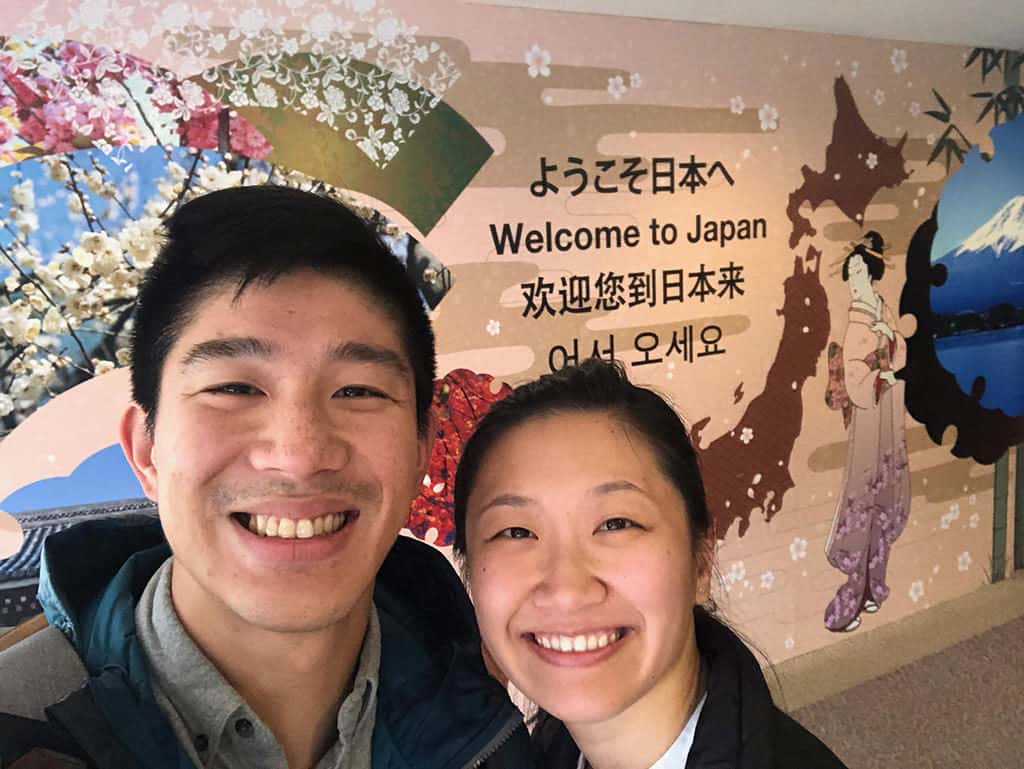
There are two main airports that service the city – Narita International Airport and Haneda Airport . Both cater to international arrivals and honestly if you had the choice, I would recommend flying into Haneda over Narita because it’s closer to the city and it has cheaper transit options compared to the alternative.
When you come out to the arrivals hall, you’re going to be overwhelmed with all the people waiting there and all the various stalls lining the wall. Your research ahead of time should help you figure out where you need to go as it really depends on where you’re going to in the city.
For some, the stalls right at the arrival hall floor will be what you’re looking for. Otherwise, you’re going to need to take the escalator down and that’s where you’ll find the huge JR storefront. This is also where you’ll find Keisei line.
We weren’t sure where to go at first so we asked the staff and they were very helpful in directing where we should go
For us, since we needed to be at Mizue Station, we caught a Keisei Main Line (Limited Express) train where we would eventually get off at Yawata. This cost 1,720 JPY.
Alternative options:
- Narita Express a.k.a. N’EX – 4,000 JPY but free with JR Pass
- Keisei’s Skyliner to Nippori and Ueno – 2,470 JPY
- Tokyo Shuttle bus to Tokyo Station – 1,000 JPY
- Taxi – Just don’t do it
Like I said, Haneda is a convenient airport to fly into because it’s that much closer to the city and even closer if you’re staying in Yokohama.
The easiest way to get in and out of the airport is through either the Monorail for 490 JPY or the Keikyu Line 580 JPY to Tokyo Station.
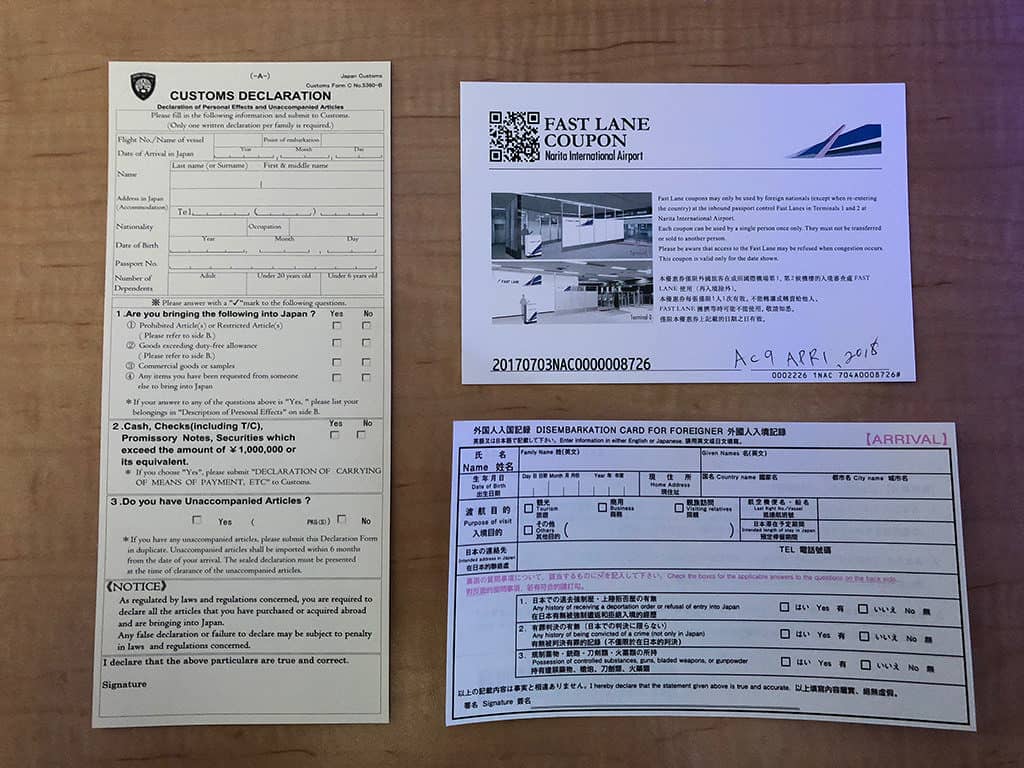
Did you know? Both airports have free wifi which is handy.
Keep in mind – Officially, there are accessibility options in the underground but they aren’t the friendliest in convenience. We brought only carry-on luggage with us but there were a ton of times we had to carry them up steps.
Where to stay in Tokyo?
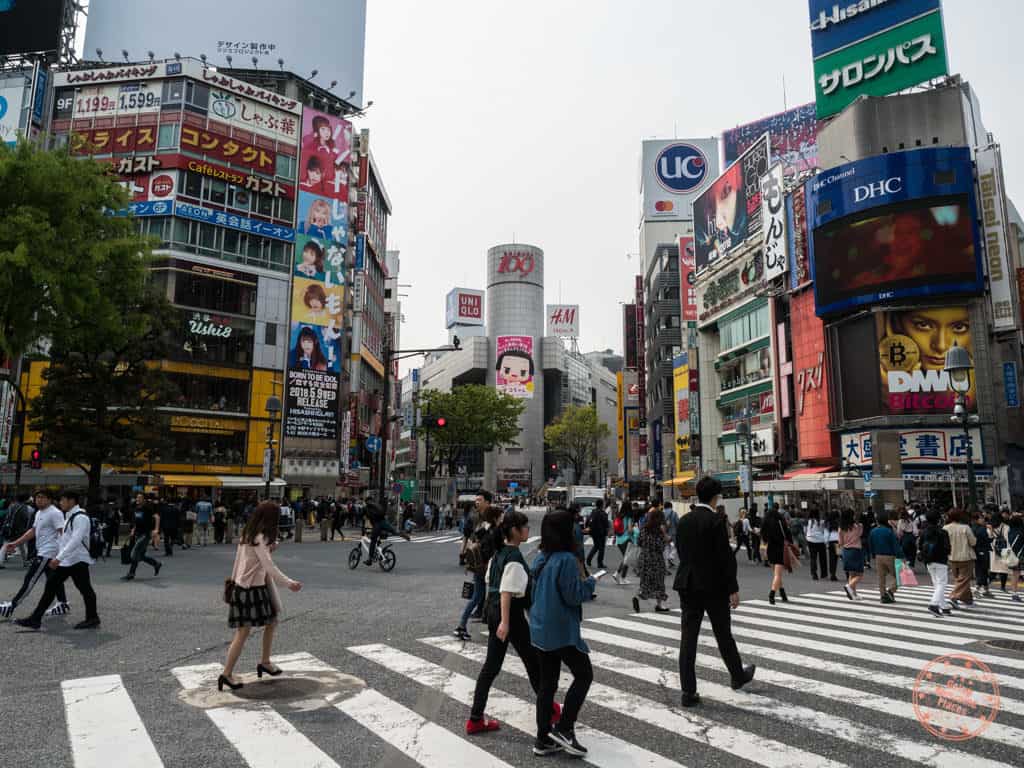
Talk about some serious contrast. Between our two trips to Tokyo, one was an ultra luxurious stay on points and the most recent one, an Airbnb at the fringes of the city.
There is a lot of choice of accommodations in Tokyo but to help you make your decision, the few things that you want to think about are:
- What is your budget?
- What neighbourhood do you want to be in?
- Do you want to do a pod hotel?
- How close do you want to be to a subway station (the answer is “very close”)
Where did we stay?
Like I said, truly a tale of two properties. The below are two of the places we’ve personally stayed at. Let me go into why you should one of those would be a good choice for you and if those don’t float your boat, I have a solid recommendation you can think about.
Remember, for additional savings, my Booking.com offer to get $25 CAD back is still on.
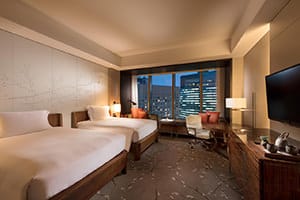
CONRAD TOKYO
This property is well deserved of Hilton’s top brand. Located near Shimbashi and Shiodome, this is located in a financial area which means there isn’t too much around directly in its vicinity but Shimbashi certainly makes up for it. We stayed here on points back in 2012 and were very impressed with the room, executive lounge, the lobby, and impeccable service.
TripAdvisor
Booking.com

AIRBNB IN EDOGAWA-KU
Since we booked our most recent trip to Tokyo very last minute and during the Cherry Blossom season, we elected to stay somewhere a little further away from the city to save money. Browsing through Airbnb’s supply, we encountered this particular room at $22 CAD a night. While cheap, this was definitely a no-frills kind of place (we even had to bring our own pillows). Bathrooms were communal as well in this 5 room house so in a lot of ways it was like a hostel. The walk to the Mizue station on the Toei line was roughly 13 minutes and another 30 minutes into the city. Can’t beat the price though.
If I were to do it again, I’d probably recommend a place like this.
CONSIDER THIS
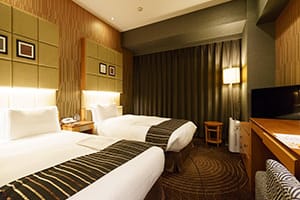
HOTEL SUNROUTE HIGASHI SHINJUKU
Located near Shinjuku, this hotel is conveniently located 10 minutes walk from the Isetan department store and more importantly right by the train station. The rooms are spacious, clean, and comfortable and up to standards as a mid-level hotel.
Neighbourhoods you want to be near
So as you can see, two drastically different accommodation experiences in Tokyo.
Having done both, I can confidently say that, staying in the city is much better. I say that because of convenience. When staying in the suburbs of Tokyo, we wasted a good 2 hours each day just commuting back and forth. Another thing you want to take into consideration when picking a neighbourhood is whether you want to go to the Toyosu Fish Market. It’s in an awkward part of the city and to make the 5:30AM meeting, you will either have to take a cab or stay right by Toyosu. I have a full new guide on the Toyosu Fish Market tuna auction experience .
Here are a few neighbourhoods that you want to consider being close to especially with their high concentration of things to do and restaurants.
- Shibuya – Famous for the crossing but also awesome for shopping, restaurants, and bars
- Shinjuku – A place that is super lively at night. This is where you’ll find Piss Alley but also the amazing Shin Udon.
- Akihabara – Nerd central here and a must-do for anyone that loves anime and electronics. Conveniently located and with tons shopping and restaurants nearby.
- Tokyo Station/Ginza – One of the more expensive areas to stay but if you can swing it, you’re right in the heart of some of the best food, shopping, and attractions like the Imperial Palace.
- Harajuku/Omotesando – One of my favourite areas as it’s a clash of the fancy shops along the main strip of Omotesando and then you have the quirky and grungy Harajuku. Meiji Shrine is also right there.
- Asakusa – Asakusa is one of the most popular destinations among tourists coming to Tokyo for the famous Kaminarimon gate and Sensoji temple. However, if you want to learn something about Asakusa or Japanese culture and explore less “touristy” places, it’ll be better if you have a local guide. This Asakusa Cultural & Street-food Walking Tour is offered by Magical Trip and you’ll have a informative and friendly guide who will give you a lot of new knowledge. For lunch you’ll cook Okonomiyaki or Monjayaki for yourself with an instruction from your guide and taste it!
- Ikebekuro – We didn’t get to visit here but I know this is a popular place for many restaurants.
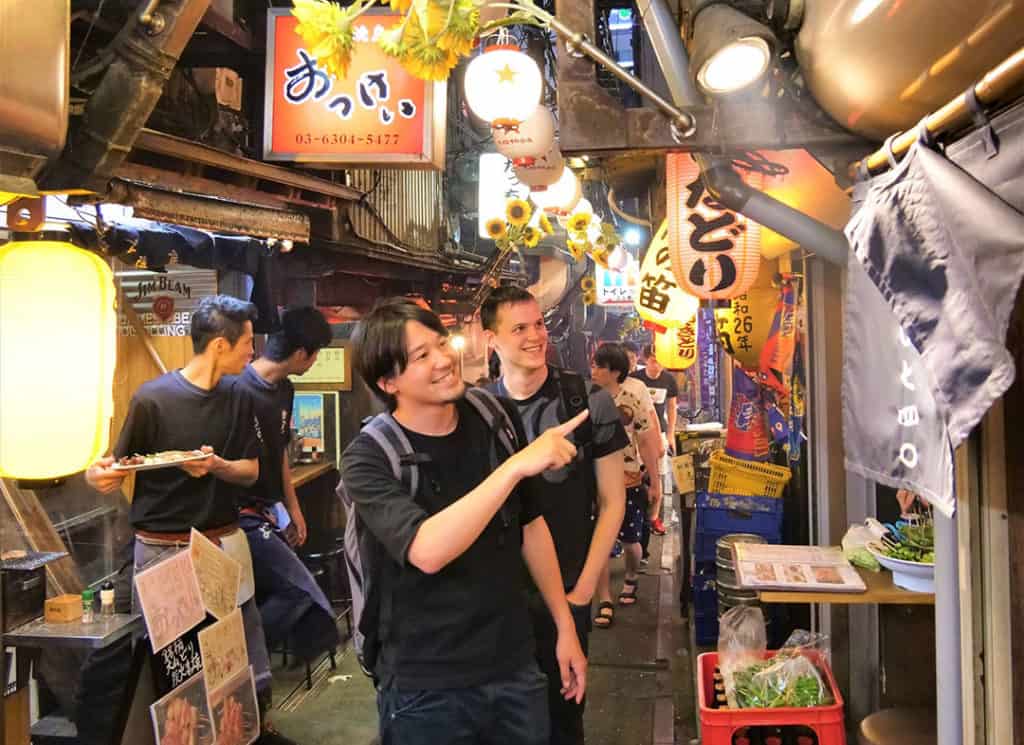
Tip: If you want to enjoy the nightlife, especially local drinking and dining culture in Shibuya and Shinjuku with awesome local people, Tokyo Bar Hopping Food Tours by MagicalTrip is your best choice
Did you know? Coming from North America? Good news! You don’t need any outlet adapters. It’s the same plug and almost all electronics you have now have no issues with Japan’s 100V vs 120V.
Getting around Tokyo

Alright one more thing before we get into the meat of what you care about. This is a super important topic in my opinion because this is what’s going to give you the most headache.
As I mentioned, there are a lot of options when you’re in Tokyo and that’s a great thing because it can take you anywhere you want to go. What’s not-so-great is the fact that there are so many companies. It almost feels like you need to be choose sides when you’re in the city. Do you align yourself with Tokyo Subway? Toei? JR? Keikyu? Tokyu? Odakyu? Keio?…you get the idea.
Which is the best line?
If you’re looking for the most comprehensive lines, Tokyo Metro is going to be your best bet. They also work closely with Toei which creates a very wide network.
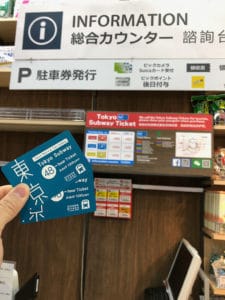
What pass should you get? Luckily, there’s are very affordable Tokyo Metro + Toei day pass options which in my opinion offers the best value .
- 24 hours – 800 JPY
- 48 hours – 1,200 JPY
- 72 hours – 1,500 JPY
These passes are great if you think you can make it work with one line and you know you’re going to be taking it quite a bit.
The tricky thing you have to consider though is where to buy it. When you land in Narita or Haneda, you should buy it right away and that’s a no-brainer but if you’re trying to buy one in the middle of your trip, it’ll be a bit more work. You can either buy them at designated Tokyo Metro Pass Offices in specific stations or you can try to find a nearby BIC Camera or LAOX electronic stores. There were several times where we weren’t able to link up one pass with another because 1) they don’t allow you to buy multiple passes and 2) we lived by a station that didn’t sell these passes.
When buying the pass, make sure you have a passport with you. For all the locations where you can buy the pass head here .
What about the JR line?
Love the JR line but unless you somehow have excess hours from your JR Pass , I don’t think it’s worth it to get special day passes with them.
That being said, the JR Line can come in handy for some routes especially with their Yamanote and Chuo Lines. That’s where the IC cards come in handy.
Be company agnostic with IC Cards
For years I relied on the special day passes but what you should be looking for is an IC (tappable) card once you land. The main reason is because these cards work on any and all systems. All you have to do load money into it and you tap-and-go. There is also a small discount offered on the fare to promote the use of these cards.
The one I’d recommend getting is PASMO which you can buy from a machine without having to go to a special location.
The deposit for a PASMO card is 500 JPY. All you have to do is load money onto the card and then that allows you to tap the card when you take any line in Tokyo. There’s a small discount for using the card and you won’t be restricted to any specific company.
A competitor to PASMO is Suica but they are essentially the same thing especially in Tokyo. Japan Rail Pass explains the difference very well in its FAQ .
Tip: If you want to be super organized and have everything ready before you arrive, you can get a Suica card online and pick it up at the airport , or even have it shipped internationally , although it might cost a bit more.
What gotcha’s should you look out for
From personal experience, I have two examples of when I was a little frustrated with the subway.
- We wanted to get from Shibuya to Ebisu . Look on the map and you’ll see that there’s no direct way to do that with Tokyo Metro. While it would’ve been one stop with JR’s Yamanote Line, we were committed to Tokyo Metro with their 48 hour pass. We looked at the transfers we’d need to do and decided that walking it was a better choice instead. That said, you could totally take the Tokyo Metro where you can refer to their subway map to find out the best way to get from stop to stop.
- We were in Asakusa and we were looking for a way to get home. We followed signs to the Asakusa station but when we went underground, we realized the station was run by a company called “Tsukuba”. This is when we realized we went the wrong direction completely. In frustration, we double backed to head to the Tokyo Metro and Toei’s Asakusa station.
Lesson learned: Look more closely at the map and go with a PASMO card next time so you’re not locked into a specific train company like we were.
Are you read to eat?? You better be!
FINALLY, we got all of the boring stuff out of the way. Don’t worry, it was part of the strategy. Just like waiting in line for food, my theory is that the food always tastes 10x better because you’re so hungry at that point.
The one thing that you notice immediately with food in Japan is how meticulously prepared and presented everything is. It’s not just the beautifully displayed plastic models of food but it’s also the the careful selection of Japanese ingredients that are paired together, and the freshness of what’s used to really bring out the flavours.
Whether you do a Tokyo Night Foodie Tour in Shinjuku or go out on your own, there are so many things you have to know about food in Tokyo but let’s start with the basics.
General things you need to know for feasting in Tokyo:
Best value for meals: As Mark Weins recommends , lunch menus are indeed that much cheaper than dinner. Now this doesn’t apply across the board as there are a number of places that are only opening for dinner. From my experience, this only applied to fancier restaurants like Tempura Shinjuku that we visited. If you plan on doing omakase, lunch is always cheaper than dinner if offered. As Mark did, we often had 2-3 lunches a day and did something much more casual for dinner.
Places don’t open that early: One thing you learn pretty quickly is that most restaurants don’t open until 11AM so as much as you’d like to start your eating earlier so you can spread things out across the morning and afternoon, it’s quite hard to do because of the starting hour. The only exception is of course Toyusu Fish Market. As a result, use the mornings to either make sure you’re first in line at a place, do Toyosu, or sleep in.
Tipping: I love that tipping is not part of Japanese culture. What you see is what you pay and nothing more. There’s no expectation to tip and some will in fact reject it even if you try.
Cash vs. Card: How card friendly is Japan? It’s actually quite easy to use credit card throughout the country. I was half expecting American Express to be rejected in many places but I almost used my awesome point earning cards with ease. That being said, it’s good to have cash on hand because there will be lots of places that won’t accept it or it just wouldn’t be convenient to. Street food, Tsukiji outer market vendors, and Piss Alley are good examples.
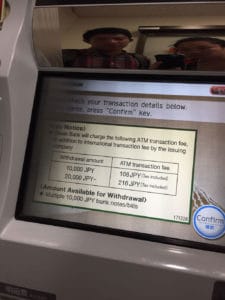
Withdrawing from ATM: During our two trips to Japan, we never found an ATM that didn’t have any fees. In fact, most of the “official-looking” would reject our Canadian debit card. The one place which would take our card was the ATM inside the 7-Eleven. The fees are unavoidable and at the time of writing, it cost 216 JPY for withdrawals > 20,000 JPY and 108 JPY for a 10,000 JPY withdrawal. The machines also only dish out denominations of 10,000 JPY.
Tax: One thing I’ve gotten used to in Asia is not having to deal with tax but Japan does have tax (sometimes) and the current rate is 8%. What wasn’t clear though is that there were definitely places that didn’t seem to charge tax but those tended to be the more local cash places and it’s possible tax was included in the price.
Depachika: These are the basement floors of big department stores. If you din’t know, you might hesitate to go to a fancy looking luxury mega-plex but then you’d be missing out on all the amazing food. From hot foods to desserts, Depachika’s are a feast for the eyes. Most of the times you won’t know the items are but this is a great place to randomly try things. Ginza is a prime example of this where high-fashion Matsuya, Ginza Six, and Mitsukoshi are hiding a vault of deliciousness.
Finding restaurants: Honestly, without data, we would’ve had 10x more trouble finding some of these restaurants. What you’ll find is that many restaurant names are only in Japanese characters. While it may have a translated English phonetic name, you’ll see no such name at the storefront. There were many times where we had to search for images of restaurant to see what the entrance looked like. If you don’t have data, I highly recommend you taking screenshots of the restaurant before heading out. Another thing to keep in mind is that there are a lot of restaurants hidden in multi-story buildings so you have to look for their name on the sign outside to figure out what floor they’re on.
Etiquette: We learned this from our time with Arigato Japan Food Tours , here are 3 taboos for chopsticks that are worth knowing:
- Don’t pass food to another person from chopstick to chopstick
- Don’t stick your chopsticks vertically in your bowl of rice
- Don’t pull your plate or bowl with your chopsticks
Eating on a budget: Tokyo isn’t a cheap place to travel nor is the food friendly for those on a serious budget but there are a few ways to do it if you’re looking to save money in between the splurging you might do :D

- 7-Eleven and other convenient stores – Like what we experienced in Taiwan , there is a ton of awesome food to pick up here. My favourite are the rice triangles called Onigiri especially with tuna or salmon. Anything you find here is usually pretty cheap.
- Bento boxes in Depachika – While food in depachika’s aren’t always cheap, there are great gems here. Seek out the bento boxes as they’re pretty tasty without being overpriced.
- Bakeries – Similar to Chinese bakeries, buns, breads, cakes, and pastries of all sorts can be found here. These typically make great breakfasts or if you need a quick meal on say a train ride.
- Fast food – You’ll see chains such as Yoshinoya and Sukiya all around the city. While we tried our best to avoid these, they’re good for a quick cheap bite in a pinch.
- Vending machine restaurants – On our food walking tour , we passed by a number of ramen shops frequented by salarymen (what they call the homogenous men in suits) that had vending machines where you’d pay for your noodles up front and be served in minutes. They’re not going to be the best quality but I’m sure they could beat many restaurants back home any day and still be affordable.
You can’t really share food: Originally we thought we could try to share dishes in an attempt to try more restaurants during lunch but we learned quickly that this strategy doesn’t really work in Japan because of the limited space. Some have explicit rules and others you just didn’t want to be THAT tourist.
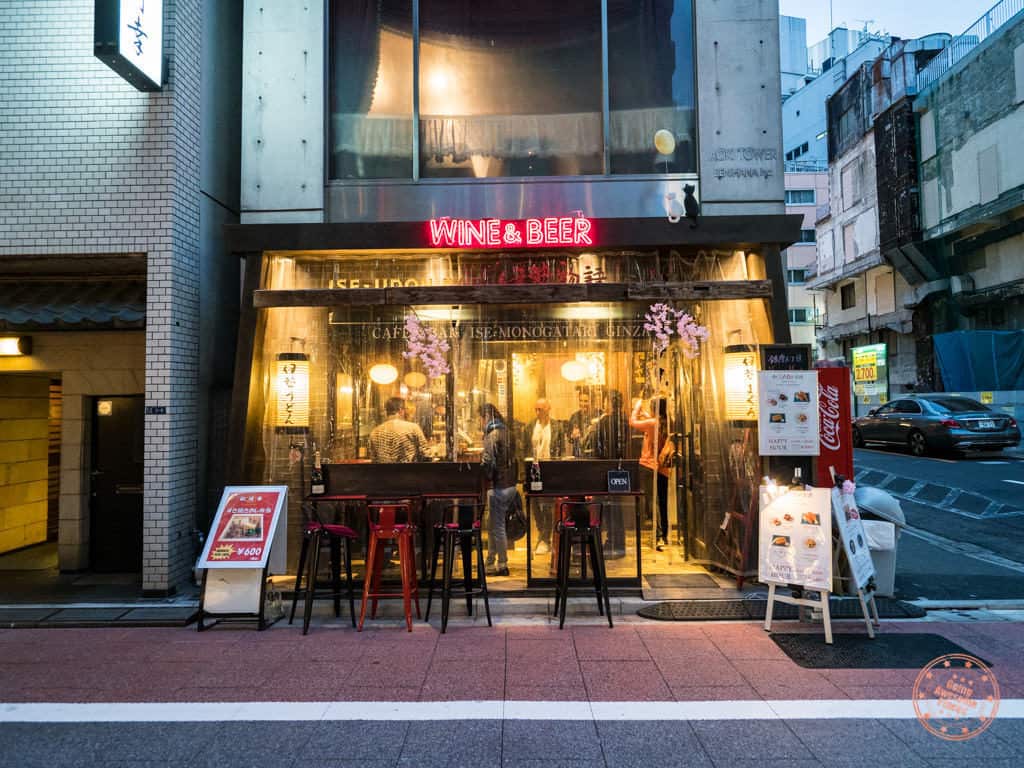
Think about doing a food tour: As much as you’re going to want to eat often and always, the size of your stomach and metabolism are going to smack you in the face. An awesome discovery we made was how good the food tours run by Arigato Japan Food Tours are. Instead of being limited to a dish per person when going out for dinner, sample an assortment foods in one night across a number of hidden gem restaurants in the company of a super knowledgable guide and fellow travellers. The particular tour we did covered Yurakucho, Ginza, and Shimbashi and is called their Allstar tour .
Wait so what happened to Tsukiji Fish Market?: That’s a great question. As of October 11, 2018, Tsukiji’s inner market shut down and everything shifted over to the brand new massive grounds of Toyosu Market. The good news is that Tsukiji’s outer market is still fully intact so I think it’s still worth going there because there’s a lot of food to try there and a ton of vendors that stayed. The bad news is that all the top restaurants (Daiwa, Sushi Dai, Nakaya etc.) and the tuna auction have moved to Toyosu which is further away and slightly more inconvenient to get to. I’m not going to go through how Toyosu Market works but I visited again in 2019 and I share everything I learned including the lottery system.
Explore Tsukiji with Magical Trip . On this Tsukiji Fish Market Tour by Magical Trip, you’ll walk around the famous Tsukiji fish market with a local guide, getting some new insights into the Tsukiji area and Japanese culture. You will also visit the Japanese Buddhism Temple and Shinto Shrine to find what our religious culture is like. And, most importantly, you will have a gorgeous seafood DONBURI (bowl) for lunch.
9 Best Restaurants You Have To Try
My mindset of these restaurant selections was that I was looking for places that weren’t going to blow up the bank, didn’t require reservation, but were highly recommended and ranked by other influential food blogs. I also took the advice of a number of friends that I consider to be foodie experts in Japan. What I didn’t use was anything like TripAdvisor or Yelp.
Let me be clear though, we were in the city for 6 days , and really less if you factor in our time in Tochigi, so we were quite aggressive in working out our stomachs and our feet. You can do it too but carefully plan out how you’re going to break down your days and your spread of Japanese food you’re going to try. What I mean is, if you already have a good tempura place in the plans, that means that you should probably cut out any other good tempura restaurant you also have in your list. If only you could do it all right?…or could you?
Here are my picks for top restaurants you’re going to want to add to your Tokyo itinerary whether you only have 1 day or 2 weeks. They range from small stalls, dessert shops, and fancier establishments. They are in no particular order but the ones near the top are the ones I have a little more attachment to but honestly all are worth going to. Here we go!
1. Uoriki Kaisen Sushi (海鮮 魚力 渋谷東急東横店)
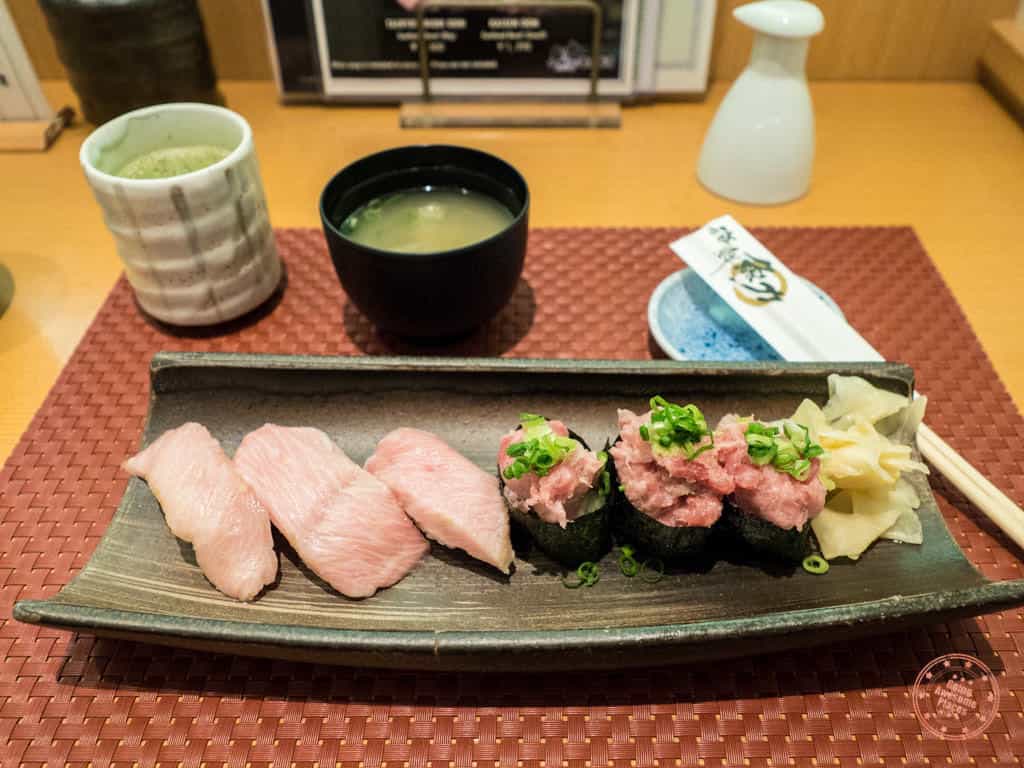
Tucked away and hidden next to a giant supermarket is this nondescript sushi restaurant that we never would’ve gone to if it wasn’t recommended to us. You could tell that it was super local too when we wrote our name down on the piece of paper and sat beside two grandmas that were also waiting for a spot.
The sushi here was fabulous especially the fatty tuna which was seriously melt-in-your-mouth good. Out of all the toro that we had in Tokyo, Uoriki was definitely the most memorable and most fatty. For the tuna set, I preferred the nigiri because you could really taste the textures and flavours of the fish while Chantelle liked the maki more because of the combination of diced tuna with scallion.
The seasonal sushi set we had was GOOD but the uni that day disappointed a little as it didn’t have quite the creamy texture we were expecting.
When ordering they asked us if we wanted wasabi but what they really meant was whether we were okay to have wasabi in our sushi which we did. All you have to do is dip in soy sauce and enjoy.

Neighbourhood: Shibuya Open hours : 10AM – 9PM M-Su Address : Basement floor (B1) of the Tokyu Department Store at Shibuya station ( see map ) Price : Fatty tuna set (1,500 JPY – $14 USD), Seasonal sushi set (2,000 JPY – $19 USD) English menu?: Yes
2. Shin Udon (慎)
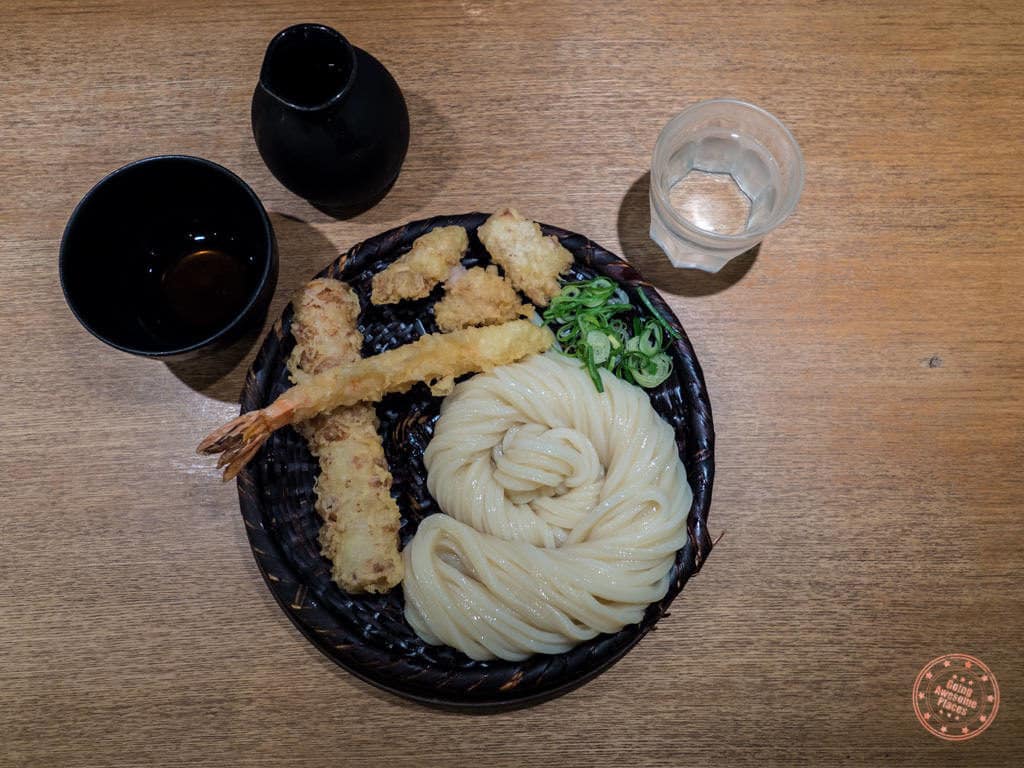
Ramen gets all the hype these days but what about its friendly, slightly chubbier cousin udon? Well friends, not to worry because udon is making a comeback here at one of the few restaurants we actually waited in line for.
We didn’t know what to expect when our friend jotted this place down in a Whatsapp message a few days before leaving but the timing of our hunger worked out when we ended up in Shinjuku. Arriving just past 7:30PM, we had to navigate a quiet dark alley before turning into another alley, but this time with a crazy line of tourists.
When we finally got inside, we could see why it took so long. With a maximum of 12 seats, it’s tight quarters inside which is pretty common in Tokyo. True to Japanese efficiency, we put in our order while we were in line so it only took 10 minutes for us to receive our udon.
I ordered the soy sauce udon noodles with yuzu pepper jelly, grated daikon radish, and chikuwa (bamboo shaped fish cake). Chantelle ordered the cold bamboo tray of noodles with shrimp tempura, chikuwa, and kashiwa (chicken) tempura.
Verdict? This is hands down the most amazing udon we’ve ever had. Thanks for our line mates who were Tokyo locals, they said the best way to truly appreciate the handmade udon is with a cold udon dish and boy were we glad we did. The al dente noodles had the perfect amount of bounce that you never get from the frozen udon we buy at home. The flavour combination was also excellently done especially with how the yuzu was used to delicately balance the grated radish. I normally don’t like radish but when you put it all together, it’s some kind of amazing.
Chantelle’s tempura was also perfectly battered – crispy on the outside while tender inside. While they looked somewhat similar, hers came with a soba-like sauce.

Water is included at no cost. We sat at the bar table and there was a big jug in front of us.
Other recommended items: There’s a cold udon with waygu chuck eye roll with chopped yuzu for 1,950 JPY but it was sold out by the time we ordered.
Neighbourhood: Shinjuku Open hours : 11AM – 10PM M-F, 11AM – 11PM Sa-Su Address : ( See map ) Price : Soy sauce cold udon with yuzu (1,250 JPY – $12 USD), cold udon with tempura (1,300 JPY – $13 USD) English menu?: Yes
Read TripAdvisor Reviews
3. Yakitori Ton Ton (登運とん)
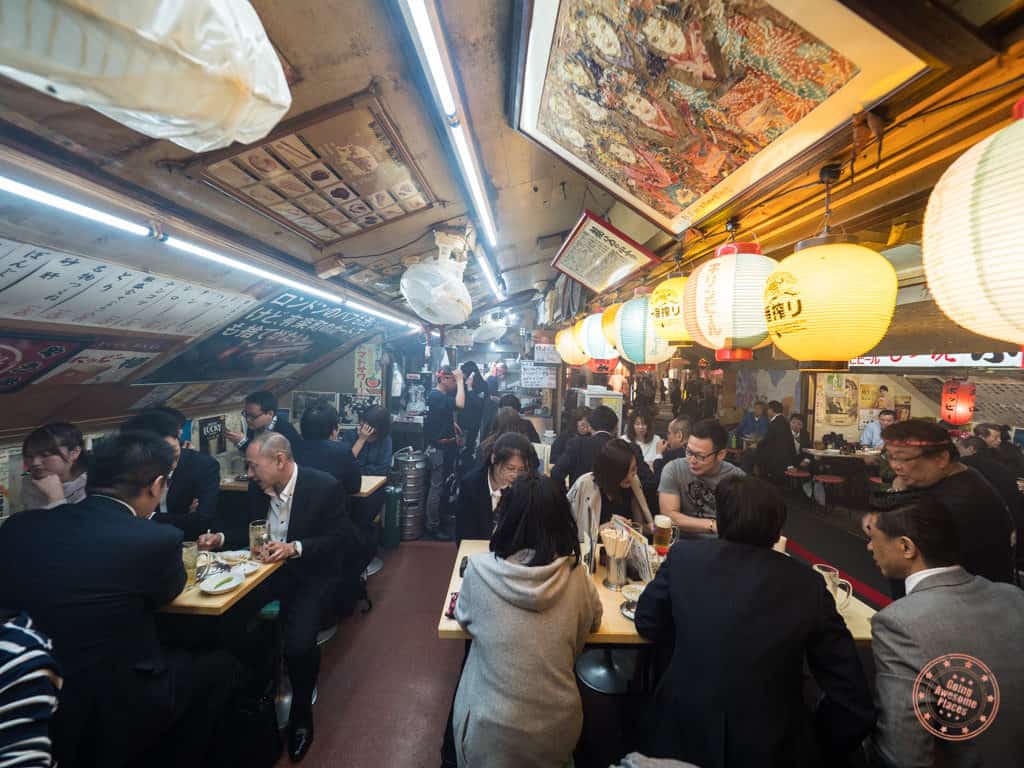
If eating meat on sticks and drowning them in beer sounds like your thing then you have to add this spot to your list of restaurants. There’s no livelier and more local place than this hole in the wall, under the train tracks, yakitori restaurant.
When we came out of Shimbashi station to look for this place, we weren’t sure if we were heading the right direction but we continued to follow the raised train tracks and all the restaurants below them till we started hearing more noise. When we found this busy throughway and matched the characters, we knew were at the right spot.
With small tables stretching out onto the walkway, smoke billowing and desperate to reach open air, the clanging of glasses, salarymen roaring in conversation, and sizzle from the grill, we anxiously waited in anticipation for our table.
Luckily for us, it wasn’t long until two other tourists finished and we got our spot. Overall I’d say the crowd was mainly local but the word has definitely gotten out to travellers so you’ll see them scattered around. That said, the place isn’t big at all. If you watch the video, I don’t think it could fit more than 25 people.
Thanks to the English menu we were able to put our order in pretty quickly and one by one, succulent skewers of chicken, pork, meatball, gizzard, green pepper, alongside takowasabi (diced octopus in wasabi – omg the best), and beer on tap came to our table. It was heavenly.
What made it such an awesome experience was that we were eating with all of the other salarymen and women that had just gotten work, there was a kinetic energy that we could feed off of, and of course all of the skewers we had were grilled just right. Nothing was overcooked. The chicken was so good that we ordered a second serving.
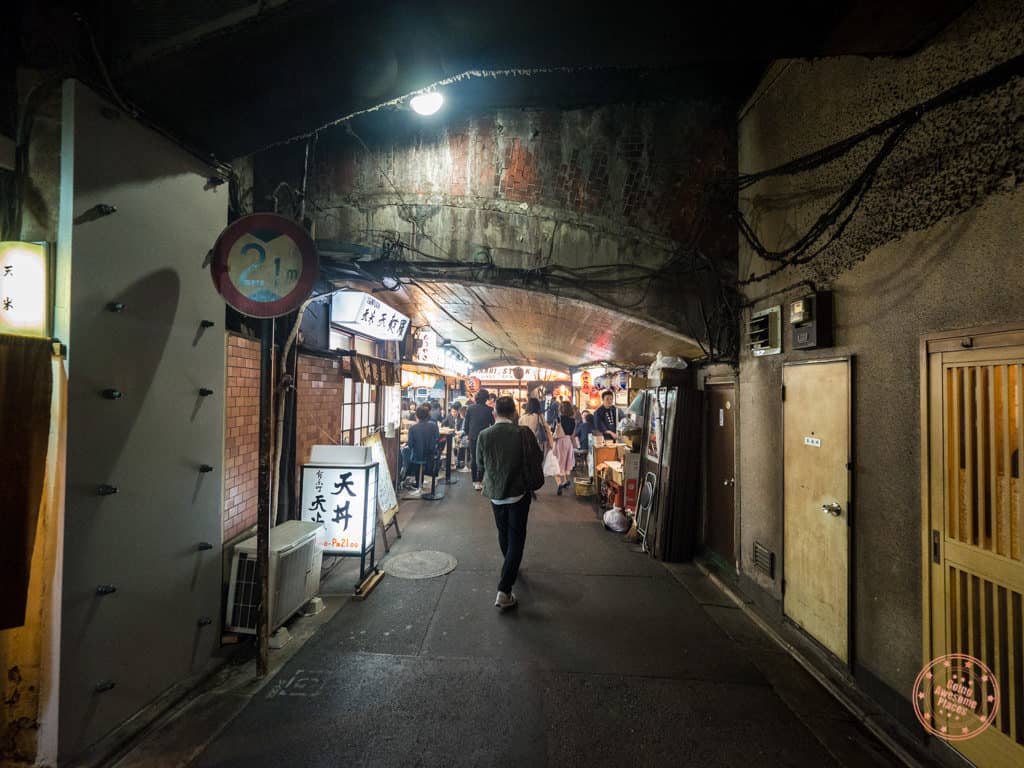
There are two identical yakitori restaurants on this throughway. Only one of them is this one. The other is a different restaurant but from what I saw, I don’t think you could go wrong with either.
Before we were seated, they made sure we understood the rules: 1) Each person must order at least one food item and one drink item 2) When it’s busy, the max seating time is 60 minutes 3) Prices do not include tax 4) It’s cash only.
Neighbourhood: Yarakucho/Shimbashi/Ginza Open hours : 1PM – 11PM M-Th, 12PM – 11PM F-Su Address : ( See map ) Price : Assortment of skewers, two servings of takowasabi, and drinks (4,276 JPY) English menu?: Yes
4. Nakaya (仲家)
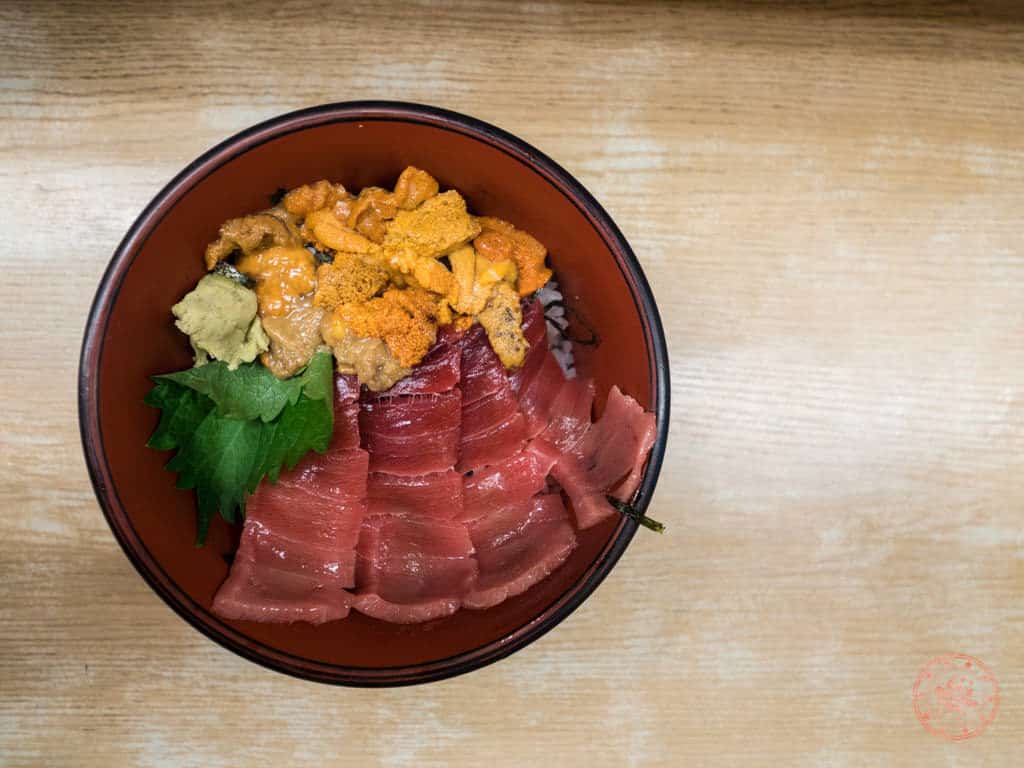
Nakaya is now at Toyosu

I can confirm that Nakaya has now moved to Toyosu Market from Tsukiji. They can be found in the Fish Intermediate Wholesale Market Building and the floor of restaurants. Saw the same chefs and assistants working there. I’ve kept my description of Nakaya the original from my experience at Tsukiji. Read more about Toyosu
You could say that Tsukiji Fish Market is a pilgrimage of sorts if you love sushi. Sure there are better and fancier Michelin rated restaurants in Tokyo but a trip wouldn’t be complete without a visit to one of the sushi restaurants here and for breakfast no less.
In a previous trip to Tokyo, we had done Daiwa Sushi which was an amazing experience. It’s one of the two sushi restaurants at the market that constantly get reviewed. This time though, we didn’t feel like getting up at 4AM to get sushi so we instead woke up at 6AM to get to this restaurant at 7AM.
The beauty of Nakaya when we arrived was that there was no line at all. In fact we showed up, gave our order to the lady in the front, and after one couple came out, we were seated inside at counter seats.
Where Daiwa Sushi was that omakase (chef’s selection) style of menu where you got each nigiri one at a time, Nakaya is all about chirashi which means sashimi on a bowl of rice.
Our bowls came out lightning fast and the fish as fresh as it gets. I personally thought the toro was better at Uoriki Kaisen Sushi but the uni was insanely good here.
The only thing I found was that the service at Nakaya wasn’t the most friendly especially for foreigners but that might’ve been because of all the photo and video I was doing there.
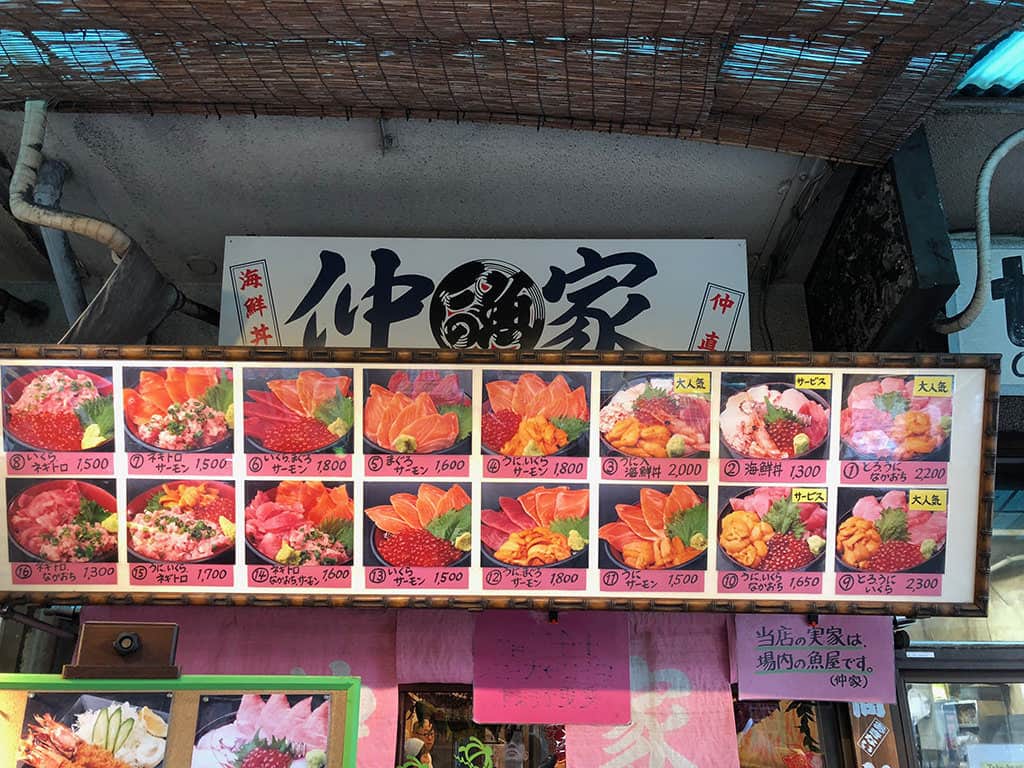
Neighbourhood: Toyosu Open hours : 5AM – 2PM M-S (closed on Sunday and holidays) (these are the old hours at Tsukiji) Address : ( See map ) Price : Mixed sashimi chirashi (2,000 JPY – $19 USD) and uni + toro chirashi (2,300 JPY – $22 USD), Cash only! English menu?: No, but there is a huge menu with pictures at the entrance so just point and order
All the details about Toyosu Fish Market
If you want to get the lottery tickets to see the tuna auction at the Observation Deck level or curious about the buildings that are spread out including where Sushi Dai and Daiwa Sushi are, make sure to head on over to a new detailed post all about how it works.
How the Toyosu Market Works
5. Sometaro Okonomiyaki (染太郎)
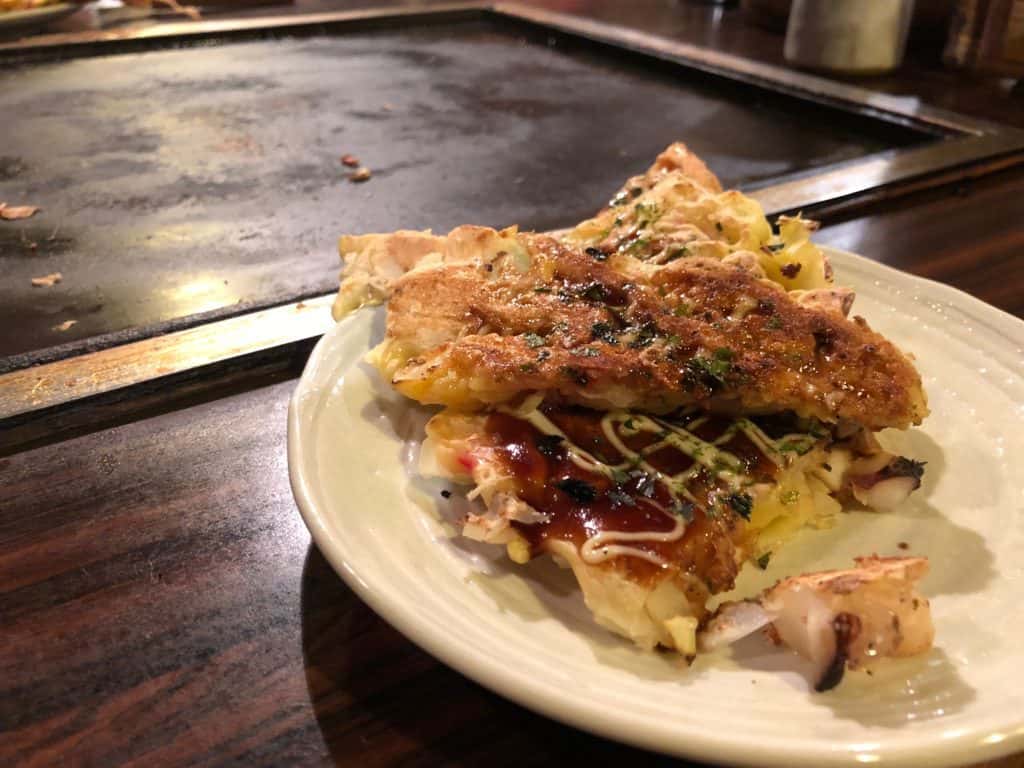
Okonomiyaki is a savoury Japanese pancake that you have to have in different parts of the country because every region has their own take on this popular dish. The Kansai region (Osaka) and Hiroshima are said to be the place or origin but if you don’t make it out there, you should definitely have it in Tokyo.
What makes the okonomiyaki experience so unique in Japan is that restaurants that specialize in it allow you to make it yourself. That’s good or bad depending on how you look at it. Do you really trust yourself to make okonomiyaki?
Regardless, it’s a really fun experience especially at a restaurant like Sometaro which is rebuilt to be in the atmosphere of the Showa period. Stepping inside is a bit like going back in time with nostalgic posters on the wall, photos everywhere, and well-loved and aging tatami flooring, and mini teppanyaki griddle.
Okonomiyaki is essentially a mixture of tempura batter with a variety of ingredients depending on what you order. They come in a bowl and the rest is up to you. Following the instructions in the menu, you melt something like butter on the hot plate before pouring the batter on in the shape of a pancake. The key is to split the batter in two, otherwise it’s too difficult to flip. Once it’s done, you decorate it with mayonnaise, teriyaki sauce, and seaweed flakes. Using the spatula you split it up like a pizza, serve, and enjoy!
The two types that we ordered were Gomokuten which is essentially the house special with seafood and minced meat and Mochiten which was pretty unique with corn, rice cake, and cheese. Both were super tasty and loved Mochiten because you know I love my mochi.
I’m not going to lie, this is a touristy area because of its popularity. In the area that we sat near the back, it was all foreigners. That said, I loved the ambiance of the place and being on a bit of a culinary adventure of trying to figure out how to make something on your own. It was funny how we totally screwed up our first okonomyaki but figured it out with our second one.
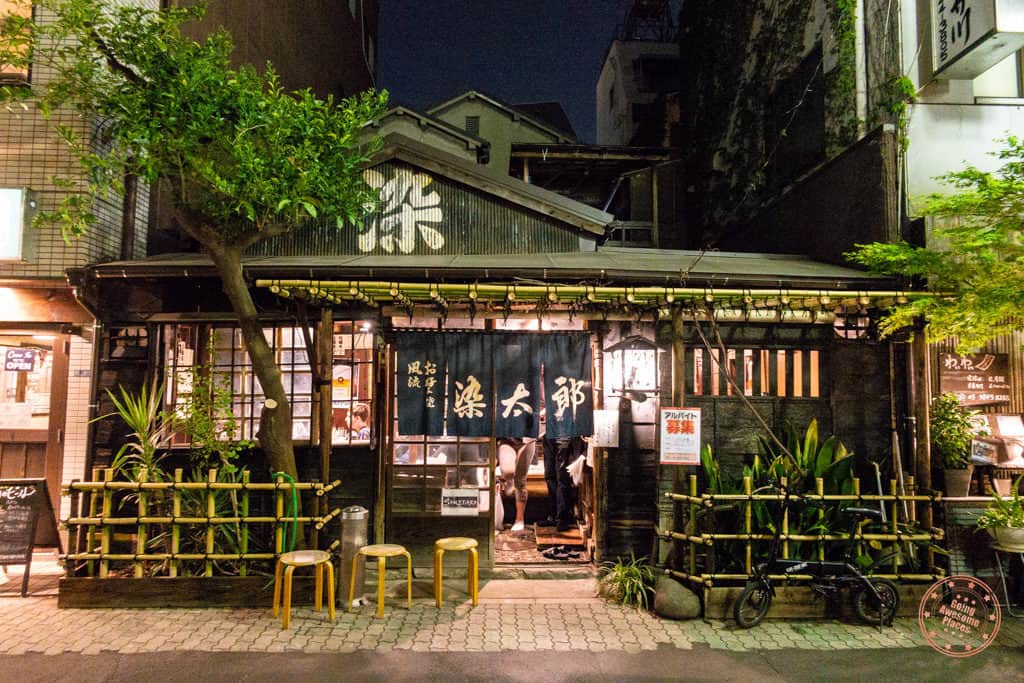
Water is free and at the back of the restaurant. On the rack you can grab a cup and fill it up yourself.
They will ask you to take off your shoes ahead of time. There are plastic bags at the front where you’ll be able to put your shoes to bring inside.
It gets hot there with all of the griddles going. They provide handheld fans just for this reason so be prepared to peel of a few layers.
Neighbourhood: Asakusa Open hours : 12PM – 10PM daily Address : ( See map ) Price : Gomokuten (870 JPY – $8 USD) and Mochiten (760 JPY – $7 USD) + Sapporo English menu?: Yes. Waiters know English as well.
6. Tempura Shinjuku Tsunahachi Ginza (天ぷら新宿つな八 銀座店)
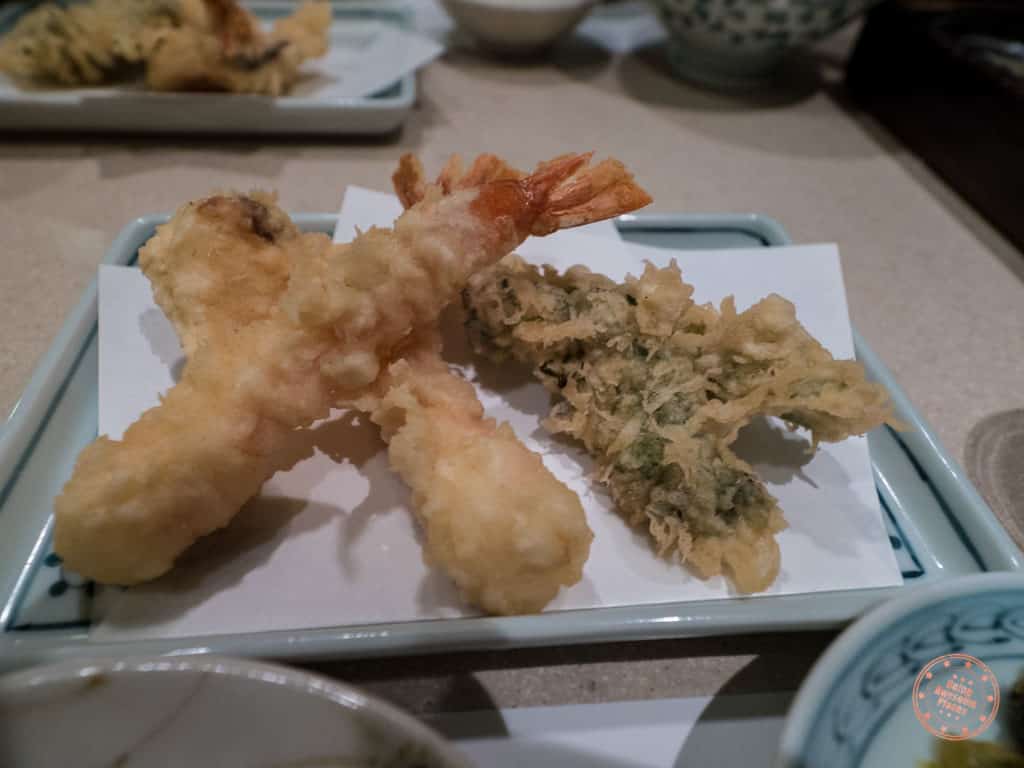
Battered and fried seafood, meats, and vegetables is a mainstay of Japanese cuisine but did you know that it was introduced by Portuguese merchants in the 16th and 17th century? Battered fried food wasn’t a thing until that point in time. Just one of the few things we learned during our walking food tour .
Just like every other type of food in Japan, there’s always the pursuit for perfection and that’s how I discovered this high-end yet affordable tempura experience. Founded in 1923, Tempura Tsunahachi built its reputation on using the freshest ingredients and highest quality tempura in Tokyo. Starting in Shinjuku, they now have a total of 7 locations around Japan. We elected to go to the newer Ginza location.
With a ton of heritage, and frequented by kabuki actors and baseball players over the past century, you’d think things would be ridiculously expensive but for lunch it really isn’t. Showing up at 3:30PM on one of the top food floors of the Matsuya department store, we were seated immediately and found ourselves to be one of the few guests there.
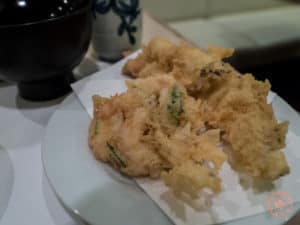
We were presented with English menus but the choices were pretty simple with their lunch set menu that all had a combination of tempura’ed fish, shrimp, vegetables, and kakiage (mixed veggies, onion, and shrimp). I’m sure there was an a-la-carte menu but they didn’t bother showing us as foreigners. We both ordered the 6 piece set, mainly because it was the cheapest option but also the fact that we had sushi only a few hours earlier. We would’ve shared but felt like it would be poor etiquette.
What makes Tsunahachi a must-try is because of how serious they are about their tempura. As each plate comes to the table, you’re amazed at how the batter is cooked just enough to be crispy but at the same time not drenched in oil. It’s a nice light mix that they’ve clearly perfected.
To top that off, we were also given a laminated English sheet on the proper way to have tempura. It’s a multi-step process and you realize you’ve been doing it wrong your entire life. I remember thinking to myself “Wow, so this is how tempura was meant to be eaten!”
This was certainly one of our more expensive meals in Tokyo but definitely the best tempura we had on our trip.

Neighbourhood: Ginza Open hours : 11AM – 10PM daily Address : ( See map ) Price : Tempura-zen set menu (2,160 JPY – $20 USD) English menu?: Yes
7. Tokyo Station Ramen Street – Rokurinsha Ramen (六厘舎)
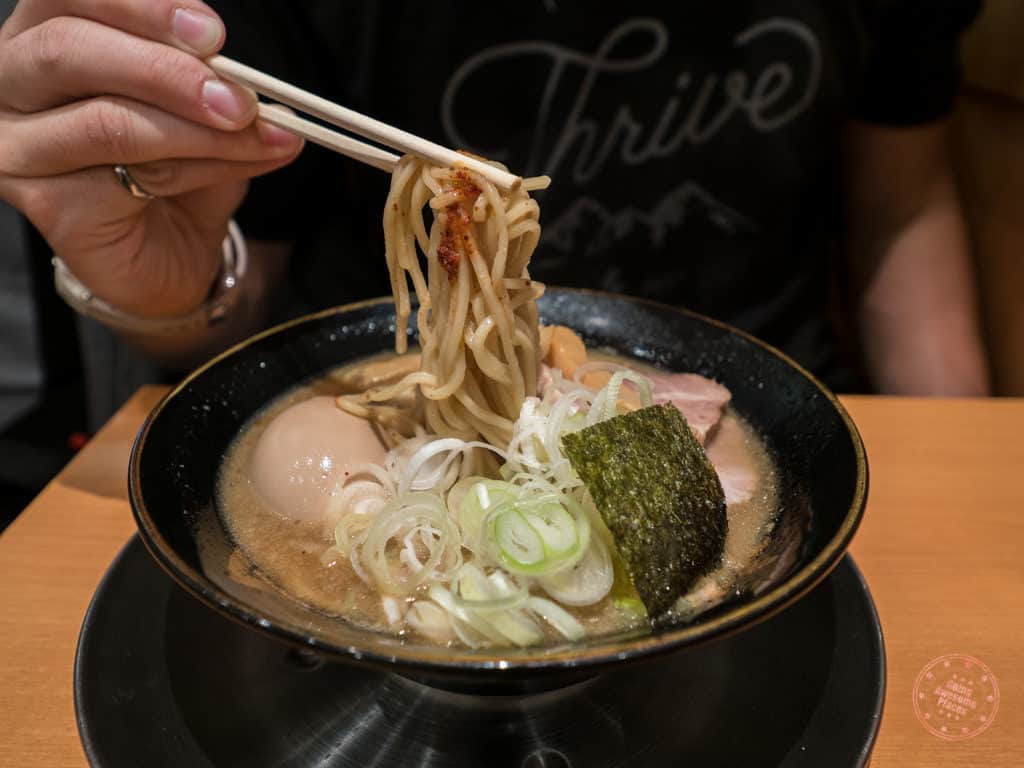
Ramen is kind of an obsession in Tokyo and everyone you talk to will probably have their own take of what is “the best”. Confused by all the choice, I figured it would be easier to go somewhere that had several options to choose from. That’s when I found out about Tokyo Station and their cluster of ramen shops on what’s affectionately called Ramen Street.
The history behind it is that when they built the basement level, they took 8 of the best and most famous Japanese ramen shops from around the country and asked them to open up shop on the street.
We went there not knowing where we’d be eating but of course we got suckered into the one that had a line. After all, Japanese queues are always means that it’s something that’s worth waiting for right? This ended up being Rokurinsha which is right at the main corner of Ramen Street.
We made it right before the off-work rush hour at 4PM and got seated after waiting in line for 20 minutes. We ordered the Special Ramen and Special Dip Noodle as we waited in line as instructed by the waiter directing traffic.
Rokurinsha is known for a type of ramen called Tsukemen style where soup and noodle are separated and the broth is much more rich and the noodles thicker. This is what they call “Special Dip Noodle” in English. Usually we’re pretty open to trying new types of food but the Tsukemen style wasn’t one for us. We found the broth too rich and a little too overpowering in fishiness. This is thanks to the addition of gyofun (dry fish powder). It almost tasted like canned tuna. Sad to say, we didn’t finish the bowl but we did notice that when you’re done your noodles they basically dilute the broth so you can drink it like a soup.
My special ramen on the other hand was fabulous and more of the traditional style of ramen that we’re used to. I found the broth to be just the right level of thickness and oiliness. The egg was done brilliantly with the golden yolk that’s on the edge of being fully cooked through. The slices of pork were generous and the scallions alongside bamboo shoots the perfect combination.
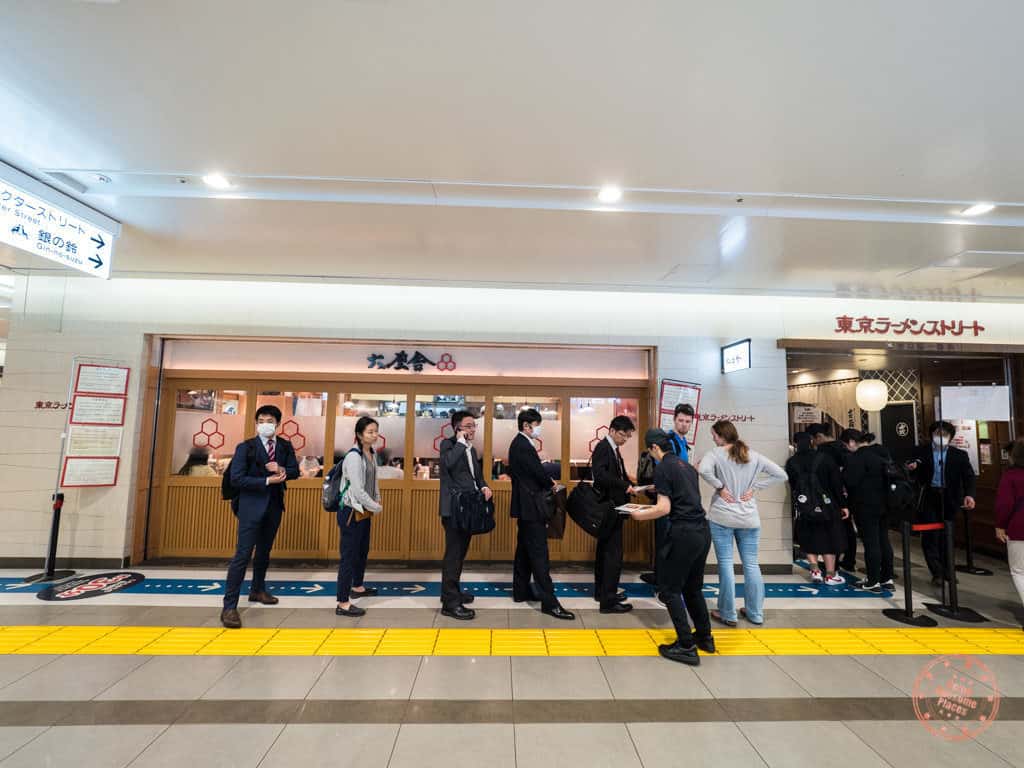
You have to use a machine to order and pay at the vending machine. What’s a little counter-intuitive is that you have to put money into the machine first before pressing the buttons for your order. The ticket that gets printed is what you hand the server when you get your seat.
Neighbourhood: Tokyo Station/Imperial Palace Open hours : 11AM – 10PM daily Address : ( See map ) Price : Special Ramen (900 JPY – $8 USD) and Special Dip Noodle (1,060 JPY – $10 USD) English menu?: Yes
8. Memory Lane – Piss Alley (Omoide Yokocho – 思い出横丁)
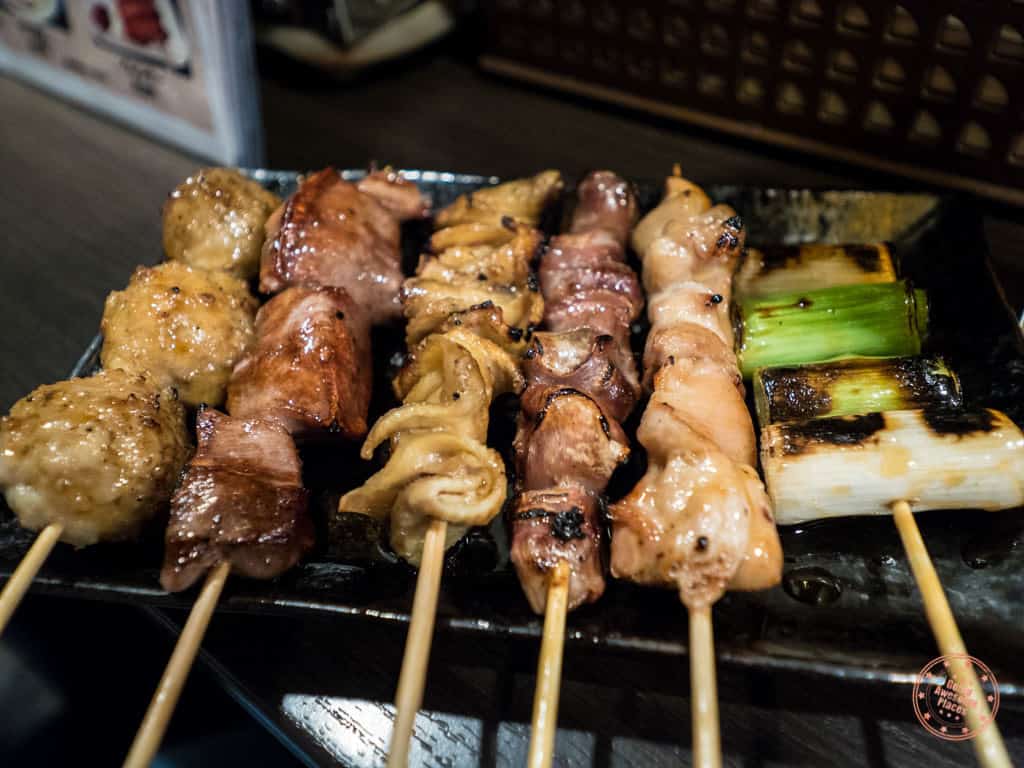
There’s a narrow alleyway next to the bustling Shinjuku station where lots of izakaya and yakitori are had and also where men often relieve themselves after having too many pints. That is how the name Piss Alley was born. Luckily, times have changed and there’s not so much of the namesake happening anymore but it is still a regular place for after work celebrations to happen.
This long alley called Memory Lane is flanked by tiny stalls on both sides where everyone huddles around the bar on tiny stools while the owners grill up skewers. As you walk from one end to the other, everything from the sounds, smells, and visuals are amplified.
There are a ton of restaurants to choose from and from my observation, you really can’t go wrong with any. All of them are as full of character as the next and equally as tight quartered. You kind of just need to pick and see which ones have seats available.
We ended up at one of the bars near the front and ordered 6 skewers and a glass of local beer to wash it down. The seats were barely big enough for my butt but luckily we weren’t shoulder to shoulder with the other people eating there. The skewers themselves were pretty good but definitely not quite as good as Yakitori Ton Ton.
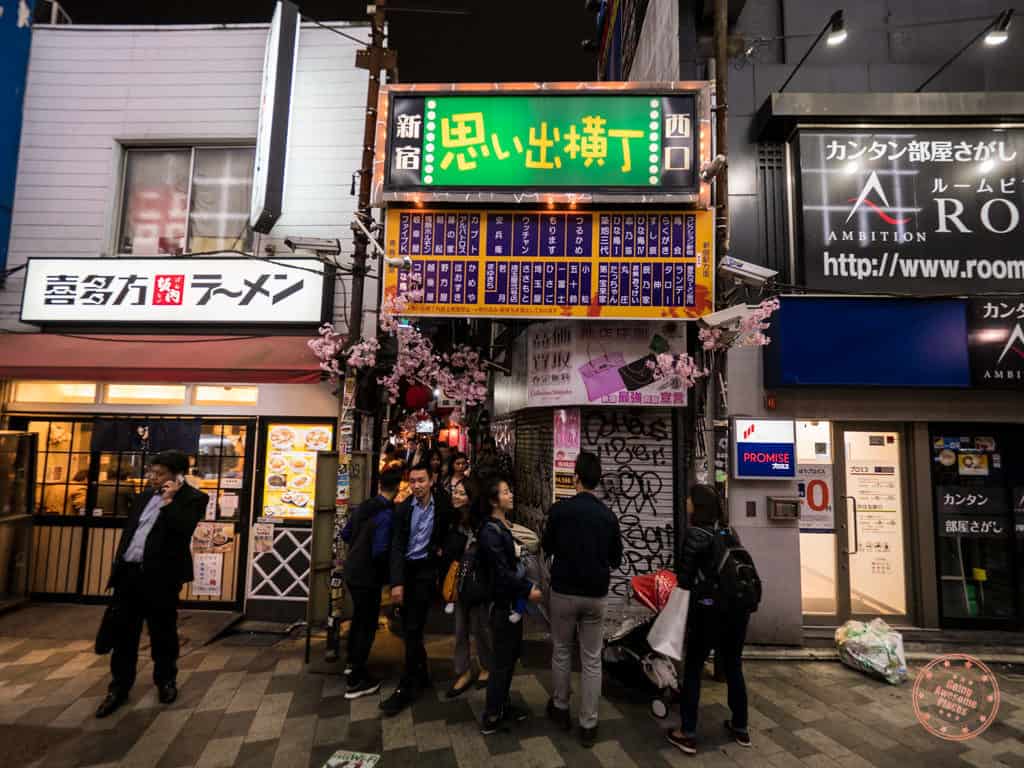
Ordering a minimum of one drink is required.
What turned us off a little was when we got the bill and it was much higher than we expected. Turns out, some of these places automatically charge a “sitting fee”. We later learned that this is to compensate for small spaces and needing to maximize each customer. What they do is sneakily offer you an appetizer which for us was this cold glass noodle similar to Korean jap chae and even if you don’t want it or eat it, it’s 300 JPY on top. That said, it’s one of the few places that we were able to “split” the food so I guess it was fair game.
Neighbourhood: Shinjuku Open hours : Late afternoon and late into the night Address : ( See map ) Price : Assortment of skewers (2,000 JPY – $19 USD) English menu?: Yes
9. Motodane (本種)
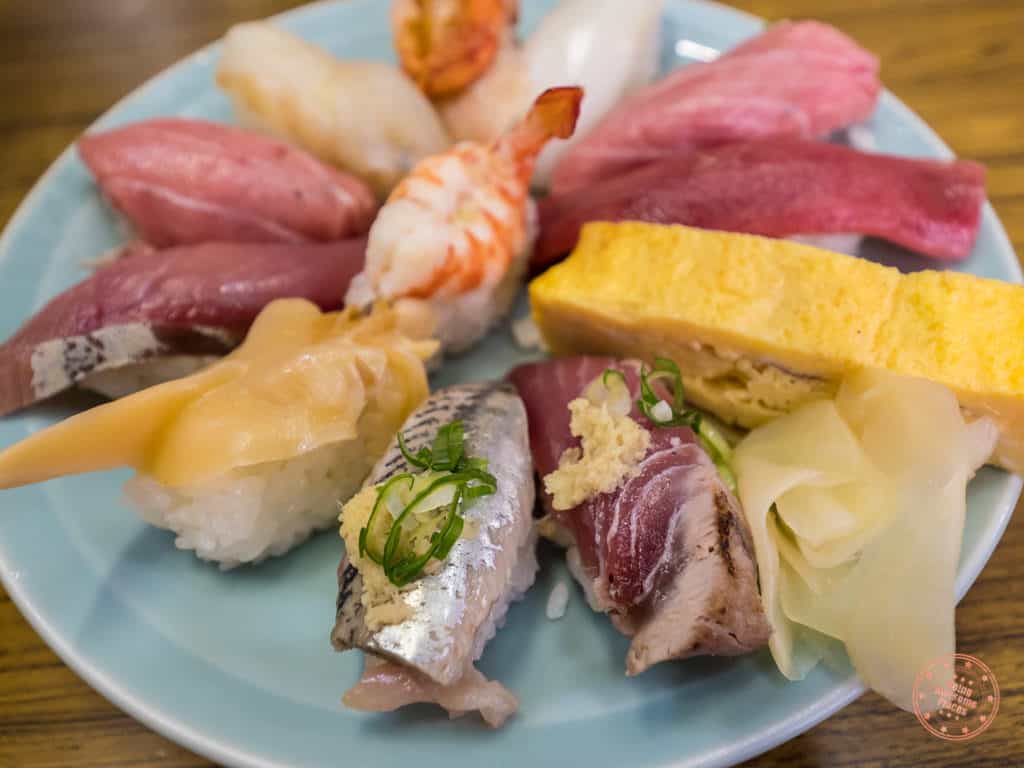
Down a quiet alley on the East end of Tsukiji Fish Market is a sushi restaurant that is so easy to miss that we must’ve walked passed it 3 or 4 times before we finally figured out where it was. The street itself looks more for wholesalers than anything but tucked away is an entrance on a side-alley to this wonderfully local sushi spot called Motodane.
For those that are wondering, yes this is still at Tsukiji !
What we loved about this place is that it is hyper local. Business men on lunch and other locals dined either at the bar or in the back where we were and there wasn’t an English character in sight. To order, they pointed to the menu pinned up on the wall and tried to explain what they were. We could pick up nigiri and sashimi so we were able to figure it out. It also helped that they were preparing meals for other tables so they could kind of point to things.
The chef’s selection of nigiri and sashimi that we ordered was mouthwateringly fresh and the perfect breakfast paired with the miso soup that came with each plate. The only thing missing was uni.
The one knock I had on the place was that the mackerel we had was laced with bones in it which we thought was a bit odd. So sure the experience could’ve been more refined in terms of better slices and selection of fish but for half the price of Nakaya, who were we to complain.
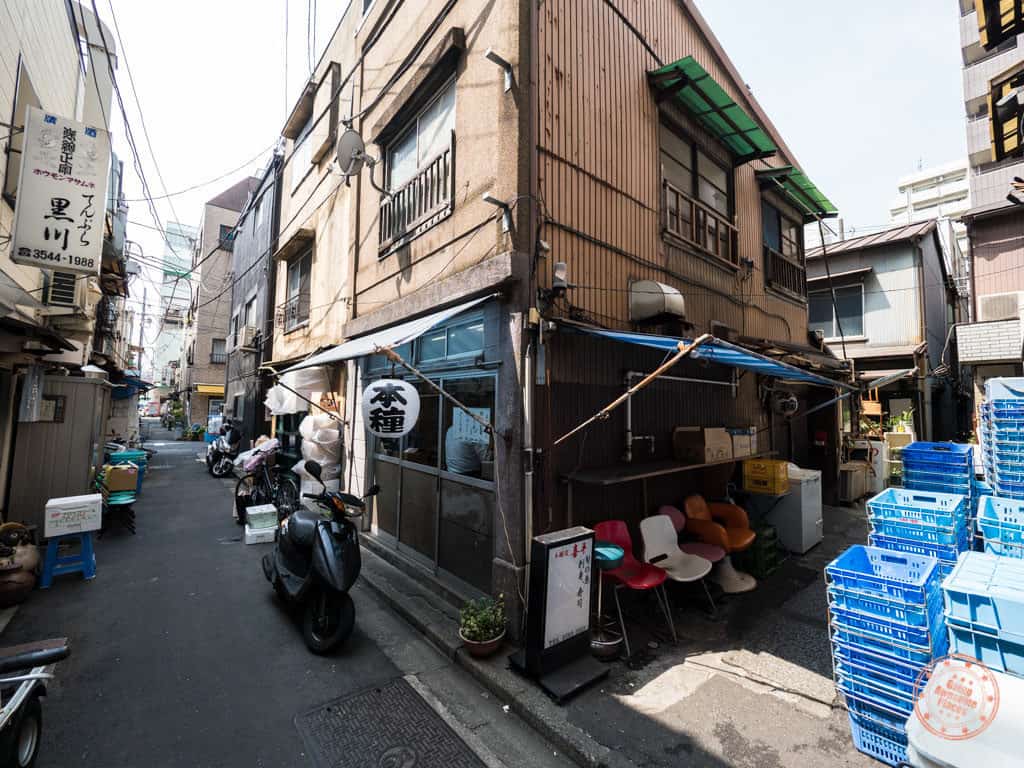
Neighbourhood: Tsukiji Open hours : Late afternoon and late into the night Address : ( See map ) Price : Sashimi plate (1,200 JPY – $11 USD) and nigiri plate (1,500 JPY – $14 USD) English menu?: No
Top 5 Dessert Spots in Tokyo
You know I love my dessert too much to not share with you a few of my favourites. It was so easy to find people’s lists of favourite Japanese restaurants in Tokyo but what about the sweet stuff?
1. Flipper’s (代官山店)
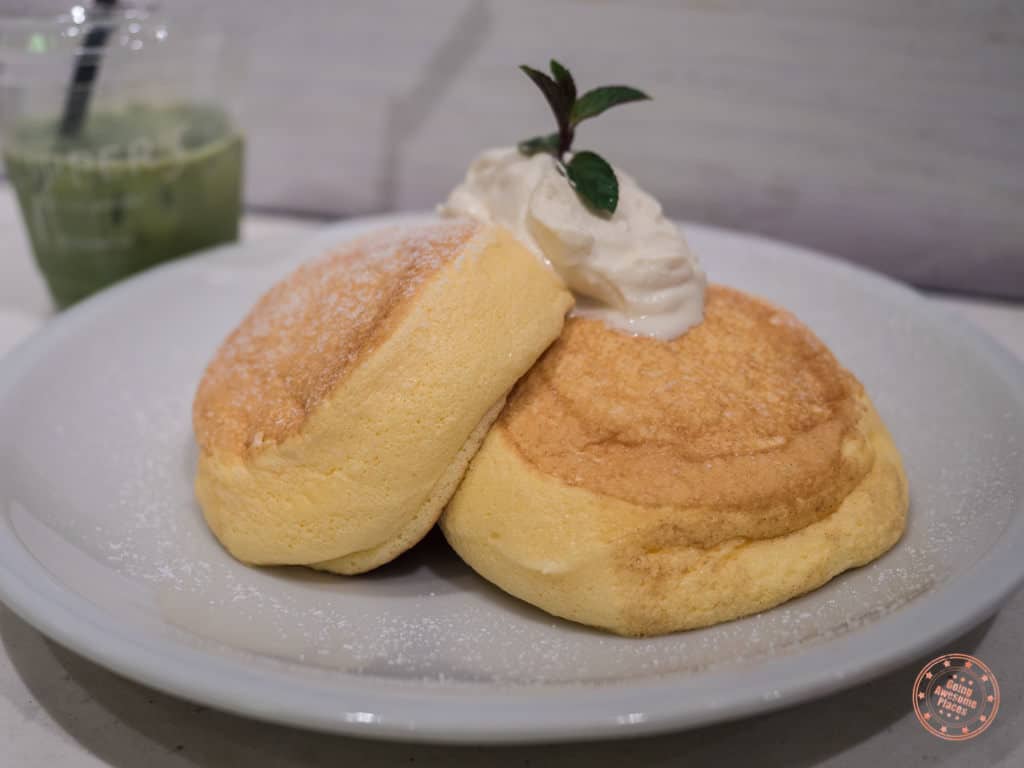
Pancakes are the champions of American Breakfast. In fact, there’s an international house of them. Soufflé is the French art of heavenly light and puffy cakes made with egg yolks and beaten egg whites. What happens when you mix them together in Japan? You get Flipper’s and an all out new sensation called soufflé pancakes.
Topped with special maple butter cream, these super fluffy and melt-in-your-mouth desserts blew my expectations for what a pancake could be. The choices are pretty simple – you can either get them with fruit toppings or without. You’re going to love these airy and delicate creations.
Lucky for us we didn’t have to deal with any mind boggling queues but did have to wait in line for roughly 20 minutes before getting into their Ebisu location. Luckily they had chairs and like all the restaurants that had a queue, they took our orders ahead of time.
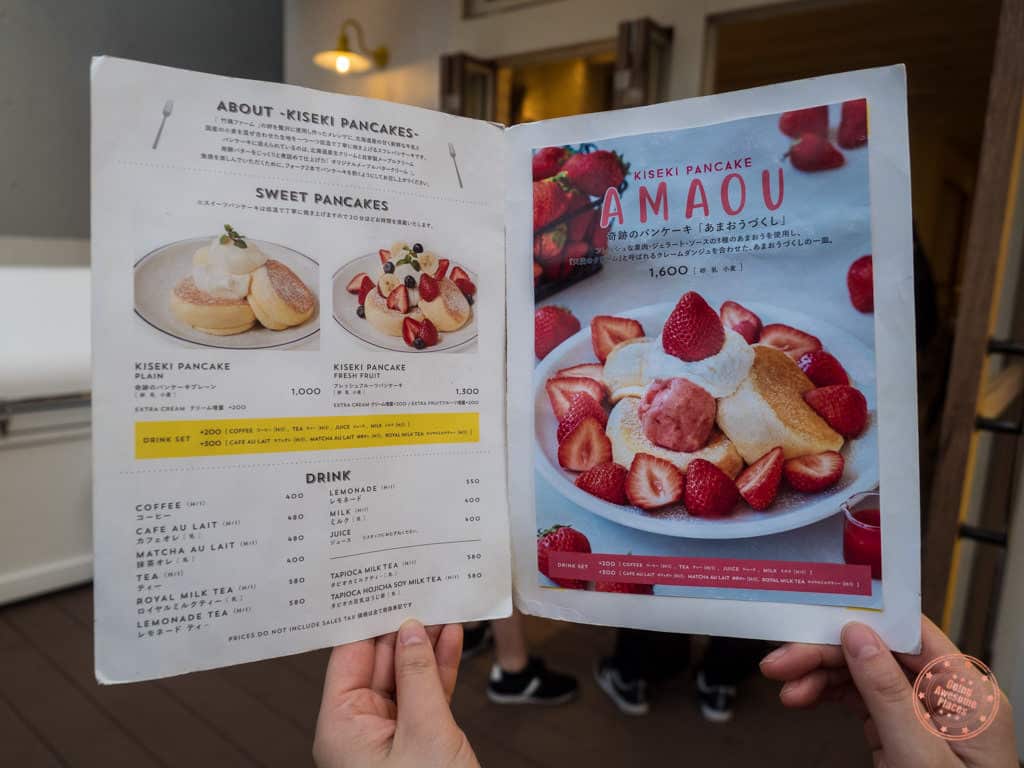
This was one of the few places where we could share a dish but they did make us order a drink.
Neighbourhood: Ebisu Open hours : 11AM – 8PM M-Su Address : ( See map ) Price : Original soufflé pancake a.k.a. kiseki pancake plain (1,000 JPY – $9 USD) + matcha au lait (400 JPY – $4 USD) English menu?: Yes
2. Zaku Zaku (ザクザク)

A trip to Tokyo wouldn’t be complete without a visit to character-filled Harajuku. Besides cosplay shops, vintage clothing stores, and colourful street art, you’ll also find a few my favourite dessert spots in the city.
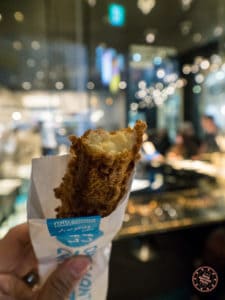
Zaku Zaku was introduced by a friend and they specialize in a unique take on the traditional cream puff that places like Beard Papa’s have been doing for a long time. What they make is something called a croquant chou which are French words for ‘crisp’ and the pastry used for cream puffs and eclairs. Zaku Zaku directly translates to crunchy.
Touting fresh ingredients from Hokkaido, this mashup of cream puffs and eclairs are made of almonds coated with sugar and egg white as well as a blend of Hokkaido-made flour with the cream centres made of milk. They’re all made in-house as they proudly display.
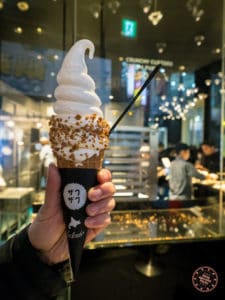
On top of the croquant chou, there’s also their soft-serve which is crowned by crunchy almond at the cone.
One thing you quickly learn in Japan that any dairy product branded as Hokkaido is instantly premium and for good reason because of the simple reason of how legendary their cows are treated which results in creamy and light milk. That said, I was surprised to see that everything was quite affordable here as I was definitely tempted to order more than one crispy cream puff.
Eating the croquant chou right away, I quite enjoyed mine. I think it’s much friendly form to eat compared to the traditional ball of a cream puff that always explodes as you eat it. The crisp is a nice element to it as it is complementary to the soft-serve which was very good. I can’t say it’s going to blow you away but definitely unique and will satisfy your sweet tooth.
There are several locations around Tokyo so make sure you to check to see if there are ones that are more convenient to you.
We showed up at 8PM on a weekday and there wasn’t much of a line. Even if there is one, it moves very swift as it’s very much a pay-and-go system.
When you’re done, think about booking a tour to learn more about the neighbourhood here with the Harajuku Kawaii Fashion & Pop-culture Tour where you’ll learn from a local guide what makes the pop culture here so unique. You’ll be able to have lunch in a crazy monster café and also walk through the nearby Meiji Shrine.
Neighbourhood: Harajuku Open hours : 10AM – 8PM M-Su Address : ( See map ) Price : Original soufflé pancake a.k.a. kiseki pancake plain (1,000 JPY – $9 USD) + matcha au lait (400 JPY – $4 USD) English menu?: Yes
3. Tsujiri (辻利)
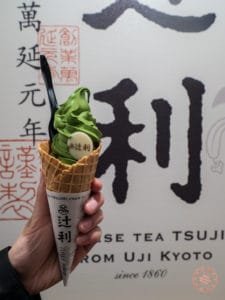
If there’s a #2 behind sushi when you think of Japanese food, I would put green tea in that spot. The most famous matcha comes from a region in Kyoto called Uji but if you’re limited to Tokyo, there are very few options for authentic and high quality tea. We were on the hunt for serious matcha ice cream and that’s when we stumbled upon Tsujiri.
Diving down to the basement floor of the newest department store in Ginza, you’ll be sounding out “ooh” and “ahh” at every turn. This is where you’ll find the highly respected tea shop. At first, we weren’t too interested as we only saw a loose leaf tea on display but we noticed a group of people intensely focused on a cone of matcha soft-serve on the benches.

On the menu is an assortment of matcha soft-serve based items but we were definitely most interested in having it in it’s purest form. They offer two types of soft-serve – the cheaper regular Matcha and the more expensive Extra Rich which is described to have “twice as much matcha as Matcha”.
Of course we went with Extra Rich and boy were we impressed. The soft-serve is smooth and creamy while packing extra strong Uji matcha flavours that is strongly but satisfyingly bitter.
The price between cone and cup are the same so why not go for the cone?
Neighbourhood: Ginza Open hours : 10:30AM – 8:30PM M-Su Address : ( See map ) Price : Extra rich matcha soft serve (584 JPY – $6 USD) English menu?: Yes
4. Angels Heart
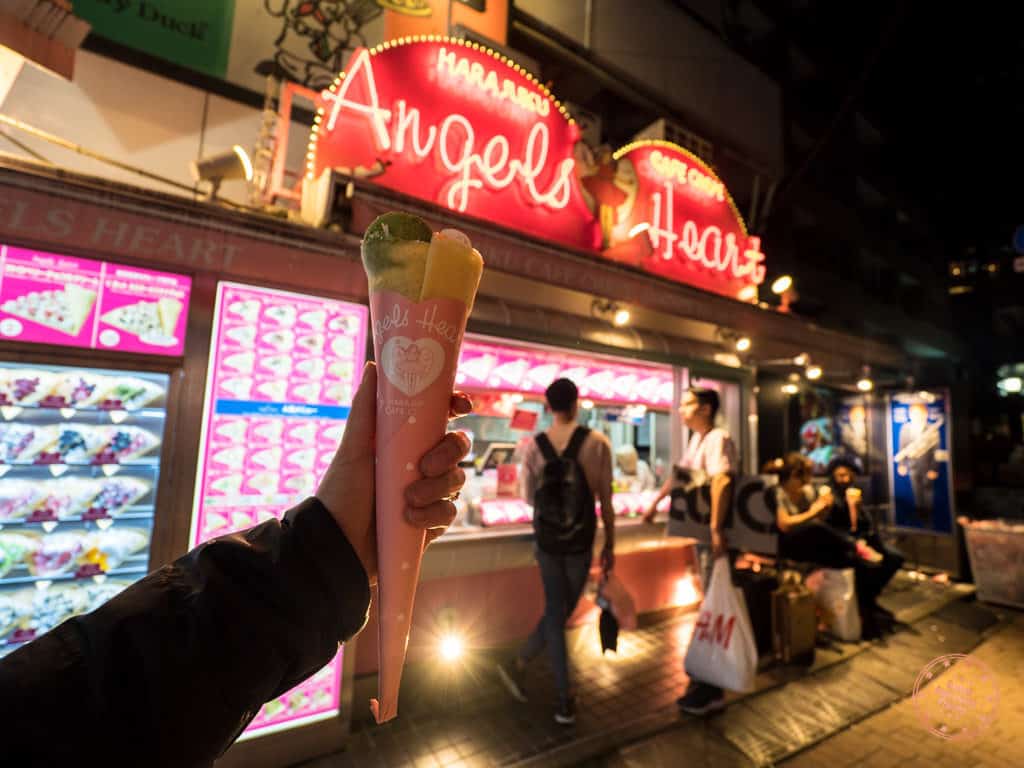
And you thought I was done with Harajuku! We discovered this on our first trip to Tokyo and it certainly wouldn’t be our last. Paired up with Zaku Zaku, we needed to make sure we had enough stomach room for one more dessert.
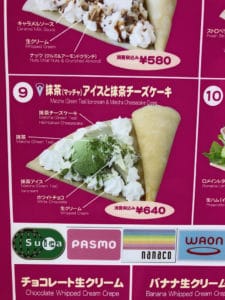
Long before croquant chou was even a thing, Harajuku was mainly known for their decadent crepes. It wasn’t enough just to just put Nutella and fruit on crepes as the French had done but they had to take it a step further and slam it with ice cream and cheesecake on top. It was so deliciously good that it’s a style of crepe in a cardboard cone holder that’s simply called the Harajuku Crepe.
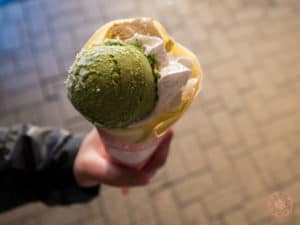
There are several stalls that serve this dessert but the one we always go back to Angel’s Heart which is in the middle of Takeshita Street. The walls are plastered with pictures of menu options and the one I highly recommend is the one with green tea ice cream and cheesecake.
Neighbourhood: Harajuku Open hours : 10AM – 9:30PM M-Su Address : ( See map ) Price : Green tea ice cream and cheesecake crepe (640 JPY – $6 USD) English menu?: Yes
5. Japanese Ice OUCA (食べログ)
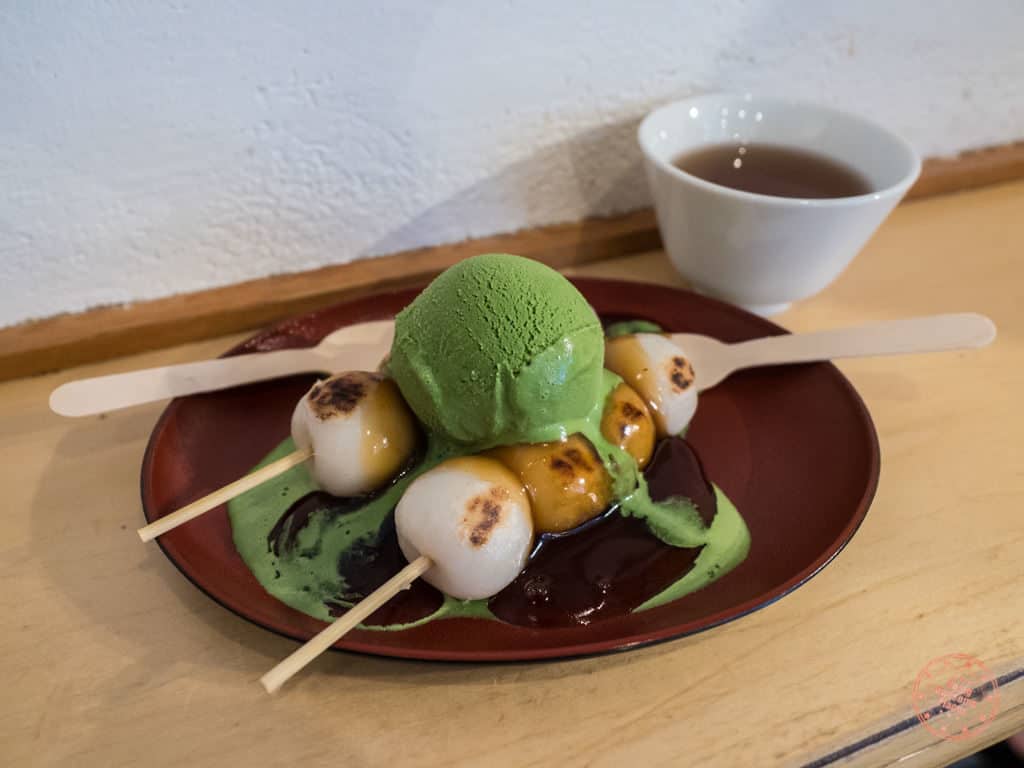
Last but not least is this ice creamery located at a busy intersection in the neighbourhood of Ebisu. In this small cafe, you’ll have your choice of ice cream and gelato – some of which are standard and others which are special based on the season. Everything is homemade.

Overloaded with choices in flavour, colour, and special options, we ended up picking the skewers of mochi (called dango) glazed in a soy syrup with their evergreen matcha gelato on top. An unorthodox combination? Yes, absolutely. I think both of us regretted the choice after as we found the salty-sweet combination of the soy glaze and the bitterness of the matcha to clash. The dango also wasn’t freshly made as we watched them just grill up pre-made ones so it didn’t have the elastic bounce I was expecting.
While the clash was strong, I thought the matcha gelato was excellent. Not as rich as Tsujiri but with a texture that could easily fool you as ice cream, it held up its own as some of the best ice cream we had in Japan.
If I were to come back, I’d stick to the basic cup of 3 selection ice cream.
Wheat green tea is complimentary if you’re eating in their limited-space cafe. Also, if you order one of their ice cream cups, it comes with kombu flakes to cleanse your palette after the sugar overdose.
Neighbourhood: Ebisu Open hours : 11AM – 11PM M-Su Address : ( See map ) Price : Dango with green tea gelato (400 JPY – $4 USD) English menu?: Yes
Places We Missed
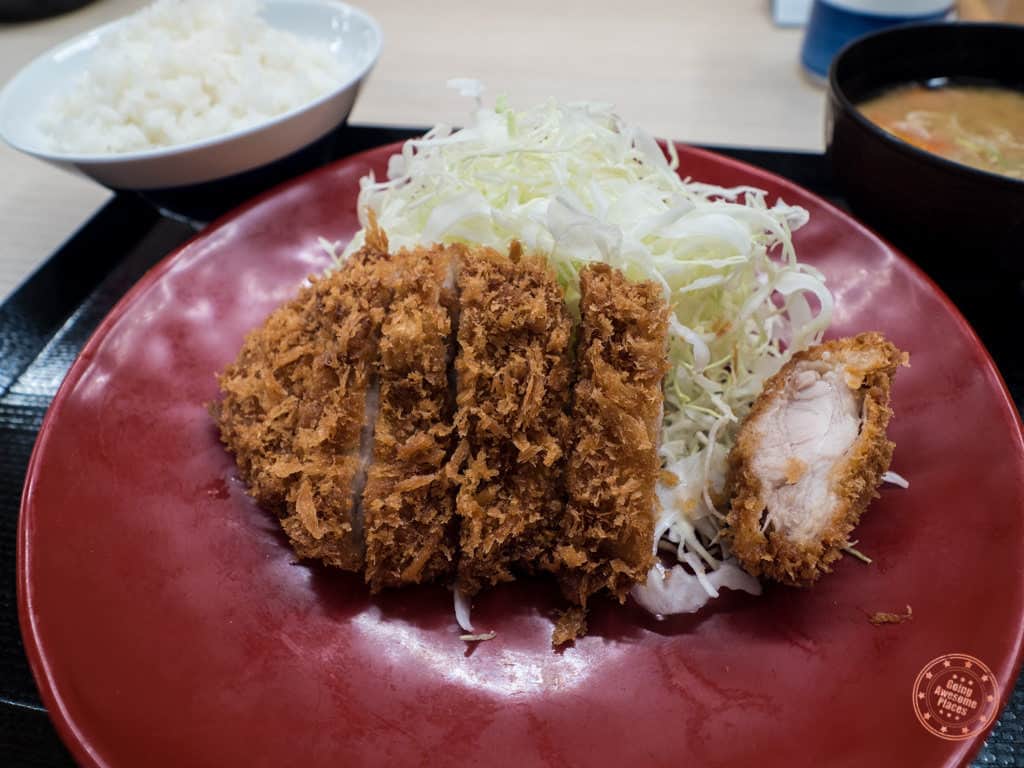
In 6 days I feel like we barely made a dent into everything Tokyo has to offer. As you plan out your foodie vacation, here are some of the other things you don’t want to miss out on.
Types of Food We Didn’t Get To
- Shabu shabu
- Japanese BBQ
- Steak (Waygu and Kobe beef)
More Places I Didn’t Feature
There are more restaurants that I wasn’t able to feature on this list but I did add them to the Tokyo Food Map . These include restaurants that we tried or ones that were in the plans but just didn’t have time or the stomach room for.
How much does 5 days in Tokyo cost?
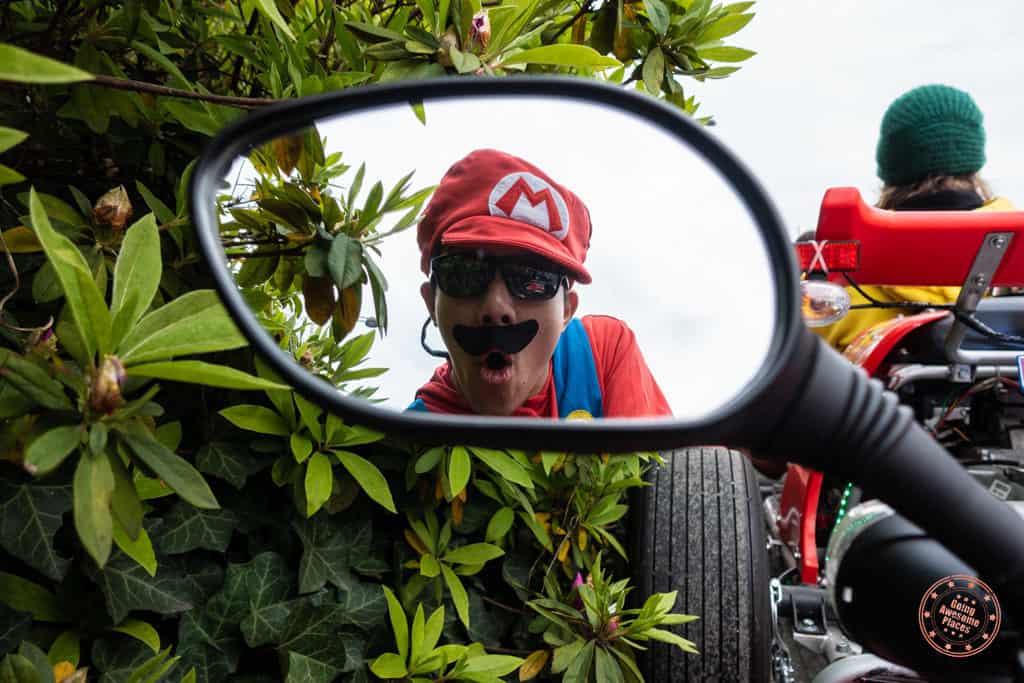
It’s no secret that Tokyo is one of the most expensive places in the world. I kept track of our expenses over the course of our 6 days in the city and here is a breakdown of how much we spent.
- Food : $437 USD
- Souvenirs : $294 USD
- Accommodation : $188 USD (6 nights at the Airbnb)
- Transportation : $99 USD (not including flights)
- Activities: $189 USD (mainly MariCAR)
- Currency: $4 USD (ATM fees)
TOTAL: $1,211 USD
This breaks down to $201 per day and furthermore $100 per day per person .
Food of course is where we spent the most money but from my list above, you’ll see we didn’t really splurge on any particular place which helped keep our cost low. We definitely ended up spending a bit more on souvenirs which can be broken down into our shopping at Daiso, Don Quijote, and the local supermarkets.
We saved a ton by going cheap on accommodations but that can easily balloon to $1,000 in Tokyo if you’re staying in the city .
There’s an endless amount of things to see, do, and eat in Tokyo. Our 6 days there was a blitz of food that resulted in intense exercise of our stomachs and our feet.
One thing is for sure, it did not disappointed. The most impressive thing is just how much care they put into every piece of food that is placed on the dish. Everything is there for a reason and it’s the combination of all the freshest ingredients and method of preparation that results in incredible dining experiences whether they’re on the street or in a fancy restaurant.
So what are you waiting for?
Looking for activity ideas in Tokyo?
Akihabara Anime & Gaming Adventure Tour – Akihabara is an awesome neighbourhood to explore that isn’t covered in this particular guide as somewhere with a specific restaurant to visit but if you’re a fan of anime, manga, maids, video games, and toys. This tour gives you a 3 hour interactive experience including going to a maid cafe, trying out a Japanese photo booth, and being shown the best spots for anime.
Read these next!
- Souvenirs you have to buy before you leave Japan
- Best ramen in Tokyo
- Must have food in Osaka
- Tips for getting around Tokyo by train
- Best ryokans in Kyoto
Thinking about a JR Pass?

If you’re looking to do any travelling around Japan, I highly recommend picking up a JRailPass . Keep in mind that you’ll need to purchase it before your trip and ship it to your home.
About William Tang
William Tang is the Chief of Awesome behind the award-winning Going Awesome Places which is focused on outdoor adventure, and experiential travel. His true passion lies in telling stories, inspiring photography and videos, and writing detailed itineraries and travel guides. He is a member of Travel Media Association of Canada (TMAC), Society of American Travel Writers (SATW), Adventure Travel Trade Association (ATTA), and Travel Massive. He has also been featured in publications such as Reader's Digest, Entrepreneur, Men's Journal, and Haute Living. Make sure to learn more about William Tang to find out his story and how Going Awesome Places started.
Find us on social media
The 7 Best Tokyo Food Tours [2024 Reviews]
Tokyo is famous for its technology, Anime, and video games, but it’s also one of the best foodie cities in the world.
From fresh seafood and ramen, the food scene has a healthy respect for tradition while still honoring experimentation and the fact that it has such a multicultural population. However, there are SO many eateries that it’s hard to find some of the best ones outside of touristy locations.
That’s why I’ve decided to carefully select the 7 top Tokyo food fours – all the food tours in Tokyo that are well worth your time and money! Let’s jump right in!
Be sure to see our reviews of Mt Fuji Day Trips , Mario Cart Tours and Sumo Experiences .
Best Food Tours in Tokyo
Quick answer: the 7 best tokyo food tours for 2024.
- Best of Shibuya Food Tour
- Izakaya Food Tour in Shinjuku
- Shibuya Bar Hopping Night Food Walking Tour in Tokyo
- Shibuya All You Can Eat Food Tour Best Experience By Local Guide
- Shinjuku Omoide Yokocho, Kabukicho and Golden Gai Food Tour
- Tsukiji Fish Market Food and Culture Walking Tour
- Tokyo by Night: Japanese Food and Drinks Experience
Best Tokyo Food Tour Reviews
1. best of shibuya food tour.
- Duration: 3 hours
- Departure: 2 Chome-1 Dogenzaka, Shibuya City, Tokyo 150-0043
- Departure Time: 4:00 PM
- Includes: Local guide, One drink included, 5 Food Stops, Dessert included
My first time in Tokyo was such a whirlwind, with seemingly endless activities to partake in, and so much to see! Pair that with the fact that I speak very limited Japanese, and I was grateful that this next tour existed.
The Best of Shibuya Food Tour took us on an adventure right through one of the city’s most lively, popular neighborhoods and taught us all about Japanese cuisine!
We met our guide right in the middle of Shibuya, and they instantly put me at ease with their calm and friendly personality along with their clear expertise on the subject.
I’d seen a bit of Shibuya before, but this was a much more immersive experience that felt like I had a friend leading the way.
Through the bustling streets and hidden alleyways, the vibe from the people and smell of delicious food wafting through the air was enough to make me completely enamored with this area.
We went to 5 different food stops, we were able to enjoy a nice selection of national dishes, from Hiroshima-style okonomiyaki, to various fresh sushi, yakitori skewers, and more!
Expand To See More See Less
We went through a maze of eateries at an underground food hall, which made it feel like we were in some sort of movie!
Of course, no visit to Shibuya is complete without seeing the famous crossing, which reminded me a lot of New York City’s Time Square!
As we ended around 7 pm, it was the perfect time to enjoy the local nightlife afterward, with plenty of cool recommendations from our guide! It was a fantastic way to acquire a solid understanding of national cuisine, as he told us all about the different regions.
I highly recommend it if you’re looking for some background on Japan, tons of fun, and even more good food!
More Information & Tour Booking
100% refund for cancellations within 24 hours of tour experience, other experiences you may enjoy:, 2. izakaya food tour in shinjuku.
- Duration: 3.5 hours
- Departure: 1-chōme-2-1 Kabukichō, Shinjuku City, Tokyo 160-0021
- Departure Time: 5:00 PM
- Includes: Guide, 7 different dishes at 3 izakayas, alcoholic beverages, small-group tour
When it comes to food tours, I feel like the only way to really enjoy the full experience is for it to be in a small-group setting.
That’s the case with the Izakaya Food Tour in Shinjuku , where your group is limited to a maximum of 20 participants for a customized, intimate experience.
Known for its entertainment district, there are tons of restaurants and bars within Shinjuku worth visiting, and your guide will take you to the best of the best.
Shinjuku is a place I hadn’t yet really seen yet, but I was very interested and intimidated by the nightlife scene there.
Our guide instantly made me feel more comfortable exploring the area, taking us to many cool, neon-lit locales that made me feel like I knew exactly what I was doing.
We had a pretty small group, but that was also the perfect opportunity to chat and get to know other travelers who were new to the area.
After our initial meeting, we then went to a few different local izakayas in the neighborhood, which is essentially skewers and small cuts of meat, fresh seafood, and veggies, along with bigger “signature” dishes.
Our guide explained it all to us, as well as plenty of sashimi, gyozas, sake, beer, and even some “special” cocktail drinks that were so delicious and refreshing.
Our guide did a fantastic job answering any and all questions that we had in a patient and friendly way.
I had a fantastic time walking through the downtown area known as “Kabukicho”, which is all of Tokyo’s biggest and most vibrant district for entertainment.
You’ll find everything from prehistoric reptiles to neon samurai shows, so expect the unexpected! If you’re looking for a fun time all while learning about and trying new food, this is definitely the tour for you!
3. Shibuya Bar Hopping Night Food Walking Tour in Tokyo
- Departure: Japan, 150-0042 Tokyo, Shibuya City, Udagawachō, 216, Q Front, 1F
- Departure Time: 6:00 or 7:00 PM
- Includes: 4 drinks & 3 dishes or 3 drinks & 4 dishes, enough for a full dinner meal. (Vegan menu available), Hopping 3 local izakaya bars with a local guide, Photos during the tour
I always recommend this tour to those who are visiting Tokyo for the first time or those who are short on time and want to maximize their sightseeing and eating!
After all, I was able to try tons of bars I would’ve otherwise never even experienced without this tour! The Shibuya Bar Hopping Night Food Walking Tour in Tokyo is perfect for everyone with just about any type of diet, including vegetarian and vegan!
This thrilling adventure is a few hours full of cultural immersion and discovery of new foods, led by a knowledgeable guide who is a local to the area.
Ours was very passionate and full of fun facts about the different areas and dishes, and clearly knew the best places to go to!
I had no idea just how dynamic the food culture was here, and we were able to try everything from savory yakitori skewers and rich bowls of hot ramen to crispy tempura and fresh sushi.
This was so much fun, being able to go through all kinds of cool eateries highlighted with neon signs, and some of them were even in a kind of underground labyrinth!
Most of the bars were izakaya-style, which are basically devoid of tourists and served some of the most amazing food and drinks I’d ever tried in my life. My favorite part may have been the entire floor of a massive building that is filled with various bars and pubs – no tourist traps in sight.
Our guide was so sweet and made sure we made plenty of stops for photos and videos, including a stop at the world-famous Shibuya crossing!
If you’re looking for a fun way to fill up your schedule or want an exciting alternative to dinner at just one restaurant, this is it! Our guide even included plenty of recommendations for us to try over the next couple of days, completely transforming our trip!
4. Shibuya All You Can Eat Food Tour Best Experience By Local Guide
- Duration: 4 hours
- Departure Time: 11:00 AM or 5:00 PM
- Includes: Sushi, yakiniku, chicken karage , takoyaki, 2 soft drinks and water, Desserts, City walking & culture tour, Professional guide.
The busy streets of Shibuya can be a bit intimidating to navigate, even if you’re native to the area! As tourists, it can be a bit stressful if you don’t know what you’re doing, so it’s a huge relief having a local guide lead the way.
With the Shibuya All You Can Eat Food Tour Best Experience by Local Guide , you’ll get to appreciate every corner of the iconic neighborhood in a way where you don’t have to worry about where you’re going.
This is the longest tour of all of those I’ve curated for this guide, as it does offer a bit more in regards to the walking and culture tour.
With that being said, be prepared for quite a bit of eating and walking, so put on a pair of comfy walking shoes and bring a jacket as it can get chilly at night!
With a small-group tour setting of no more than 10 participants allowed, this intimate tour makes it feel like you’re just cruising around with a little group of friends.
We met up with our guide right in Shibuya, which was luckily easy to find and we set off onto Shibuya 109 which is a local street known for its amazing food!
Not only that, but many fashion trends start here so you can count on many young fashionistas cruising the streets for the newest trends.
It’s all very interesting and unique to Tokyo, with our guide offering us educational commentary about the area to understand the culture a bit better.
We also headed into a hidden alley that many locals frequent thanks to the cool bars and restaurants found here, though I realized very few tourists actually knew about it! We then took photos at Shibuya crossing, which is the busiest crossing in the entire country!
All of this and we got to try delicious food while chatting about Japanese culture – not a bad way to spend an evening!
5. Shinjuku Omoide Yokocho, Kabukicho and Golden Gai Food Tour
- Departure: 1-chōme-2-6 Nishishinjuku, Shinjuku City, Tokyo 160-0023
- Includes: Local guide, two drinks included, 4 food stops
Shinjuku Golden Gai is a legendary district made up of various passageways lined with hundreds of little shanty-type bars, clubs, and restaurants packed together.
It’s a place unlike any other in the entire world, with ramshackle buildings and dimly-lit walking areas that look a bit “scruffy” but are absolutely amazing! The Shinjuku Omoide Yokocho, Kabukicho and Golden Gai Food Tour cover all that and much more!
This tour offers one of the most unique opportunities to see Golden Gai, which for some reason I’ve noticed is not commonly covered in Tokyo food tours.
With its cozy bars and narrow alleyways, it is like a journey back in time to the “old” Tokyo, which is really cool to see. After all, you can’t truly appreciate the present-day until you know where its culinary heritage begins!
After meeting up with our guide, we made our first stop at Omoide Yokocho which features bars that have stayed essentially the same for nearly 100 years!
We then made our way to Kabukicho, which is not only the biggest Red Light District in Asia, but is also known as the safest. In Kabukicho, we took a break to try two different dishes – my favorite being a bowl full of savory ramen!
Once in Golden Gai I was completely in love with the lively environment, with locals who were surprisingly very friendly and welcoming to our group.
We sipped on some tasty drinks and tried a few different dishes before we stopped at a karaoke bar and had a ton of fun! This is one of my favorite tours I’ve ever taken anywhere, so if you want my advice, just sign up now!
6. Tsukiji Fish Market Food and Culture Walking Tour
- Departure: 3-chōme-15-1 Tsukiji, Chuo City, Tokyo 104-8435
- Departure Time: 8:30 AM
- Includes: Local professional guide, food, snacks
This next tour is quite a bit different than any other on this guide, starting with the fact that it departs in the morning! The Tsukiji Fish Market Food and Culture Walking Tour is an adventure that highlights all kinds of fascinating finds!
Tsukiji market had been operating for nearly 100 years and was built to replace the older market before it that was destroyed by a massive earthquake.
While the inner market has since been moved, the outer market is still around in the same location and is right next to the opulent Ginza area that’s also fun to explore.
This is a great opportunity to see inside the famous site, where you’ll get to learn about its history and why so many of the country’s top chefs come here daily to purchase the highest-quality ingredients around.
I’ve seen some seriously eye-opening things here – things that you probably won’t be able to find anywhere else in the world!
We started by meeting our guide in from of the Tsukiji Honganji Temple gate early in the morning, heading to the biggest fish market in the country.
We learned how many Michelin-star restaurants in Tokyo source their ingredients from here, and it’s easy to see why. We walked around, sampling all kinds of traditional Japanese foods, like fried fish cakes and Katsuobushi, as well as some drinks.
There are so many little food stands and shops to purchase from, that if you haven’t gotten souvenirs already, this is the perfect place to snap some up.
Our guide was so knowledgeable about the market itself, as well as the local food, that you’ll gain a whole new appreciation for Japanese culture. With tons of good eats, lots of learning, and lots of laughing, this is a truly special experience I feel everyone should have!
7. Tokyo by Night: Japanese Food and Drinks Experience
- Departure: 4-chōme-6-16 Ginza, Chuo City, Tokyo 104-8212
- Includes: Local guide, 3 local food tastings and 2 drinks, 2 subway tickets
Last but certainly not least, is the Tokyo by Night: Japanese Food and Drinks Experience tour ! It’s one of the more affordable experiences of its kind, immersing you into the mesmerizing allure of the city at night.
Led by expert guides who are passionate about their city and its cuisine, it will take you through bustling streets from Shinjuku to the sophisticated neighborhood of Ginza with a delicious array of delicacies!
We met up with our guide at Yurakucho Station which was easy to find, answering our questions and offering a briefing of what to expect before we got started.
We strolled through Yakitori Alley, which is filled with more casual restaurants offering savory yakitori skewers. You have to try it in the housemade sauce for maximum tastiness with a sake to wash it all down with!
After that, we explored around some more, taking in all the sights and sounds of Tokyo’s exciting nightlife scene before arriving in Monja Street.
Here, we tried the famous type of fried pancake called “monjayaki”, which I instantly fell in love with. I’m a huge fan of pancakes and French toast, and I would love to have something like this for brunch (or really, any hour of the day).
When we got to Ginza, I was super excited as it was filled with so much going on, from top-notch clubs to more local restaurants and fun shops to grab souvenirs at.
Our tour guide did a great job at telling us about the history behind the different places, though I did wish we would’ve visited a stop or two more for food. Overall, it was a wonderful night out with a local who knew the city like the back of his hand!
Foods Tasted
Tour guides.
The Best of Shibuya Food Tour is our Editors Choice for the best Tokyo food tour.
Robert Baker
Related articles, the 5 best mt fuji day trips from tokyo [2024 reviews], 🏯 the 5 best private guided tours of tokyo [2024 reviews], the 5 best mario kart tours in tokyo [2024 reviews], the 5 best tokyo sumo tournament experiences [2024 reviews].

10 BEST Food Tours in Tokyo, Japan
This post contains product affiliate links. These are mainly on items/hotels/tours that I personally endorse & love. I may earn a small commission if you make a purchase, but at no extra cost to you.
Looking for the best food tours in Tokyo? From exploring Tsukiji Fish Market to a ramen tasting tour, it’s time to experience Japanese food!
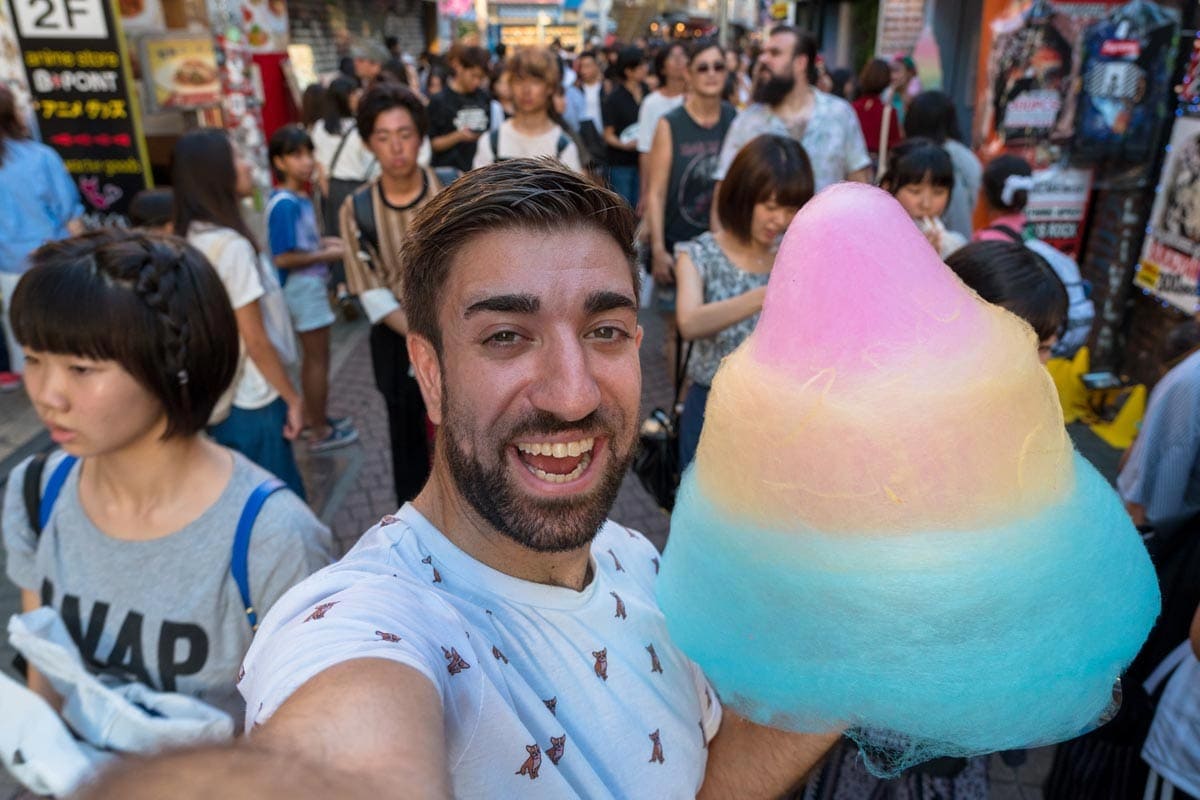
Tokyo , the world’s largest city with 38 million people calling it home, is an eclectic, electric city full of culture and customs.
With its bright lights and cacophony of sounds, Tokyo is a city like no other and you can almost feel the buzzing atmosphere.
However, the city can be more than a little intimidating for first-time visitors (that’s how I felt!) That’s why I really recommend going on a food tour in Tokyo to get a feel for the city.
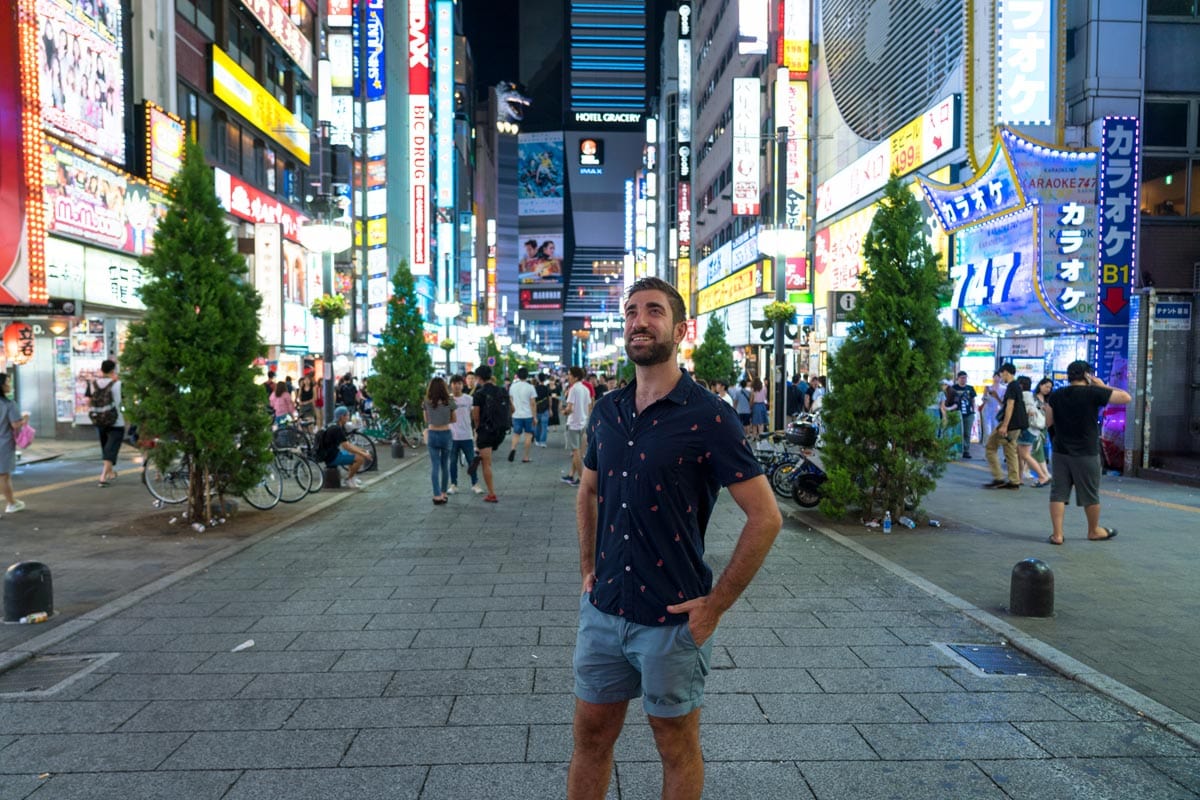
Whenever I get somewhere I’ve never been before, I always go on a food tour. I find they’re the best way to learn about a city through its food – if there’s a better way I don’t want to know about it!
And Tokyo is the perfect place for a food tour. Not only do you get to try dishes like sushi, ramen, and other delicacies, but you get to learn all about Japanese food culture and the customs that come with it.
On my Tokyo food tour, I learned about 72 things just to do with chop-sticks, and that was just chop-sticks. For me, this was the perfect way to prepare for my two weeks in Japan – I really learned that much.
So, if you want to eat your way through the city and find out where some of the best restaurants are along the way, then check out some of the best food tours in Tokyo.
Oh, and make sure you turn up hungry because you’re going to eat a lot!
Are you a fellow foodie who likes to get to know a place by their taste buds? Check out my food guides of Bangkok , Hanoi , Istanbul , Rome and M arrakesh !
Tokyo Food Tours
Tsukiji fish market tour.
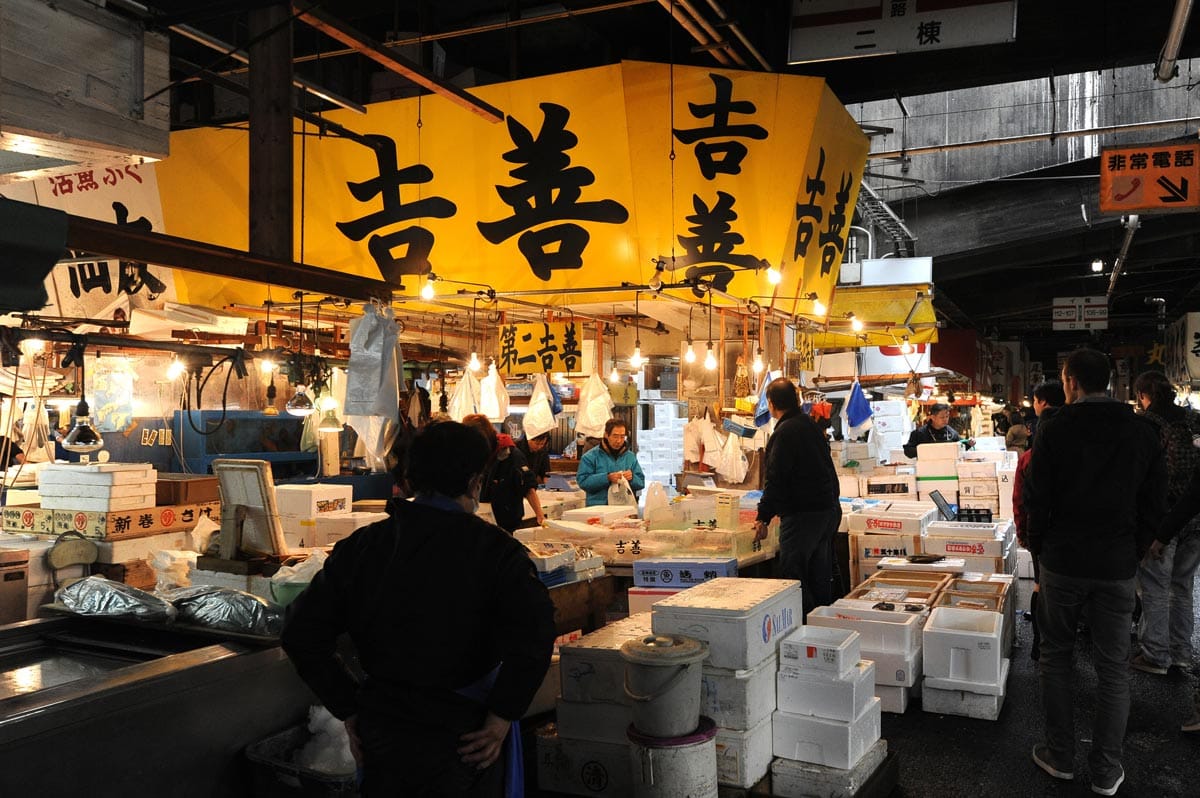
This is a 3-hour Tokyo food tour will really give you an insight into Japanese food. Just get ready to be dropped in at the deep end at the bustling Tsukiji Fish Market. Thankfully, there’s an amazing tour guide on hand to help you through this maze of fish stalls and people.
At Tsukiji Fish Market you can try all the fruits of the sea. Expect delicacies like bonito, sushi, fresh tuna, and local omelets cooked with fish. You’ll also learn all about the history of the market and the cultural significance of seafood in Japan.
Start the day by dining and shopping just like a local at Tokyo’s famous Tsukiji Market. You’ll quickly see why the best Japanese chefs shop here for the freshest ingredients.
Explore the plethora of seafood stalls while flitting between boxes packed with sea urchins. Observe busy vendors carving huge bluefin tuna and spot nervous pufferfish floating in tanks.
The tour ends with a visit to a genuine sushi restaurant for a serving of the best fresh sushi before heading back to Tsukiji Station. This is one of the most popular food tours in Tokyo, and it’s perfect for those who adore seafood!
Tokyo: Sushi Making Class

Obviously you can’t come to Tokyo without eating sushi. Better yet, eat it after you learn how to make it!
One of the things I really love about making sushi is you can go wild with different flavour combinations. For me, that means lots of spice an chilli.
After learning the basics of sushi making, the sky is the limit for creatively inventing new sushi recipes with local ingredients. At the completion of this class, you will enjoy the excellent sushi that you made along with miso soup.
In this class you will get step-by-step instructions on how to make delicious and attractive sushi. And trust me when I say this, it’s a lot easier than it looks.
During this hands-on cooking lesson you’ll learn how to make eight or nine different kinds of sushi while spending an afternoon with friendly locals in an informal atmosphere. You’ll also learn proper techniques on how to make tasty sushi rice.
This class is taught by local female instructors, all of whom speak English. A number of different common types of sushi will be covered in the class, including inari, nigiri, and sushi rolls.
As this is always a small group tour, you’re guaranteed one-on-one assistance from the instructors. That means you’ll have plenty of opportunities to ask questions too.
Shinjuku After Dark Izakaya Tour
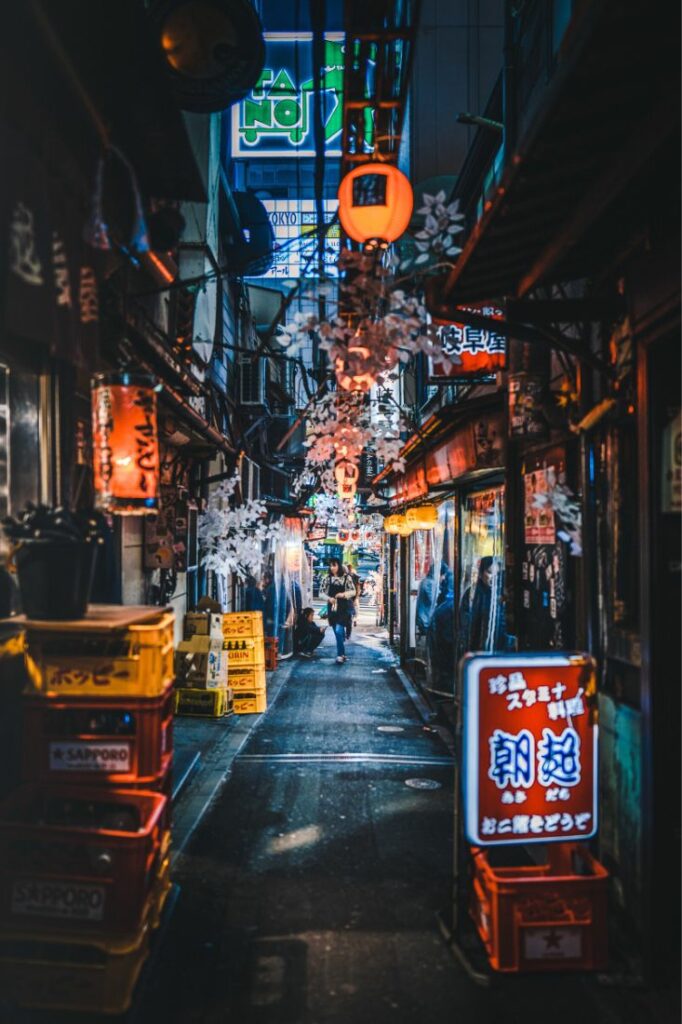
Tour guide Yoshi has experienced a lot of “tourist traps” in Japan and started his tour company to provide visitors a unique experience. He’s picked some of the best spots to enjoy Shinjuku nightlife on the Shinjuku After Dark Izakaya Tour.
He’ll take you to the best late-night food and drinking spots in Tokyo, including izakaya (Japanese gastropubs) in the notorious Kabukicho and classic Omoide Yokocho street. Enjoy yakitori and drinks while bar-hoping with a fun group!
This is one of those Tokyo excursions that you’ll remember for a long time (depending on how much sake you have of course!). It’s a bit like a Tokyo street food tour, but with bar hopping including too.
Tokyo Kaiseki Cusine Cooking Class
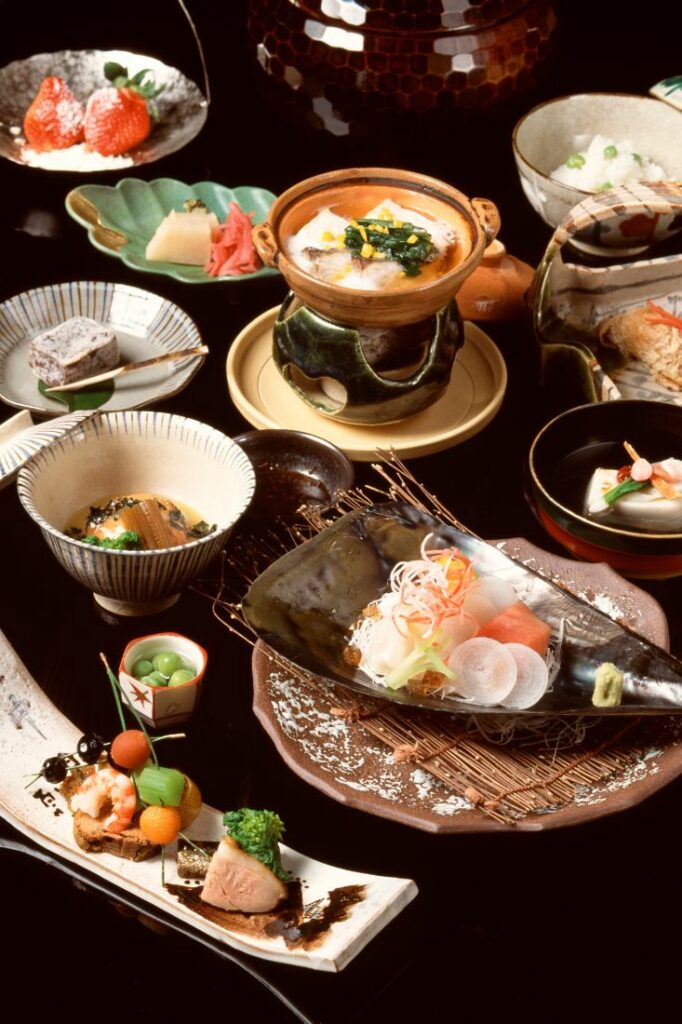
One of the best ways to experience local food is to learn how to make it in a local cooking class! Kaiseki is a traditional multi-course meal in Japan. It features individual dishes made from seasonal ingredients, and is both aesthetic and delicious!
With English step-by-step instructions, the chef breaks down the process of making kaiseki dishes, making them accessible for beginners and families. Once everything is prepared, you’ll get to enjoy a full kaiseki feast!
If you really want to learn all about Japanese food, then this is one of the best food tours in Tokyo for that.
Traditional Japanese Sweets, Wagashi & Mochi Class
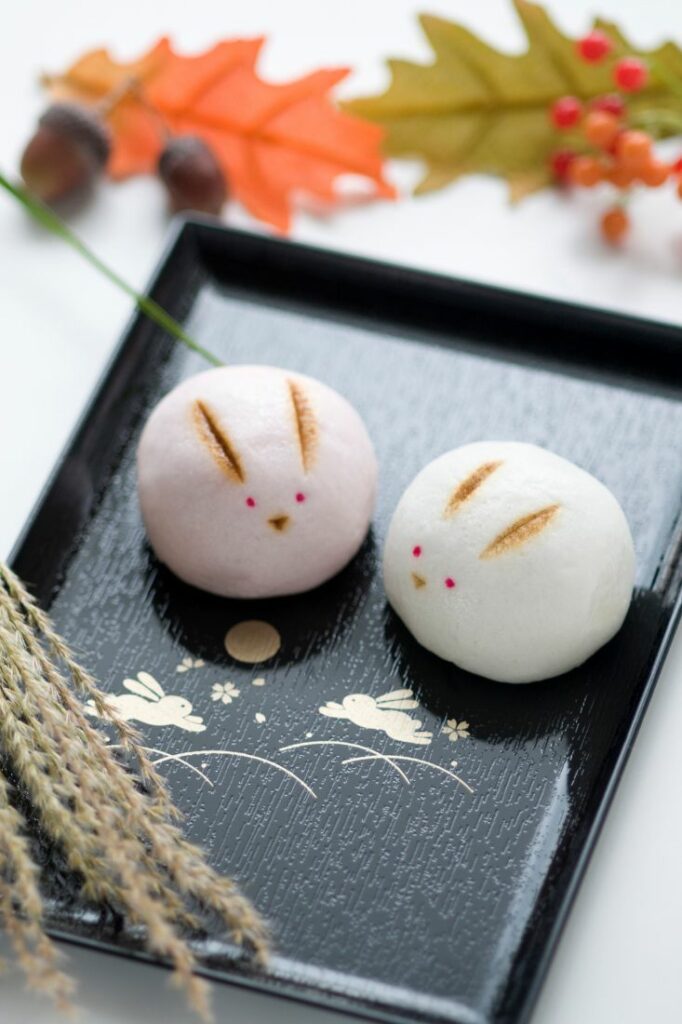
Wagashi are traditional Japanese sweets that are naturally vegan and gluten-free. You’ll make three different types of Japanese sweets, including mochi, the classic chewy rice cake. The sweets are shaped to reflect different seasonal motifs, and are as beautiful as they are tasty.
After making the sweets, you’ll learn how to make a bowl of matcha green tea. The matcha goes perfectly with the wagashi, and you’ll enjoy both after the class.
Tokyo Ramen Tasting Tour
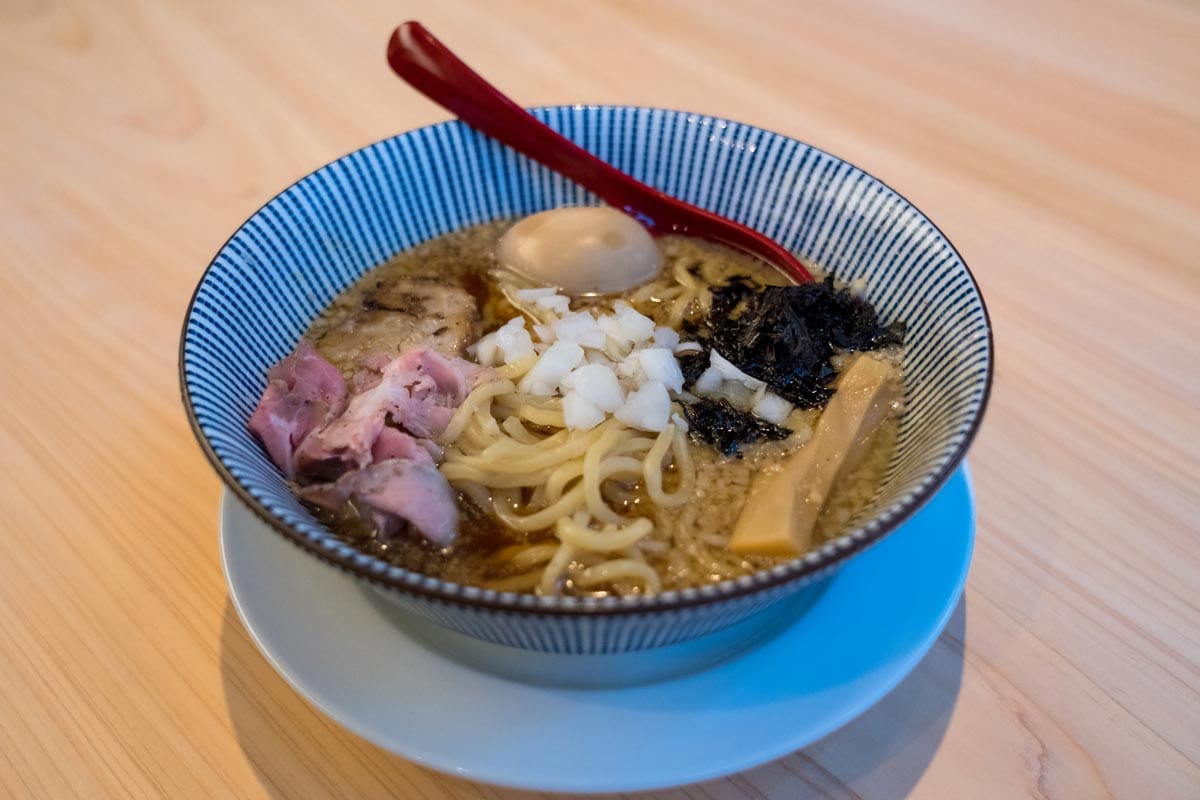
When it comes to the best food in Tokyo, ramen is always at the top of the list. Well, this is your chance for you to enjoy and experience ramen like a Tokyo native during this 3-hour group tour.
You will learn about the history and culture of this exciting dish, and then eat your way through six bowls of ramen. Yes, you read that right – six bowls of ramen!
The tour will take place in three unique Tokyo neighborhoods, including Shibuya. As part of this experience you will be given insider tips on the best ramen restaurants and tips to increase your enjoyment of ramen, learn about the history and different types of ramen, as well as how it is prepared, be exposed to how ramen is enjoyed locally, learn what makes good ramen, and select and enjoy a delicious bowl of ramen at a local restaurant suggested by a ramen expert.
I think this is one of my favourite food tours in Tokyo, so I really hope you check it out.
Tokyo’s #1 Family Food Tour Around Asakusa
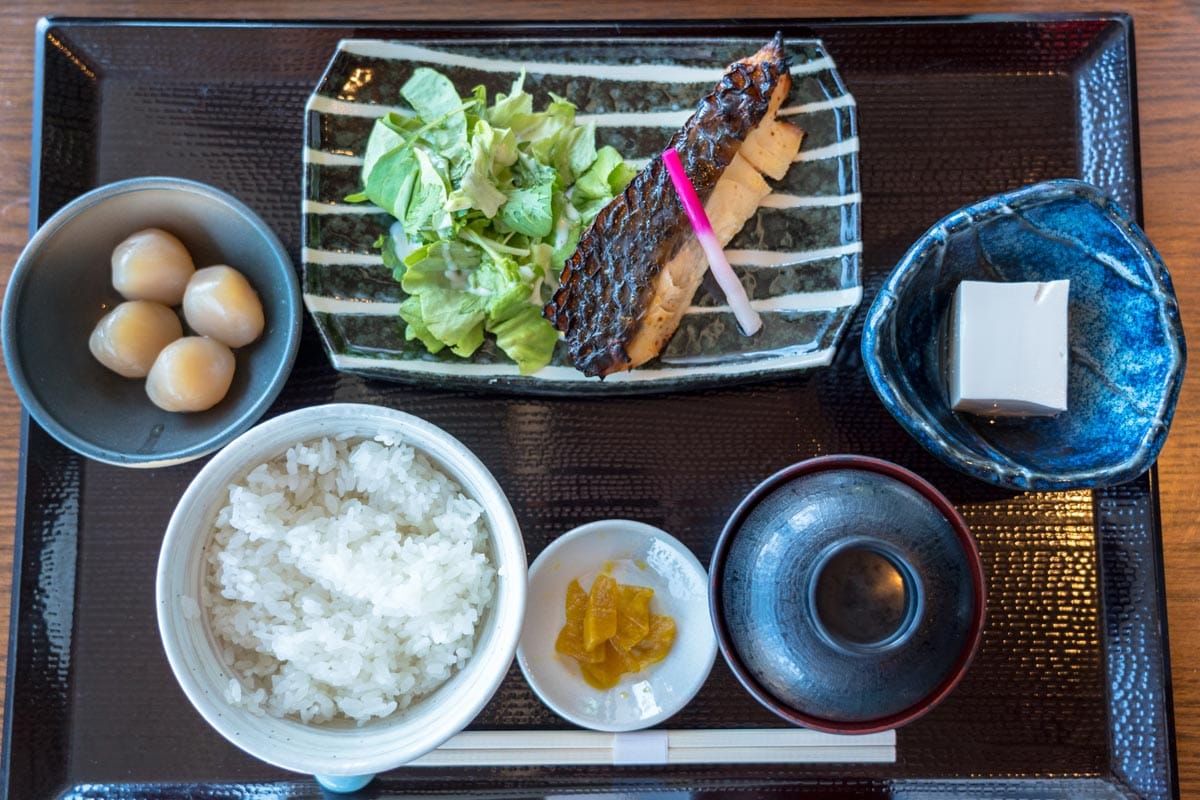
Asakusa, with its Sensō-Ji Buddhist temple and popular May Sanja Matsuri festival, is an area that positively vibrates with excitement. This is one of the most popular places to visit in Tokyo so expect it to be busy busy busy.
This was the Tokyo food tour I went on when I first arrived in the city and I LOVED it! I found it so useful and our local Tokyo food guide was incredible. I can’t tell you how many questions I asked him over the 3 hour tour.
We went though the history of Asakusa and why food is so important to Japanese culture. He was the one who taught me all about chop-sticks too. For example, you should never stick your chopsticks upright in a bowl of food as it’s means death and is very disrespectful.
This tour begins with an overview to Asakusa. This means you get to explore Namise Street while tasting popular Japanese delicacies like pickles, rice crackers, Japanese plums, and melon bread (made with a secret recipe!) along the way. You’ll also learn about pilgrims who have visited this area for over a thousand years.
The highlight of this Asakusa food tour is lunch. One thing I quickly learned was the Japanese love eating and lunch was a proper feast.
Depending on the time of year, lunch is often at the Tsukiji fish market. This is where you can try the freshest sashimi you’ll ever in your life. You’ll also learn about food customs with top tips on how to order food.
Other stops on the 3-hour tour include a visit to the theater, the side streets, and sampling specialties of Japan. Enjoy a popular pastry that has been made by a dessert shop since 1945 using a traditional candy making method. Oh, and obviously there’s lots of matcha tea too!
Shinjuku Golden Gai Night Tour
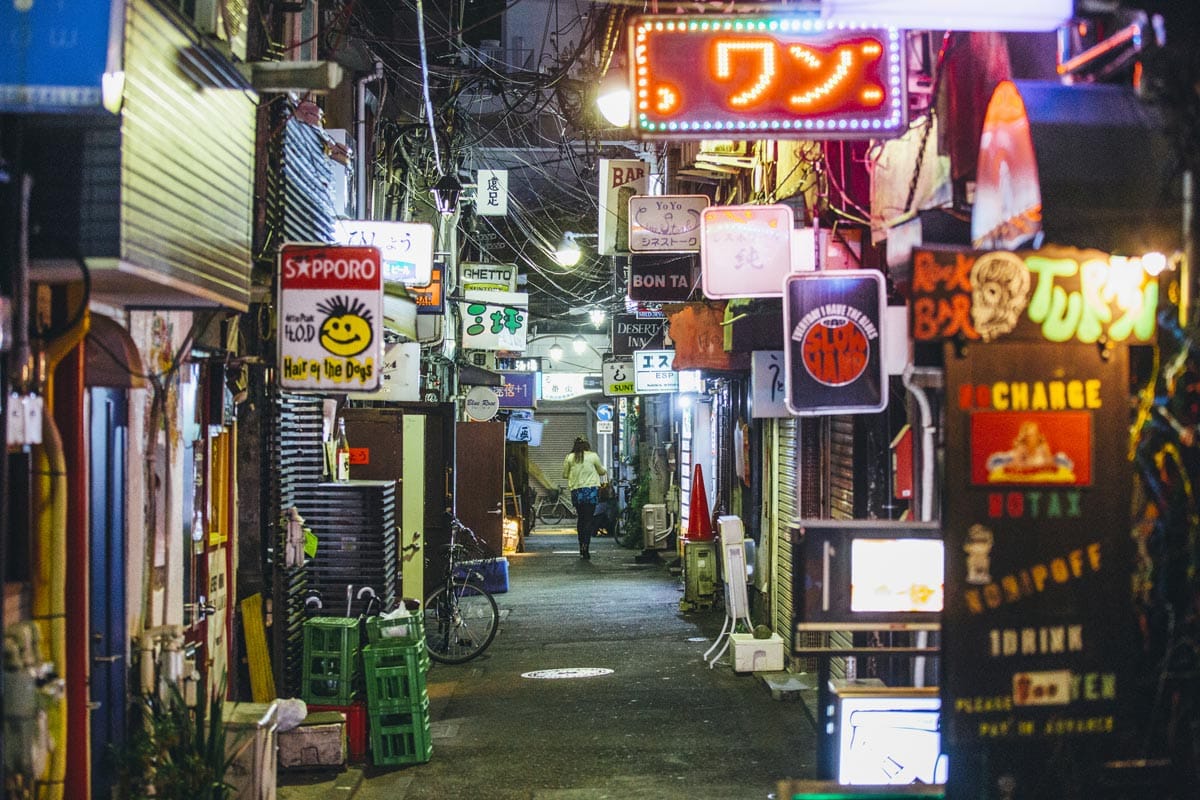
Those looking for a wilder ride can take a night walk with an established guide in two of Tokyo’s most notorious areas – Kabukicho and Shinjuku Golden Gai. For those looking for a beer and a bit of a party, this is the one for you.
Tokyo nightlife is like few places on the planet, and the heart of the experience can be found in Kabukicho. This is an area comparable with the red light districts of Europe but you know, different. However, Kabukicho is much cleaner and safer than its given credit for, and you’ll soon be enjoying the Tokyo nightlife like a local.
On your Tokyo street food tour you discover some of the best Japanese dishes – delicious ramen, okonomiyaki, yakitori, udon, takoyaki, soba, sashimi, tempura, and a load of others too. By the end of the night, you’ll be an expert.
Afterward, you’ll zoom through the streets to Shinjuku Golden Gai. This was one of my favourite areas in Tokyo and it’s always buzzing.
Golden Gai is a full of narrow, winding alleys and mysterious taverns and pubs. This is where a guide becomes essential – you’ll quickly find the best hidden gems in Golden Gai.
Sake Tasting Experience
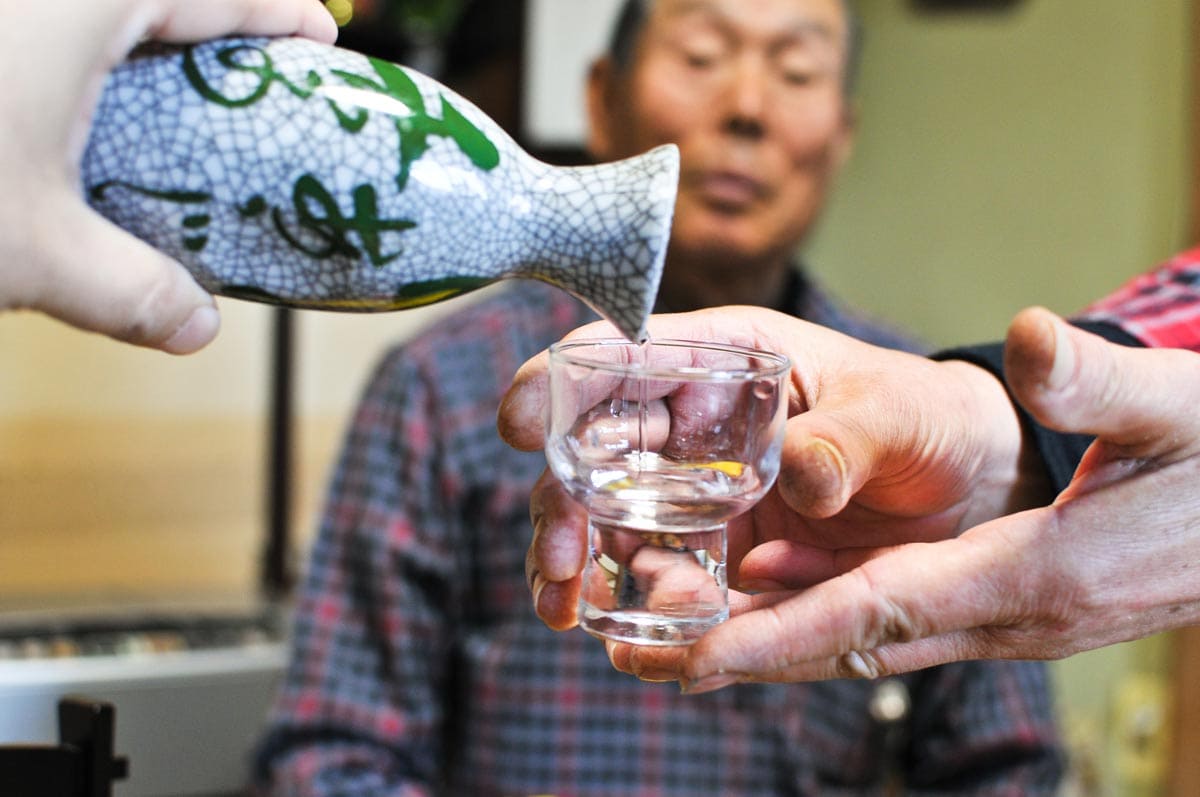
Now it’s time for some sake! I have to admit, I developed a bit of a taste for sake while travelling around Japan. I can’t say I know too much about it though which is why a sake tour is perfect.
This tour is all about experiencing Kikizake. This is the process of judging the color, aroma, and taste of sake in a similar manner to how sommeliers taste wine. While blindfolded, you’ll sample different brands of sake and attempt to identify them – and yes it is hard!
During the tasting you’ll select 7 different types of sake from 20-30 different varieties for sampling. If you enjoy a particular type of sake that you have tasted, you can order it at the end.
Sake comes in many varieties, amount of alcohol, and degrees of dryness. It can also be served warm or cold (warm was my fav).
If you already have a particular inclination for the types of sake you would like to sample, you can let the guide know ahead of time so that we can select sake that matches your taste.
Learn to Cook Japanese Vegetarian Food
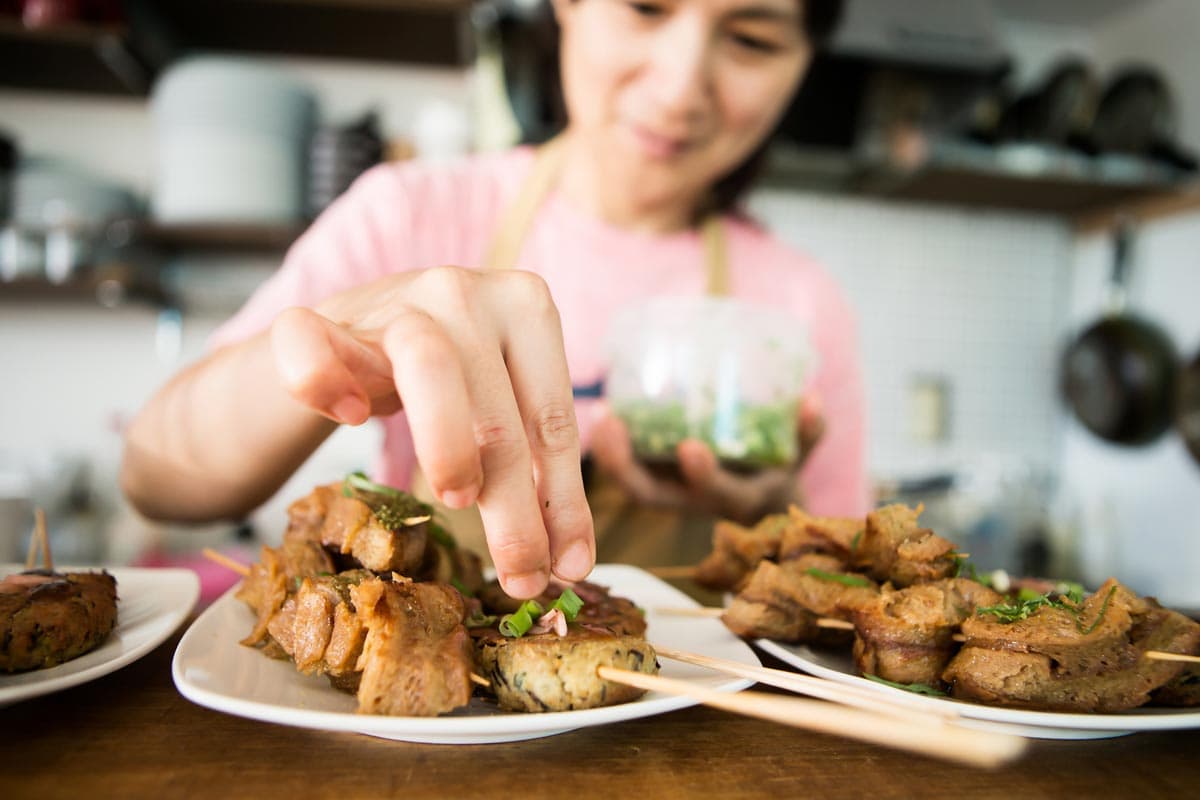
This is without a doubt one of the best Tokyo food tours. If you’re interested in learning more about the Japanese vegetarian lifestyle, this experience offers the opportunity to learn how to cook a Japanese vegetarian course menu of four or five different dishes.
The dishes include hijiki with creamy citrus sauce, brown rice with mizuna, persimmon gelee, steamed azuki and pumpkin, and lotus root fried ball. All the recipes featured in this course follow macrobiotic theory and include no meat, fish, white sugar, chemical products, or eggs. Basically, this is perfect for vegans and vegetarians!
Included in this class are also lessons offering instructions on how to arrange different types of vegetables and bread to make them more aesthetically pleasing. The table will be arranged with Japanese pottery or white porcelain with beautiful bouquets and tasteful table linens.
Classes are available on Saturdays and Sundays. They last three hours and there are two each day, one from 10:30-1:30 and one running from 4:30-7:30.
These classes are for women only and any males interested should bring a female such as a spouse, friend, or family member. That’s just the way it is I’m afraid!
To learn more about the cuisine before your trip, check out this amazing podcast all about Japanese food . They talk through some of the most popular dishes you’ll find in Japan, and it’s a great overview.
So, out of the best food tours in Tokyo, which one catches your eye? I would love to know which one you’d go on so let me know in the comments below!
Like this blog post? Then make sure you Pin it!
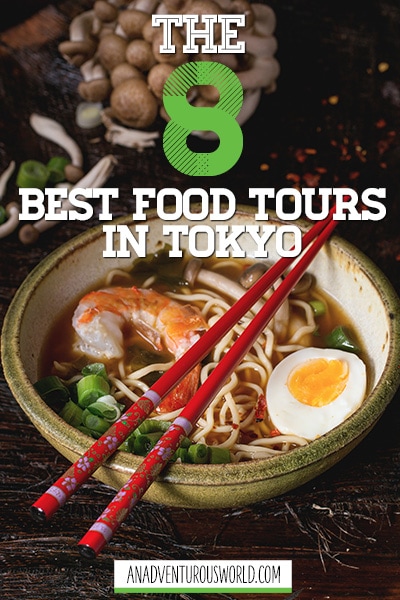
About the Author

Macca Sherifi is the founder of the multiple award-winning blogs An Adventurous World and the Great British Bucket List. Every month he inspires over 200,000 avid readers to travel the world.
2 thoughts on “10 BEST Food Tours in Tokyo, Japan”
Oh man I am DROOLING reading this! I’m going to be in Tokyo in March.. but sadly only for 2 days. Think I can do all eight of these tours in 48 hours?
Ha ha ha. I’m sure you can give it a good go if you try! Maybe just start off with one though? Let me know how you get on!
Leave a comment Cancel reply
20 Delicious Food Tours In Tokyo For Local Dishes
Are you looking for the best food tours in Tokyo? Read on, I got you covered!
Food is a universal language that speaks to our soul. And what better way to learn about a culture than through its cuisine?
Tokyo, the bustling capital of Japan, is a heaven for foodies haven with a dish for every type of palate. From sizzling ramen bowls to delicious sushi, Tokyo’s food scene is a feast for the senses.
And the best way to explore it all is through a Tokyo food tour! In this ultimate guide, I’ll go through the best food tours in Tokyo, with fantastic dishes, walking tours, cultural experiences, and much more.
So buckle up and get ready for a gastronomic adventure that will have your taste buds screaming “arigato” in no time!
BEST FOOD TOUR IN TOKYO
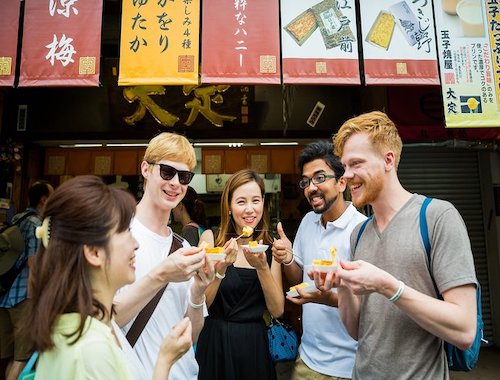
In a rush? Let me make it short – the best Tokyo food tour is the Tsukiji Fish Market Culture and Food Tour !
Plus, they have over 500 positive reviews online!
From Michelin-starred restaurants to humble street vendors, Tokyo is one of the most diverse places in Japan for food. Some of the city’s must-try dishes include ramen, sushi, and tempura.
And rest assured that you’ll have the best version of these dishes and more!
These tours will take you to the best neighborhoods in the city, from Shinjuku to Asakusa to the Tsukiji Fish Market, and you’ll have a fantastic time!
Table of Contents
3 QUICK PICKS: BEST FOOD TOURS IN TOKYO
Best Overall Food Tour in Tokyo
Tsukiji Fish Market Culture and Food Tour
- Knowledgeable and friendly guide
- Pass by the Tsukiji Uogashi for the freshest fish
- Taste all the popular Japanese dishes and snacks
Best Japanese Street Food Tour in Tokyo
West Tokyo Walking & Street Food Tour
- Covers specifically West Tokyo
- Great price with everything included
- Eat 5 popular street foods while on a walking tour
Best Culture and Food Tour in Tokyo
Japanese Culture and Food Experience with Calligraphy
- Excellent food with all the drinks included!
- Ultimate tour with matcha making and culture
- Learn Japanese calligraphy by a Japanese local
20 BEST FOOD TOURS IN TOKYO
To make the most of your time in Tokyo for food, I highly recommend booking one of these food tours that will take you on a journey through the city’s bustling markets and hidden gems.
Not only will you get to taste some of the city’s most delicious dishes, but you’ll also learn about the history and culture behind them.
Let’s get started, I can’t wait to list them all for you!
1. TSUKIJI FISH MARKET CULTURE AND FOOD TOUR
🕛 Duration: 3 hours | ⭐ Rating: 5/5 | Group Tour
Starting this list of incredible food tours in Tokyo is this comprehensive 3-hour trip around Tsukiji Fish Market around local dishes and culture.
Led by a knowledgeable guide, you’ll get the chance to explore the bustling outer market and learn about the rich history and culture of Japanese seafood.
Along the way, you’ll see Michelin-starred chefs shopping for the freshest ingredients and have the chance to sample some of Japan’s most beloved dishes like sushi and Japanese omelets.
As you stroll through the market, you’ll get to taste sake and learn about its production process.
With a focus on local, authentic experiences, this tour is the perfect way to immerse yourself in Tokyo’s unique culinary culture.
But as the best Tokyo food tour, you can only expect it to sell fast, so I recommend booking your spot as soon as possible!
Enjoyable experience viewing parts of a different culture. Seigi was an exceptional guide who interfaced. Exceptionally well with all of us. Most rewarding tour. Donald, Viator
WHAT’S INCLUDED:
- Local professional guide
- Walking Tour around the Tsukiji Fish Market and Tsukiji Jogai Market
- Japanese food and snacks, such as Sushi, Fried fish cake, Sake, and more

2. JAPANESE CULTURE AND FOOD EXPERIENCE WITH CALLIGRAPHY COURSE
🕛 Duration: 4 hours | ⭐ Rating: 5/5 | Small Group Tour
For the ultimate cultural immersion through food, look no further than this cool and original tour that features everything you could think of!
In just four hours, you’ll experience origami, handmade udon, sushi, tempura, and more, all while sipping on free drinks – that’s right sake is included!
On top of that, you’ll try Japanese sweets and matcha after your meal. This is not your average food tour – it’s a chance to become a part of a new family and make friends all around the world.
Keiko, the host, will even write your name in calligraphy as a souvenir. So why not spend an afternoon indulging in the delicious food and welcoming hospitality that Japan is known for?
It’s the perfect way to experience the best of Tokyo’s food scene while creating awesome memories!
Taka-san and Keiko-san were absolutely wonderful! The experiences we had with them is one we will cherish for a long time. I remember that I had great fun making udon and origami cranes. Jack, Viator
- Origami class
- Cooking class
- Matcha-making session
- Lunch with Sushi, Dumplings, and more
- Alcoholic drinks (Sake, beer, Shochu)
- Non-alcoholic drinks (Soft drinks)
- Your name in Japanese calligraphy as a souvenir (the name written in calligraphy)
3. TOKYO NIGHT FOODIE TOUR IN SHINJUKU
🕛 Duration: 2 hours | ⭐ Rating: 5/5 | Small Group Tour
As a foodie looking for a taste of Japan, a food tour in Tokyo you can’t miss is this one – the Tokyo Night Foodie Tour in Shinjuku.
Meet with your local guide for a small tour with 6 participants maximum, and get ready for a culinary journey through the bustling heart of Tokyo.
Sample mouth-watering Wagyu barbeque, savor tempting sushi, and try some delicious takoyaki.
Along the way, you’ll pass by famous landmarks like the Godzilla Head and the Robot Restaurant, and you can stop to enjoy the night before heading back to your hotel.
This tour lasts around three hours, giving you plenty of time to relax and enjoy your food.
And best of all, you’ll leave the tour feeling full and satisfied. What else could you possibly need on a Tokyo food tour?!
My husband and I truly enjoyed this tour with our guide. Perfect for first night in Tokyo after a long flight. Good food options too! Highly recommend. Ginny, Viator
- Different Omakase Nigiri sushis
- 3-hour night tour around Shinjuku
- Full Yakiniku dinner with Wagyu beef
- 1 dessert or 1 drink included
4. TOKYO LOCAL FOOD TOUR WITH A BAR-HOPPING MASTER
Another incredible food and drink tour to add to your Japan itinerary is this bar-hopping trip with a guide who knows all the best spots in Ueno, Shinbashi, or Ikebukuro.
Get ready to taste the town with tapas-style plates of delicious Japanese cuisine, all perfectly paired with a range of drinks.
With your guide’s help, you’ll sample traditional dishes like yakitori, gyoza, and tempura, all while soaking up the atmosphere in three unique locations.
This isn’t your average food tour – it’s a chance to get off the beaten track and explore the local food traditions that make Tokyo such a vibrant culinary destination!
Simply put, this is your chance to discover the hidden gems of Tokyo and experience Tokyo like a true local.
We had such a great time with Mr. Ono! He ordered our food and drinks and it was all stuff we wouldn’t have known were so good. We had a great time at the places he took us too. Do not miss this tour! Cheri, Viator
- Hidden gems to enjoy the night in Tokyo
- Experienced guide that knows the best spots to enjoy the night
- Different dishes at several spots around Ueno, Shinbashi, or Ikebukuro
5. ASAKUSA CLASSIC RAMEN & GYOZA COOKING CLASS
For much of the past decade, Japanese restaurants have emerged pretty much everywhere in the world.
But to get the best dishes and experience when in Tokyo, this Classic Ramen & Crispy Gyoza Cooking Class is exactly what you need.
This tour is perfect for those who want to not only indulge in these Japanese delicacies but also learn how to make them from scratch.
The guide will teach you the secrets behind a perfect ramen broth and how to get the gyoza crispy and crunchy.
This intimate small-group cooking experience provides all the necessary aprons and utensils, so all you need to bring is your appetite.
Not only will you get to enjoy the dishes you’ve prepared, but you’ll also receive the recipes to recreate them at home!
I had the best experience learning to cook with Masa and Junko! They’re both so very lovely and Masa tokes time to explain everything very carefully, each step of the cooking process. And on top of that, it was delicious! I will never forget! Djamila, Viator
- Family-friendly hosts
- Ramen and Gyoza-making class
- All utensils and ingredients included
6. KAWAII FOOD TOUR OF HARAJUKU
On the hunt for a Tokyo food tour that is both delicious and adorable? Read on, the Kawaii Food Tour of Harajuku Tokyo is what you need.
In case you aren’t aware, Kawaii food means that the dishes (or snacks) are prepared in a cute way, featuring emojis and smiley characters or drawings.
This 3-hour walking tour takes you through the back streets of Harajuku and Omotesando, two of Tokyo’s most vibrant neighborhoods.
Along the way, you’ll sample all manner of creative pastries, vibrant candy, and local specialties that will tantalize your taste buds.
To top it up, don’t worry about lunch either because it’s included!
This family-friendly tour is perfect for travelers interested in Japanese pop culture and cuisine.
And if all that weren’t enough, the lunch takes place in a work of pop culture art. Come immerse yourself in Japan’s kawaii culture, pleasure your palate, and enjoy a super cool experience!
Such a perfect afternoon in Tokyo sampling delightful and unique desserts. Our guide was knowledgable and enthusiastic. Such fun! Edie, Viator
- Local knowledgeable guide
- 5 Delicious Japanese foods
- Dessert and drink included
- Pass by Kiddy Land, Omotesando, and Cat cafe Mocha

7. ULTIMATE RAMEN TASTING TOUR IN TOKYO
🕛 Duration: 3 hours | ⭐ Rating: 5/5 | Small Group Tour
Into Japanese ramen? If so, this food tour in Tokyo is one of the things in town you should seriously consider.
This tour takes you on a journey through three of Tokyo’s most famous ramen neighborhoods, where you’ll sample 6 different ramen in mini-bowls.
You’ll meet up with an expert and learn about the history and future of this popular Japanese dish and discover unique flavors ranging from spicy fish to savory pork.
With stops in Nakameguro Koukashita and Shibuya Station South, this tour is the perfect way to explore Tokyo’s ramen scene like a real local.
Don’t forget to come hungry; this tour is sure to leave you satisfied and eager to explore more of Tokyo’s delicious food options!
Great experience, recommended for all who love Ramen and even if you don’t. Enjoyed the diversity of Ramen shops, and all the insights on making Ramen. Enjoy! Phil, Viator
- Local guide
- Lunch and food tasting
- 6 different bowls of ramen
- Tour of Shibuya with a local
8. FOOD CRAWL TOUR IN ASAKUSA
🕛 Duration: 2.5 hours | ⭐ Rating: 5/5 | Group Tour
Next on our list is a short yet comprehensive food tour in Asakusa that’ll take you off the beaten path to explore the non-touristy side of Tokyo.
Here, you’ll connect with Japanese culture and local businesses and vendors to gain a greater appreciation for this part of Japan.
The tour takes you to 4-5 local food shops and restaurants with more than 100 years of history, where you can eat like a local at a standing sushi bar and soba restaurant.
Lunch and alcoholic beverages are included in the tour, and after indulging in the yummy food, you’ll end the trip with a visit to Senso-ji Temple, the oldest temple in Tokyo.
This tour is a gem for those who crave a more authentic, off-the-beaten-path food experience.
As the idiom goes, “When in Rome, do as the Romans do,” and this tour lets you do exactly that!
Our guide was excellent and knowledgeable. Meeting her at the first restaurant was very easy. She took us to about 5 or 6 places for a range of foods and concluded near the central shopping area/temple in asakusa. To top things off, she sent us a list of suggestions for places to eat in both Tokyo and Kyoto! A Viator Traveler
- Visit to Senso-ji Temple
- Lunch and alcoholic beverages
- Visit famous local sushi bars and soba restaurants
- Have a snack at 4 different vendors in Asakusa
9. SHIBUYA AND HARAJYUKU FOOD TOUR IN TOKYO
🕛 Duration: 9 hours | ⭐ Rating: 5/5 | Small Group Tour
Willing to spice up your trip to Tokyo? Check out this amazing Tokyo Food and Culture tour!
This tour will take you through the trendy neighborhoods of Shibuya and Harajuku for a taste of the city’s best cuisine and unique culture.
Start the tour at Shibuya Hachiko, where you’ll share the inside scoop on one of Tokyo’s most iconic symbols before heading to Shibuya Crossing for the perfect photo op.
Indulge in sumo wrestlers’ traditional dishes, savor Tokyo-style Monjya pancakes, and dig into some of the cutest and trendiest candies around.
Along the way, you’ll also explore the colorful and lively streets of Harajuku, a hub of Japanese youth culture.
Book your spot on our tour and prepare for an adventure you’ll never forget!
I definitely recommend this tour! Really enjoyed the tour with Interesting stories behind the items in the visiting spots and yummy local foods. Thank you for organizing the wonderful tour! A Tripadvisor Traveler
- Tour of Shibuya and Harajyuku districts
- Pass by the famous Shibuya Crossing
- Different food and snacks on the way
- Visit the KitKat Chocolatory in Miyashita Park
10. 3-HOUR BAR HOPPING IN SHIBUYA WITH FOOD
🕛 Duration: 3 hours | ⭐ Rating: 4.8/5 | Small Group Tour
This 3-hour tour takes you through the maze of rustic izakayas and standing bars frequented by the city’s working class. Needless to say, you’ll like you’re living in Tokyo!
And just before exploring all the food options, your guide will take you on a wild ride through the bustling Shibuya Crossing, where you’ll snap Instagram-worthy photos.
But the real adventure begins as you follow your guide through the vibrant yokocho and discover hidden Izakayas, where locals go to unwind after a long day.
You can indulge in delicious vegan and non-vegan options, including melt-in-your-mouth Kobe beef and Sake.
This tour promises to be the ultimate gastronomical delight, offering a unique experience for the curious travelers.
Can you think of a cooler way to explore around?!
Really great tour. Great drinks and food around Shibuya seeing places I likely never would have seen otherwise. There were also fun people on the tour, and it made for a great evening. 100% recommended. A GetYourGuide Traveler
- 4 drinks with 3 dishes
- Visit of 3 Izakaya bars with a guide
- Photos taken during the tour
- Visit of different spots like the Shibuya Crossing
11. WEST TOKYO WALKING AND STREET FOOD TOUR
🕛 Duration: 2 hours | ⭐ Rating: 4.9/5 | Small Group Tour
Tokyo is a massive city, and it can be daunting to visit everything. And unlike the other food tours in Tokyo’s popular areas, this one only takes you to more unique neighborhoods.
You see, this small group tour provides a refreshing change of pace as you explore the charming neighborhoods and taste your way through everyday life on the streets.
With a tailored selection of street food from local vendors, you’ll get a true taste of life in the city. And as you meander through the vibrant ‘Yokocho’, you’ll feel like a neighborhood insider.
Don’t be afraid to roll up your sleeves and get dirty – this food tour is all about trying Tokyo’s street food scene!
By the end of the tour, you’ll be equipped with insider tips to make the most of your Tokyo dining experiences.
Andy was very knowledgeable and able to gauge his audience perfectly. Just enough info about the food and areas to keep you curious and make you want to come back and explore for yourself. Definitely recommend this – good for kids too (my two boys – 11 and 9 – loved it). A GetYourGuide Traveler
- Walking tour with an expert guide
- 5 Japanese street foods from vendors
- One drink at an Izakaya bar in Nakano and Koenji
12. PRIVATE STREET FOOD TOUR IN TOKYO WITH A LOCAL
🕛 Duration: 3 hours | ⭐ Rating: 5/5 | Private Tour
Calling all foodies! Are you ready for a culinary adventure through the bustling streets of Tokyo? This ultimate private Tokyo food tour lets you try 10 different delicacies!
This personalized experience will take you to places you’d never find on your own, as your guide leads you to try the best street food dishes in Tokyo.
And don’t worry, there are vegetarian alternatives available. So come hungry and get ready to eat your way around Tokyo!
From the Kichijoji Art Museum to Hamonika Yokocho Kichijoji to Coppice Kichijoji, these hidden gems are waiting for you to discover them.
What else to say, it’s just one of the best food tours in Tokyo, and I can’t recommend it enough!
Fab guide and great food. We are foodies but had never been exposed to Some of these delights. A joy. Walking from place to place allowed us to experience this great community. A Tripadvisor Traveler
- 10 food and drink tastings
- Vegetarian alternatives
- Private tour guide with a custom itinerary
- Tour of the Chiyoda and Musashino districts
13. FULL-DAY FOOD AND CULTURE PRIVATE TOUR IN TOKYO
🕛 Duration: 6 hours | ⭐ Rating: 5/5 | Private Tour
When coming to Japan, there’s one thing I can never get out of – Food. And if there was one tour I would recommend to anyone, from families to groups of friends, this would be the one.
This 6-hour tour offers a VIP experience, allowing you to customize your itinerary to suit your own interests.
Explore the city’s best food spots, cultural attractions, and shopping districts, all while avoiding the hassle of navigating a map on your own.
Plus, with a licensed local guide leading the way, you can sit back and enjoy the full experience of Tokyo.
So why settle for less when you can have the best food tour in Tokyo?
My wife and I really enjoyed our Day Tour of Tokyo. Mika, our tour guide, was amazing. We went to several markets, experienced the subway and train as well as more than one food and beverage stops. I highly recommend this tour as well as Mika! A Tripadvisor Traveler
- Private walking tour around Tokyo
- The visit of 4 different spots in town
- Street food in Ameyoko Shopping Street and other sites
14. SMALL-GROUP FOOD AND PUB TOUR WITH HIDDEN GEMS
🕛 Duration: 2.5 hours | ⭐ Rating: 5/5 | Small Group Tour
If you’re a food lover in Tokyo, you know there’s no shortage of tasty bites to discover.
But if you want to go beyond the tourist traps and taste the city’s hidden gems, this small tour is the perfect choice.
Get to the meeting and start this awesome tour, roaming through the vibrant streets of Shinjuku, Shibuya, and Yotsuya, exploring hidden pubs and restaurants that only the native locals know.
You’ll be treated to a feast of small bites like the ever-satisfying okonomiyaki pancakes, fresh sashimi, and savory yakitori, all washed down with Japan’s most famous beverage, sake.
With this small-group tour, you won’t be bogged down by large crowds or tourist traps. Instead, you’ll get to experience Tokyo at your own pace, how fun!
Great night at great venues with a great guide. Went to places like we were locals and were welcomed with open arms. Excellent beer, sake and food. Jon, Viator
- Expert local guide
- Visit of different bars in Kabukicho
- Sample of the best food such as Okonomiyaki and Sashimi
15. 6-HOUR PRIVATE STREET FOOD TOUR
Another epic food tour in Tokyo is this private 6-hour culinary experience that includes everything you need.
You’ll follow a savvy guide through three different neighborhoods, exploring and tasting everything from gourmet street food to traditional izakaya-style dining.
And with all food and drinks included, you’ll have the recipe for a perfect day out!
This tour is perfect for picky foodies with a discerning palate and a desire for adventure. So come on down and chow down, because this tour is sure to be the highlight of your Tokyo trip!
Simon was great about communicating exactly where we would meet to begin our tour. We started in station underground food courts and then moved to several neighborhoods where we enjoyed delicious local street food and drink! I really had a great time! MaryAnn, Viator
- Alcoholic Beverages
- Private walking tour in 3 neighborhoods
16. GUIDED WALKING TOUR OF TSUKIJI WITH BREAKFAST
🕛 Duration: 2.5 hours | ⭐ Rating: 4.2/5 | Small Group Tour
I’m pretty confident one of the reasons why you’re in Japan is food, and this tour will take your taste buds on a journey through Tokyo’s culinary wonderland!
Join our knowledgeable guide and prepare for a morning of indulgence as you walk through the bustling streets of the famous Tsukiji Outer Market.
But let’s get down to the meat of it. Along the way, you’ll savor seven delectable tastings that will have you drooling for more.
From juicy grilled seafood and beef skewers to crispy fried fish to sweet snacks like mochi, you’ll experience the full range of Japanese flavors.
You’ll even get the chance to sample some Japanese tea and dashi soup stock, all while learning about the history and culture of this unique market.
It’s one of the best food tours in Tokyo and I can’t recommend it enough!
This tour was a highlight of our time in Tokyo! Our guides were very friendly and knowledgeable and worked well together to maximize our time and experience. We tried food we never would have otherwise and purchased items to take home and enjoy. A GetYourGuide Traveler
- Experienced guide
- Tasting of 7 local specialties
- Breakfast at Tsukiji Outer Market
- Lots of fun!
17. RAMEN TASTING TOUR WITH 6 RAMEN DISHES
If you’re a ramen fanatic, you’re in for a treat with this Tokyo Ramen Tasting Tour.
It’s like a gastronomical sightseeing trip, where you visit three neighborhoods and three ramen shops with a different ramen topic at each location.
You’ll be experiencing ramen evolution from its origins to the future. You’ll be slurping up 6 mini bowls of some of the best ramen in Tokyo, so be sure to come hungry!
Unleash your inner foodie and join this professional guide on this adventure in search of the perfect ramen.
At the end of this delicious journey, you’ll have learned so much about ramen that you’ll become an expert in no time.
The history of Japan through ramen! Such a knowledgeable guide and friendly team. Great atmosphere in the chosen restaurants and the food was superb! Would recommend you experience the tour with Frank and his team – a must for any Tokyo visit! A GetYourGuide Traveler
- Several bowls of ramen
- Visit of 3 neighborhoods
- A friendly guide that tells you the story behind ramen
18. WEST TOKYO GUIDED CYCLING AND FOOD TOUR
🕛 Duration: 3.5 hours | ⭐ Rating: 4.7/5 | Small Group Tour
Taste your way through Tokyo in the coolest way possible with this West-Side Cycling and Food Tour!
You’ll don your finest pedaling gear and hop on a “mamachari” bicycle (yes, that’s right, a bike that may make some noises but is always in great shape).
With an experienced local guide at your side, you’ll have insider access to some of the most fascinating neighborhoods in Tokyo.
Don’t be scared to leave your comfort zone and try the enticing and sometimes surprising neighborhood cuisine along the way.
Among the best food you’ll have, you’ll eat 3 famous street food dishes and a delicious lunch, how cool!
All in all, it’s a gourmet tour that I highly recommend when coming over to Tokyo.
Andy is a great guide and as an expat in Tokyo provided great insight into Japanese culture and the city. Koenji is a perfect neighbourhood to explore on a bike and we highly recommend his tour to visitors wanting to experience a more off the beaten path tour. A GetYourGuide Traveler
- Delicious local lunch
- 3 popular street foods
- One bottled drink
- Liability insurance
- English-speaking guide
19. TSUKIJI MARKET FOOD AND DRINK WALKING TOUR
We’ve already discussed food tours that take you around the Tsukiji market, but this one takes things further with a drink-walking tour!
This tour is the group’s ticket to taste-testing some seriously delicious Japanese delicacies.
Your guide will lead you on an adventure through the bustling stalls of Tsukiji, educating you about the market’s history and introducing you to local vendors selling drinks and the freshest seafood.
But let’s get to the good stuff…the food! With your guide’s recommendations and local knowledge, you’ll sample a variety of traditional Japanese dishes.
From crispy tempura to savory sushi, you’ll feel like you’ve mastered the culinary culture of Tokyo in one day.
And don’t worry about getting lost in the maze of seafood stalls; your guide’s got your back!
Great all rounded tour of fish market with our guide Tak. We enjoy a tour at the top saw tables of the markets, taste top traditional fish bites, strawberries sitting in the sunshine, taste soup, tea and other fish bites. At the end Tak took us a top restaurant for sushi meal! A GetYourGuide Traveler
- Friendly Guide
- 3-hour walking tour
- Different dishes and snacks
20. 2-HOUR VEGAN & VEGETARIAN RAMEN TOUR IN SHIBUYA
Last but not least on our list of Tokyo food tours is this Vegan and Vegetarian Ramen Tour to slurp your way around Tokyo on a plant-based adventure.
This two-hour tour takes you to the heart of Shibuya, where you’ll explore the savory world of ramen alongside a local expert.
Hokkaido ramen, miso ramen, shoyu ramen, and shio ramen are just some of the exciting styles you’ll get to slurp up.
And the best part? With each bowl, you can choose whether you want to go vegan or non-vegan!
But the adventure doesn’t end there! Our tour also takes you to a modern ramen shop where you’ll dive into two mini bowls of fusion ramen.
This is where creativity truly kicks in – think unexpected flavors that will leave your taste buds dancing.
All in all, for all the vegetarians and vegans out there, this is definitely the food tour you can’t miss while in Tokyo!
- 4 Different bowls of ramen
- Knowledgeable guide
TOKYO FOOD TOUR – FAQ
Now that we’ve covered the most delicious food tours in Tokyo, let me answer some questions from first-time visitors.
IS A FOOD TOUR IN TOKYO WORTH IT?
Absolutely! Taking a food tour in Tokyo is the perfect way to immerse yourself in the city’s vibrant culinary scene and discover its hidden gems.
While Tokyo is known for its high-end dining options, some of the best food can be found in the cozy back alleys and local markets, often off the beaten path.
A food tour with a knowledgeable guide will take you to these hidden spots, introduce you to local specialties, and give you insider tips and recommendations for the rest of your culinary adventures.
WHAT ARE THE MOST POPULAR JAPANESE DISHES?
Japanese cuisine is known for its unique flavors, fresh ingredients and impeccable presentation. Some of the most popular Japanese dishes you can try in Tokyo are Sushi, Ramen, Tempura, Donburi, and Yakitori.
While you can enjoy these dishes in regular restaurants, you can also find them at street food stalls, which is worth trying!
WHAT IS JAPANESE BREAKFAST MADE OF?
A traditional Japanese breakfast typically consists of several small dishes that are meant to be enjoyed together. The most common dishes for breakfast are rice, miso soup, grilled fish, Tamagoyaki, as well as Natto.
This is just a sampling of the many components that may make up a traditional Japanese breakfast.
The exact dishes will vary from region to region and household to household, but the focus is always on fresh, flavorful, and nutritious foods.
WHERE TO STAY IN TOKYO
Tokyo has hundreds of accommodation options to choose from, so I have narrowed it down to a few of the best places to stay to fit the needs of budget backpackers, luxury travelers, and everyone in between.
See the list of accommodations below that I personally recommend:
LUXURY: THE AOYAMA GRAND HOTEL
MID RANGE: HOTEL MONDAY AKIHABARA ASAKUSABASHI
BUDGET: UNPLAN SHINJUKU
WHAT TO PACK FOR JAPAN
When visiting Tokyo, here is a list of items I highly recommend bringing with you:
Must-Have Travel Essentials
Hidden money wallet.
Keep your cash and other valuables safe with this anti-theft hidden money wallet!
Reusable Water Bottle
The GRAYL GeoPress is the best reusable bottle that allows you to purify water from anywhere!
Travel Backpack
The Nomatic Travel Backpack has 20+ innovative features, perfect for everyday use!
Quick-Dry Travel Towel
The most compact, lightweight, and quick-dry towel for traveling!
Portable PowerBank
Keep your phone, laptop, and accessories charged while you’re on the go with the Anker PowerBank!
More Japan Travel Guides
Click the button below to view all articles related to Japan!
FINAL THOUGHTS – TOKYO FOOD TOURS
If you have any questions about this Tokyo food tour guide, please leave me a comment below this post and I will get back to you as soon as I can.
For a quicker response, be sure to join Jonny Melon’s Travel Tribe on Facebook and post your questions or recommendations to our awesome community.
TRAVEL RESOURCES FOR YOUR NEXT TRIP
Whether you’re a seasoned traveler or it’s your first trip overseas, here are some useful travel resources to help you kick-start your next adventure!
Search and book accommodation worldwide.
Compare and book cheap flights to anywhere.
Find tickets, tours, and experiences around the world.
Book buses, trains, and transfers online in advance.
Search all rental cars in your next destination.
Need travel insurance for your next trip?
THANKS FOR READING
Hey friend, thanks for reading this guide!
Please know this post may contain affiliate links. When making a purchase through one of my links, I earn a small kickback at no extra cost to you and it’s a big help to keep the site up and running. Rest assured, I only promote products and services that I personally use and recommend.
Click here to find out how you can support the site organically .
Many thanks!
Leave a comment Cancel reply
Notify me of follow-up comments via e-mail.
Plan Your Trip
Travel Guides
Destinations
Hotel Guides
Find Best Tours
Travel Gear
Travel Resources
How To Start A Blog
Photography Guides
Support the site
Follow On Socials
© 2024 Jonny Melon Adventure Travel Blog. All rights reserved.
Privacy Policy | Terms | Sitemap
Tokyo Food Guide
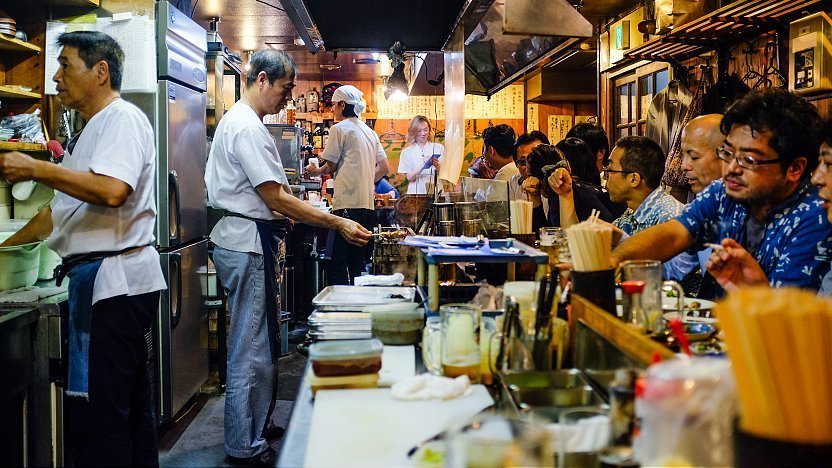
Tokyo is one of the world's most exciting dining destinations. The city features a wide range of both local and regional Japanese cuisine in addition to all types of international fare. Its top restaurants have accrued more Michelin stars than both Paris and New York combined. But good food can be found at every price range from cheap hole-in-the-wall joints to expensive high-class restaurants with every budget in between.
Tokyo specialties
As Japan's political center for over four centuries, Tokyo has naturally exerted great influence on Japanese cuisine . Consequently, some Tokyo specialties have become so popular that they are now known as the standard version of the dish rather than a local specialty. Local creations from Tokyo (formerly called Edo) are often referred to as "Edo-mae", literally meaning "in front of Edo", in reference to Edo Bay (now Tokyo Bay) which provided the city with its local seafood. The following are some popular Tokyo specialties:
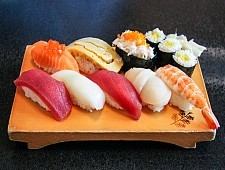
Regional specialties from across Japan
Tokyo is also a good place to enjoy regional Japanese foods from across the country, which have been available in Tokyo since the Edo Period when the regional lords (daimyo) from across Japan were forced to maintain large villas in the capital and spend alternate years there. A by-product of this policy to keep the regional lords under the shogun's control was the influx of various regional cooking styles into the capital.
These days, foods from across the country can be found at many restaurants specialized in regional cuisines. Some of the most popular regional foods that can be sampled around Tokyo come from Okinawa , Kagoshima , Fukuoka , Kyoto and Hokkaido . In addition, successful restaurants from across Japan often open outlets in Tokyo in an effort to branch out and make a name for themselves.

International dining
International food is enjoying great popularity in Tokyo, and many Japanese chefs have achieved recognition for their skills in foreign cooking, often acquired by practical training overseas. Furthermore, Tokyo is home to various international communities, which have brought a variety of different cuisines with them.
While popular foods such as Chinese, Indian, Italian, French and Korean can be found virtually anywhere in the city, there are also a few districts serving less prominent international cuisines especially around the embassies located in the Azabu, Hiroo and Roppongi districts. Below are a few of the more concentrated international districts:
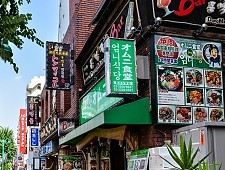
Casual dining
There are lots and lots of casual dining restaurants of all types found across Tokyo. While restaurants are easy to find just about anywhere in the city, good places to go for a large variety of them are around train stations, entertainment districts and the restaurant floors of most department stores , where there is usually a good selection of restaurants ranging from Japanese cuisine to international dining.
Izakaya are the most common type of casual dining establishments and are good places to try a variety of dishes. They can be found in droves around train stations and entertainment districts and serve popular food items such as yakitori , sashimi and of course beer . The following are a few casual dining areas around Tokyo that are well known for their atmosphere:
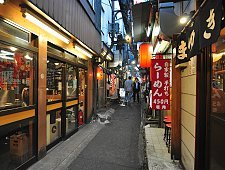
Fine dining
Tokyo is well known for its fine dining and has the highest number of Michelin-starred restaurants of any city in the world. Fine dining restaurants are often found on the top floors of skyscrapers and major hotels , and the cuisine served at these restaurants ranges from traditional Japanese to international and fusion fare. Of course, they tend to be priced accordingly, and some restaurants may require advance reservations. The following are a few districts that are known for their fine dining establishments.
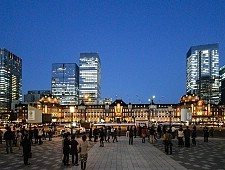
Themed dining
Themed cafes such as maid and butler cafes, as well as pet cafes are popular attractions where you can converse or play games with a maid or butler, or spend time with animals such as cats, rabbits or birds while eating light meals or enjoying a coffee or tea. Maid cafes can easily be found in Akihabara whereas butler cafes are more concentrated around Ikebukuro . Pet cafes can be found in small numbers around the city. All these types of cafes usually charge a small cover charge in addition to food and drinks.
Another type of themed dining are food theme parks which typically feature different variations of a specific food such as ramen or gyoza . Despite the name, food theme parks are usually indoors and work similarly to a food court except that all the vendors are selling variations and regional types of the same dish. Some food theme parks around Tokyo include the Namja Gyoza Stadium in Ikebukuro and a ramen theme park in Aquacity on Odaiba .
Those looking for a quirky and entertaining meal, themed restaurants like the Ninja Restaurant can be a fun and appealing attraction. Themed restaurants are decorated similarly to amusement parks, have themed menus and staff dressed in costume. The food usually follows the overall theme, and there may be some type of performance during the meal.
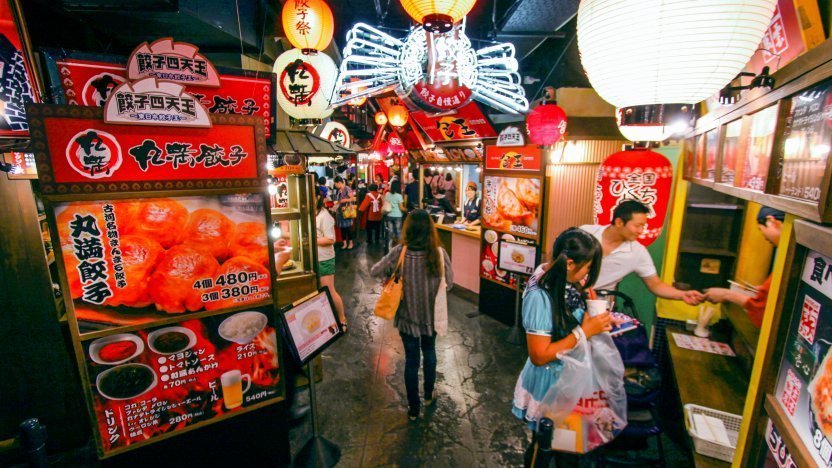
Japanese-style breakfast
The easiest place to try a Japanese-style breakfast are hotels , many of which offer Japanese breakfast set meals or buffets with both Japanese and Western dishes. Otherwise a Japanese-style breakfast is difficult to find as most restaurants and coffee shops tend to serve Western-style breakfasts or coffee and toast sets only. One option may be gyudon restaurants which often offer basic Japanese breakfast sets at cheap prices.
For the more adventurous, the sushi restaurants in the Tsukiji Outer Market and at Toyosu Market are open from early morning, offering fresh sushi for breakfast. Note that many of these restaurants close by mid-afternoon.
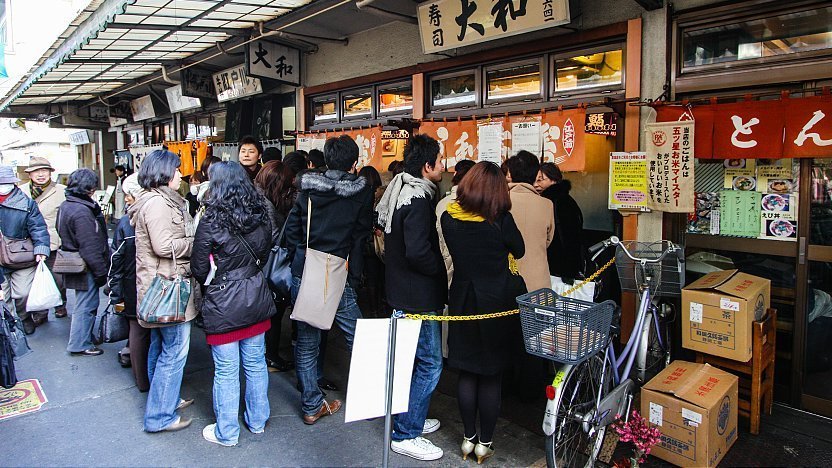
Questions? Ask in our forum .
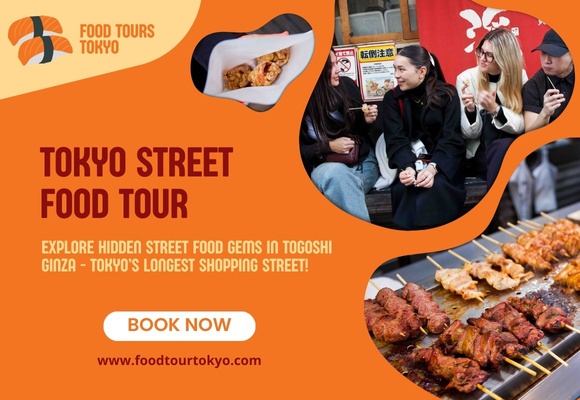
Hotels around Tokyo
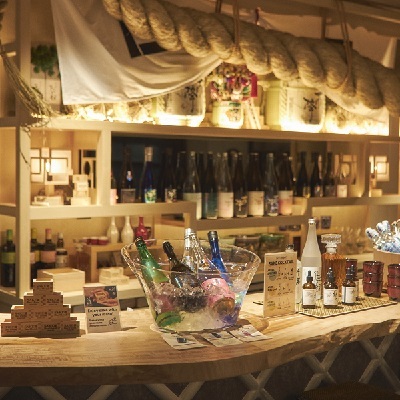
Experiences around Tokyo


- Destinations
- Private Tours
- Historical Tours
- South Korea
- United Arab Emirates
- Czech Republic
- Brussels NEW
- Belfast NEW
- Copenhagen NEW
- Palermo NEW
- Netherlands
- Stockholm NEW
- San Sebastián NEW
- Valencia NEW
- United Kingdom
- United States of America
- Los Angeles
- Philadelphia
- Portland, Oregon
- Washington D.C.
- San Francisco
- Houston NEW
- Mexico City
- Rio De Janerio
- Food Tour Drinks Upgrade

Tokyo Food Tour - Secret Food Tours

We're wildly passionate about classic Japanese cuisine and we'd be delighted to share our love of food and culture with you.
By booking our Secret Food Tours: Tokyo, you'll have the opportunity to experience our passion and enjoy quality food and discover why eating and drinking are a "way of life" here in Tokyo.
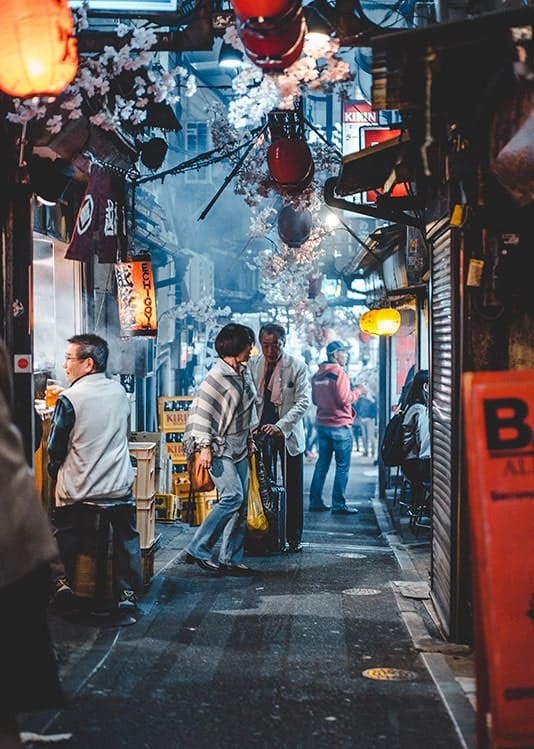
Our Secret Food Tour: Tokyo will introduce you to the best of Japanese cuisine. You'll learn from our guides about all the delicate nuances of flavor as they change with the seasons and how our appreciation for Japanese customs and traditions plays into the preparation and enjoyment of our local food.
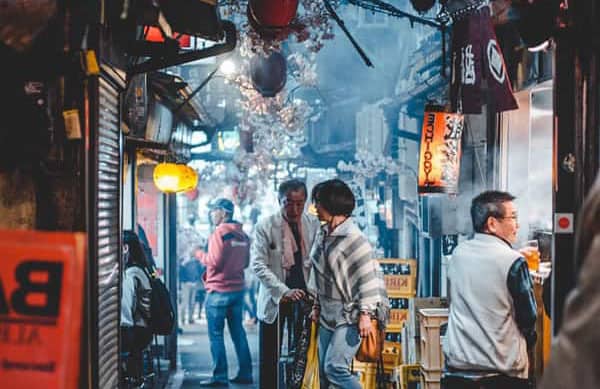
At Secret Food Tours: Tokyo, we're all extremely passionate about authentic Japanese cuisine and we can't wait to share our love of food and culture with visitors who have made the journey to our amazing city. On our tour, you'll have the opportunity to enjoy high quality food and discover why eating and drinking are a "way of life" here in Tokyo. Our city is the perfect balance between old and new, and Tokyo's fascinating history will be woven into our tour as you discover why the city is one of the food capitals of the world.
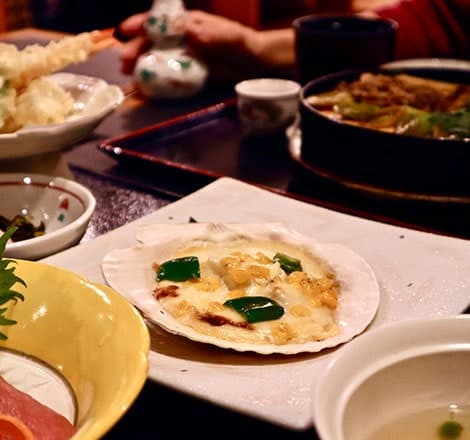
- Book Your Tour
- Our Tokyo Tours:
- Food Tours Tokyo
- Photos/Video
- Destinations
- Group & Private Tours
- Read About Us
- San Sebastián
- New York City
- Rio de Janerio

Tokyo Food Tours ( 111 )
Michelin Dining Experiences
Moving from markets to Michelin, Tokyo is home to many upscale dining experiences. The city boasts many Michelin-starred restaurants , offering exquisite Japanese and international cuisines. This is where to go if you’re after the best food tours in Tokyo to avoid crowds. These fine dining establishments showcase the pinnacle of culinary artistry, combining exquisite flavors, innovative techniques, and impeccable presentation. From kaiseki, a traditional multi-course Japanese meal, to French haute cuisine with a Japanese twist, Tokyo's fine dining scene is a gastronomic adventure that will stay with you forever.
Specialty Tokyo Food Tours
Tokyo offers various food experiences that cater to every palate and preference. While traveling with dietary restrictions may come with concerns, we’re here to ease your woes. In the past, Japan has had a reputation for being difficult to navigate regarding food allergies or restrictions. However, the land of the rising sun has come a long way (especially since the Olympics and especially in Tokyo). Whether indulging in fresh bites of sushi, feasting on street food delights, immersing yourself in themed restaurants, or uncovering the best secret food tours in Tokyo, this city is the place to experience it all.
Plan Your Trip to Tokyo: Best of Tokyo Tourism

Tokyo, Japan
Travel advice, essential tokyo.
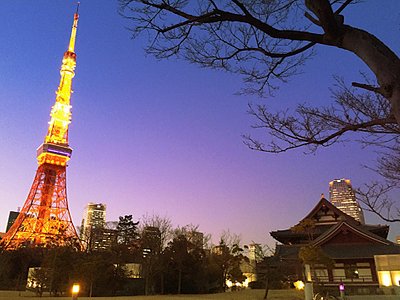
Where to stay

Where to eat
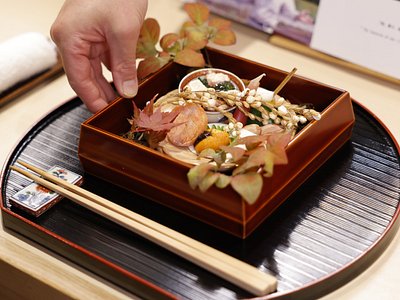
How to spend 7 days in Tokyo

The Best Free Things to Do in Tokyo
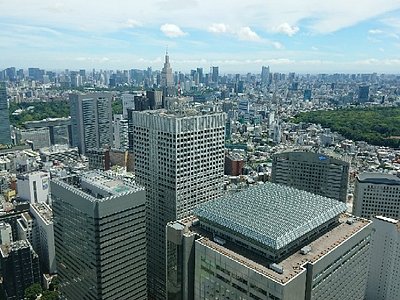
Browse collections

More Asian cultural capitals
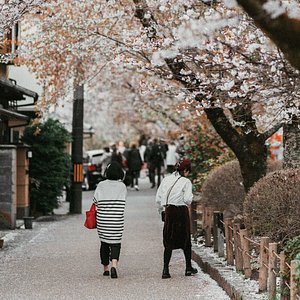
Tokyo Travel Guide
Travelers' pro tips or experiencing tokyo.
Tokyo is so much easier to get around in than you expect before you get there. It is crowded and busy but organized and sensible (as opposed to, say, Rome or Los Angeles). The system of subways and trains can be daunting because there are so many, but you can get anywhere you want to go with a good station map.
Don't ask for "bathroom,” ask for "toilet.” I'm terrible at picking up a new language, but I managed to make it through. Usually, I'd say something in mangled Japanese, then would get a response in English.
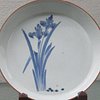
Bargainhunter
Get maps and travel information in English before your trip and at tourist information booths in large Japanese cities.

I see Tokyo as the perfect balance of opposite elements. The size and scale bring a sense of chaos yet everything seems to flow and work in perfect order. It balances a wonderful history with modern and edge. It is vast but offers intimate small experiences that are hard to replicate. It is a perfect balance of contradictions that draw you in and leave you with a sense of wonder.

Whether you're visiting for business or leisure, to glimpse into history at the Imperial Palace and its many cherry blossom studded shrines, or to peek into the future in districts like electronic paradise Akihabara and edgy, fashionable Shinjuku, Tokyo will cater to almost every curiosity. A cradle of politics, culture, and business for Japan, Tokyo offers an almost limitless variety of entertainment, shopping, dining, and alternative opinions.

jessicawhylee
Given all of Tokyo's skyscrapers and salarymen, it's easy to assume that the city is a barren urban wasteland without a breath of fresh air to punctuate its high-tech and industrialized neighborhoods. But between all those glittering shopping centers and glass business buildings are pockets of beautiful parks, serene walking paths, and tranquil temple and shrine gardens — all helping you to slow down and take a breather.
Something old, something new, and something delicious — just for you. Everyone loves a good meal, and in Tokyo— Japan's greatest metropolis — there seem to be good meals on offer at every turn. From ramen bars to all-you-can-eat izakaya, to traditional sushi restaurants where steaming cups of green tea accompany flawless cuts of sashimi, to ultra-modern cafes where girls in French Rococo-inspired outfits dig into dainty, creamy cakes, and decorated coffees...
EmiliaStockholm
Tokyo has everything, great shopping, excellent restaurants, neon-lighted hustle and bustle, and nice quiet places to walk around.
What is the best way to get there?
Tokyo is serviced by two major airports, Narita and Haneda. Haneda is closer to the city.
You can find more information here .
The Japan rail network is extensive and trains from other cities could arrive in multiple stations in Tokyo. The most serviced would include Tokyo Station, Shibuya Station and Shinjuku Station. Shinjuku is known as the world’s busiest train station. For bullet trains (shinkansen), the stations are Tokyo Station and Shinagawa Station.
Do I need a visa?
Currently, citizens from 68 countries can travel into Japan visa-free. Please check on your eligibility and visa information here .
When is the best time to visit?
October to February: Tokyo is a great destination all year round. However, the summer months can be excruciatingly hot. Avoid July, August, and early September if you don’t like to sweat as the average temperature over these months hovers at 85 Fahrenheit (29 Celsius). Tokyo’s high season falls between mid-March to late April, especially because many domestic and foreign travelers like to come at that time to see the cherry blossoms. Similarly, October and early November are peak times to view the fall foliage.
On the ground
What is the timezone.
Japan Standard Time
What are the voltage/plug types?
Typically these are 100 Volts / 50-60 Hz. (You will occasionally find 200 Volt outlets for larger appliances like air-conditioning units.) Plugs are Type A and B.
What is the currency?
The Japanese Yen.
Are ATMs readily accessible?
Are credit cards widely accepted.
Yes and no. Many high-end restaurants and small shops are cash only. Major departments stores and hotels will usually accept credit cards. It is always advisable in Japan to carry cash.
Is it easy to find a bank?
How much do i tip.
No need to tip. In general, restaurants are not used to receiving tips at all. Tipping is accepted on very limited occasions. You could tell a taxi driver that you don't need changes after paying the fare, they would accept the change as a tip (but they don't really expect to receive it). When you are visiting some bars, you could buy a bar master a drink if you are having a really good time instead of tipping.
Are there local customs I should know?
Blowing your nose.
Try not to blow your nose in public, and avoid both eating and drinking on the street (ok in parks). It is considered rude.
Counting your change
Do not count change in view of the person who gave it to you. It is also considered rude.
Public transportation
Try to be quiet in trains, at restaurants, and at your hotel. Japanese culture puts great emphasis on consideration for others and maintaining a quiet and harmonious atmosphere.
Remove your shoes when entering private homes, ryokans, and even some restaurants and offices.
If you have a tattoo, forget trying to visit a Japanese hot spring. Unless you have booked a hotel room with a private bath, you won’t be able to enter.
For more observations on customs in Japan, here's a useful site.
- Toyoko Inn Asakusa Kuramae NO. 2
- Soho Asakusa
- Unito Chiyoda
- M-1 Tokyo Shimomaruko
- Hotel Atlas Shinkabukicho
- EatWith: Tomoko of Tokyo
- EatWith: Yuma of Tokyo
- EatWith: Ayaka of Tokyo
- EatWith: Ayako of Tokyo
- Ramen Jiro Kaminoge
- Nintendo Store Tokyo
- Tokyo Metro
- Meguro River
- Sumida River
- Nikko one day trip guide with Private transportation
- Private Car Mt Fuji and Gotemba Outlet in One Day from Tokyo
- Full Day Hiking Tour at Mt.Takao including Hot Spring
- Exciting Nikko - One Day Tour from Tokyo
- Tokyo Fuji Art Museum Admission Ticket + Special Exhibition (when being held)
Everything you need to know about getting around Tokyo

Mar 23, 2024 • 11 min read

People are always on the move in Tokyo and there are many transportation options to get around the city © JohnnyGreig / Getty Images
Given that Tokyo is the most populated city on earth, it needs a transport system that's up to the task of moving millions of people around daily.
Fortunately, the public transportation in Japan's capital is efficient, reliable, clean and generally safe – it makes getting around the region a breeze.
Of most use to travelers is the train and subway system, which is simple to navigate thanks to English signage and color-coded lines – even if some large stations, most notably Shinjuku, can be a maze for the uninitiated.
But don’t feel obliged to use trains for every journey. Despite unpredictable traffic patterns, buses tend to be equally punctual and can be useful for short journeys in quieter suburbs.
Tokyo’s relatively flat topography also means cycling and walking don’t require too much of a sweat, and allow you to explore neighborhoods you’d otherwise bypass on the underground.
And if you want to combine your commute with sightseeing, take to the river on one of Tokyo’s beetle-like water buses, which travel between mainland Tokyo and the reclaimed islands of Tokyo Bay. This is everything you need to know about getting around Tokyo.
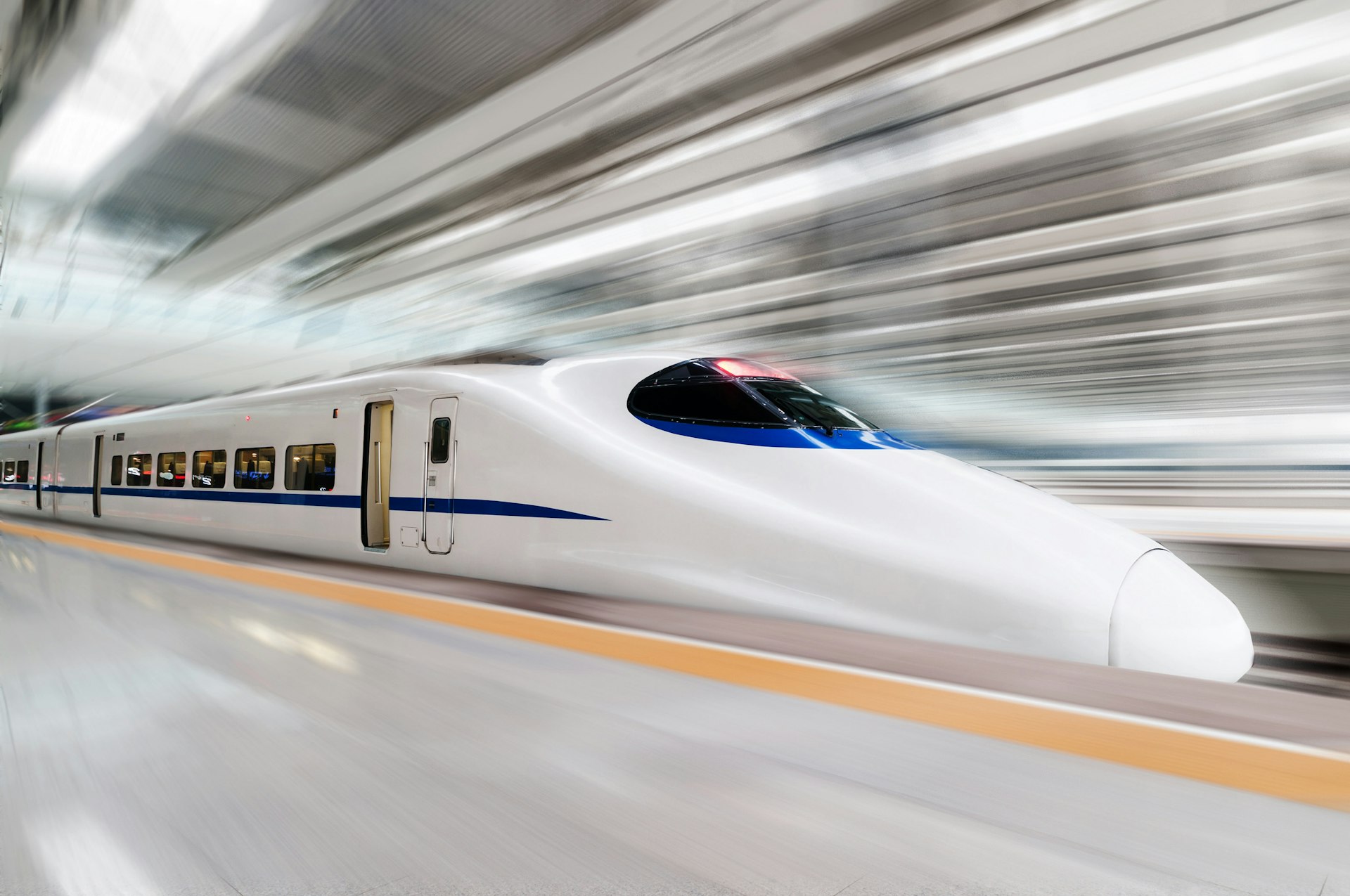
Tokyo's trains and subway system get you around quickly
Tokyo’s extensive rail network includes Japan Railways (JR) lines, a subway system and private commuter lines that depart in every direction for the suburbs like spokes on a wheel. Journeys that require transfers between lines run by different operators cost more than journeys that use a single operator’s lines.
Major transit hubs include Tokyo, Shinagawa, Shibuya, Shinjuku, Ikebukuro and Ueno stations — all connected via the JR Yamanote Line that circles the Imperial Palace , Tokyo’s central point.
Trains arrive and depart precisely on time and are generally clean and pleasant, though they get uncomfortably crowded during rush hours and late at night (for a short window in the morning and early evenings, many trains have women-only carriages).
The city's trains stop running between midnight and 5am (give or take an hour, depending on the line) while many bars, clubs, karaoke rooms and izakaya (gastro pubs) remain in business until the wee hours or even 24/7. It's wise to check when your last train departs or be prepared to find another (more expensive) means of transport home.
The JR network covers the whole country and includes the Shinkansen (bullet train). In Tokyo, the above-ground Yamanote (loop) and the Chūō–Sōbu (central) lines are the most useful. Tickets start at ¥180 and go up depending on how far you travel.
Tokyo has 13 subway lines, nine of which are operated by Tokyo Metro and four by Toei . The lines are color-coded, making navigation fairly simple – although a transfer ticket is required to change between the two networks.
A Pasmo or Suica card makes this process seamless, but either way a journey involving more than one operator comes out costing slightly more. Fares depend on the distance traveled.

Grab a transport pass for seamless travel in Tokyo
Referred to generally as IC cards or IC passes, prepaid rechargeable Suica and Pasmo cards work on all city trains, subways and buses (you can also use passes purchased in other regions of Japan, such as the Icoca from western Japan or the Kitaka from Hokkaidō).
Buy these from any touch-screen ticket vending machine in Tokyo (including those at Haneda and Narita airports); most have an English option and the cards are interchangeable. JR stations sell Suica, and subway and independent lines sell Pasmo.
Both require a ¥500 deposit, which is refunded (along with any remaining balance) when you return the pass to any ticket window. Passes can be topped up at any touch-screen ticket-vending machine (not just, for example, at JR stations for Suica passes) in increments of ¥1000.
Unfortunately, a shortage of chips has resulted in a supply failure of the physical cards and they're now hard to find in Tokyo. iPhone users can use a digital IC card through their Apple Pay function and there are tourist-specific cards available at the airports.
These have a much shorter expiry date than the regular cards – 28 days versus 10 years. If you still have an IC card from your last trip to Tokyo, it will work fine if it's less than 10 years old.
If you’re planning a packed day, you might consider getting an unlimited-ride ticket. The Tokyo Subway Ticket allows unlimited rides on both Tokyo Metro and Toei subway lines, with 24-hour, 48-hour and 72-hour options available.
This pass is only available to foreign travelers on a tourist visa; you’ll need to determine whether the trains you plan to use will be largely JR or metro to get your money’s worth.
Using IC cards is simple: just run them over the card readers at the ticket gates upon entering and exiting. Fares for pass users are slightly less (a few yen per journey) than for paper ticket holders.
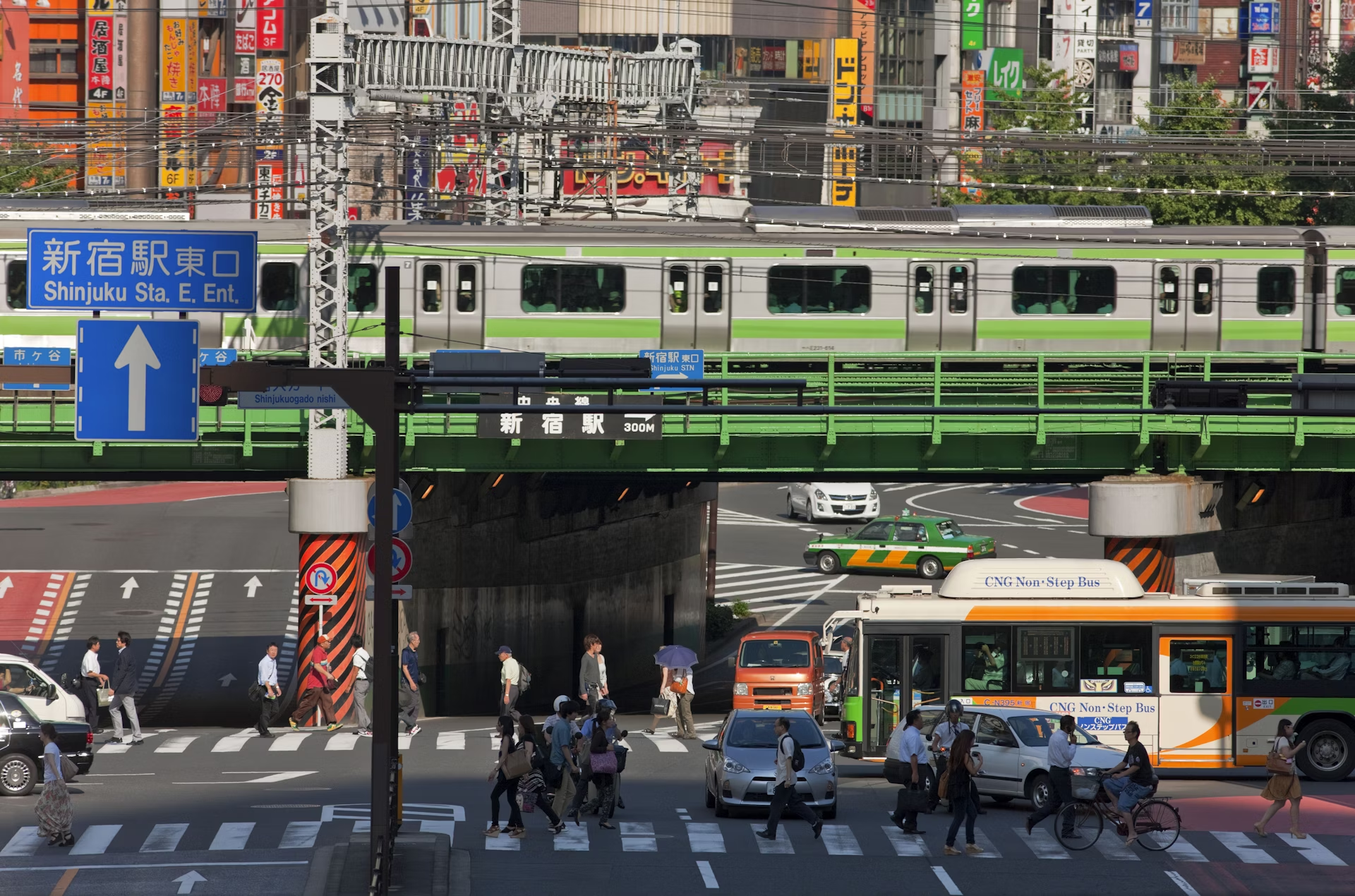
See more of Tokyo on a bus
Toei runs an extensive bus network in Tokyo, though it’s only more convenient than the subway when you’re in the outer suburbs or making short inner-city jaunts. A particularly useful bus, the number 06, connects Shibuya , Hiroo and Azabujuban – three popular cosmopolitan neighborhoods.
Fares are ¥210 for adults and ¥110 for children; there are no transfer tickets. Pay by IC pass or deposit your fare into the box as you enter the bus – if your pass is out of credit, you can charge it at the front of the bus (the word for “charge” is cha-ji).
There’s also a change machine by the driver’s seat that accepts ¥1000 notes. Most buses have digital signage that switches between Japanese and English; otherwise, listen for your stop. Signal the bus to stop in advance of the approaching stop by pushing one of the buttons near your seat.
Japan is a global leader in hydrogen energy, one of the world’s cleanest energy sources, which emits only wastewater (even if some question the technology’s cost-effectiveness).
Some 85 hydrogen fuel cell buses have been in operation since March 2021, traveling primarily between Tokyo Station and the Tokyo Big Sight convention center in Ariake, while passing through the popular Yurakucho, Ginza and Tsukiji neighborhoods.
The local government is aiming to have more than 300 hydrogen buses in operation by 2030.
Get a fresh view from a water bus
Tokyo’s “water buses” look like robotic beetles skimming across the placid waters of its eastern river networks.
Thanks to their glass-walled exteriors, they’re a great option for taking in the sights of Tokyo Bay while traveling between Asakusa and the likes of Odaiba, Toyosu and Hama-rikyū Gardens .
Journeys will cost between ¥280 and ¥2600, depending on distance, and are generally more comfortable than their terrestrial public transport counterparts.
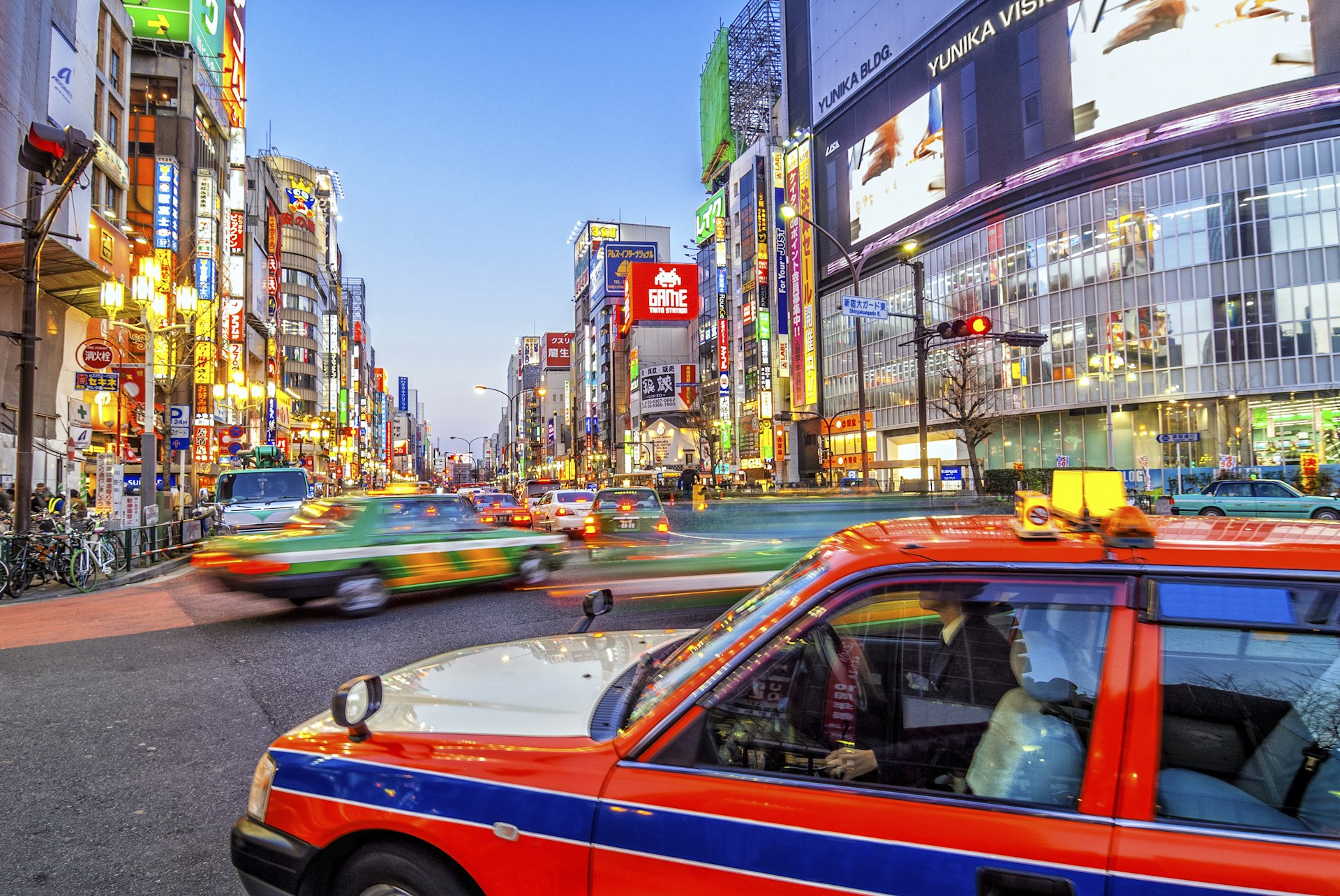
After a late night out consider a taxi
Getting a taxi in Tokyo only makes economic sense for short distances or when in groups of four – unless you’re stranded during the lull in nightly train operations.
All cabs run by the meter, with fares starting at ¥500 for the first 2km (1.2 miles) and then rising by ¥100 for every 255m (836ft) you travel or for every 90 seconds spent in traffic.
When traveling longer distances, this starts to add up at a rather alarming rate, especially when you factor in the nighttime surcharge of 20% between 10pm and 5am, and potential highway tolls.
Drivers rarely speak English, though most taxis have navigation systems. Have your destination written down in Japanese – or, better yet, a business card with an address.
Most taxis now also take credit cards and IC passes; since the pandemic began many have introduced automated payment systems attached to screens on the back of the main passenger seat.
Train stations and hotels have designated taxi stands. In the absence of a stand, you can hail a cab from the street by standing on the curb and sticking your arm out; there are typically far more taxis roaming the streets than punters hailing them down.
Local tips for using cabs and finding addresses
Japanese cab doors are automatic, and even after years of residence in the city, many foreigners find themselves struggling to open self-opening doors. Exercise patience!
Once in the taxi, you’ll notice how difficult Tokyo’s streets are to navigate, even for locals. Only the biggest streets have official names, and they don’t figure into addresses. Instead, addresses are derived from districts, blocks and building numbers.
Central Tokyo is divided first into ku (wards – Tokyo has 23 of them), which in turn are divided into chō or machi (towns) and then into numbered districts called chōme (pronounced “cho-may”). Subsequent numbers in an address refer to blocks within the chōme and buildings within each block.
Since it’s nearly impossible to find your destination using the address alone, smartphones with navigation apps have been a real boon.
Many restaurants and venues also have useful maps on their websites. If you get lost, police officers at kōban (police boxes) have maps and can help with directions, though few speak English.
At the very least, they should be able to steer you back to the nearest train station from where you can try again. Many businesses have also started using the What3Words app, which has divided the world into 3m-square grids to help users pinpoint a specific location.
Uber does operate in Tokyo but it's not cheaper
Uber arrived in Tokyo in May 2018, though its boutique chauffeur service, Uber Black, dates back to 2015. The ride-share company has partnered with three local taxi operators to provide rides in Tokyo’s central business district and other busy areas.
Even though Tokyo strictly regulates ride-sharing apps, other competitors are entering the market, such as the city’s premier taxi app, JapanTaxi (which isn’t particularly tourist-friendly).
Given Uber’s unpredictable availability and a pricing structure similar to that of street cabs, there are few occasions where using the app is merited.
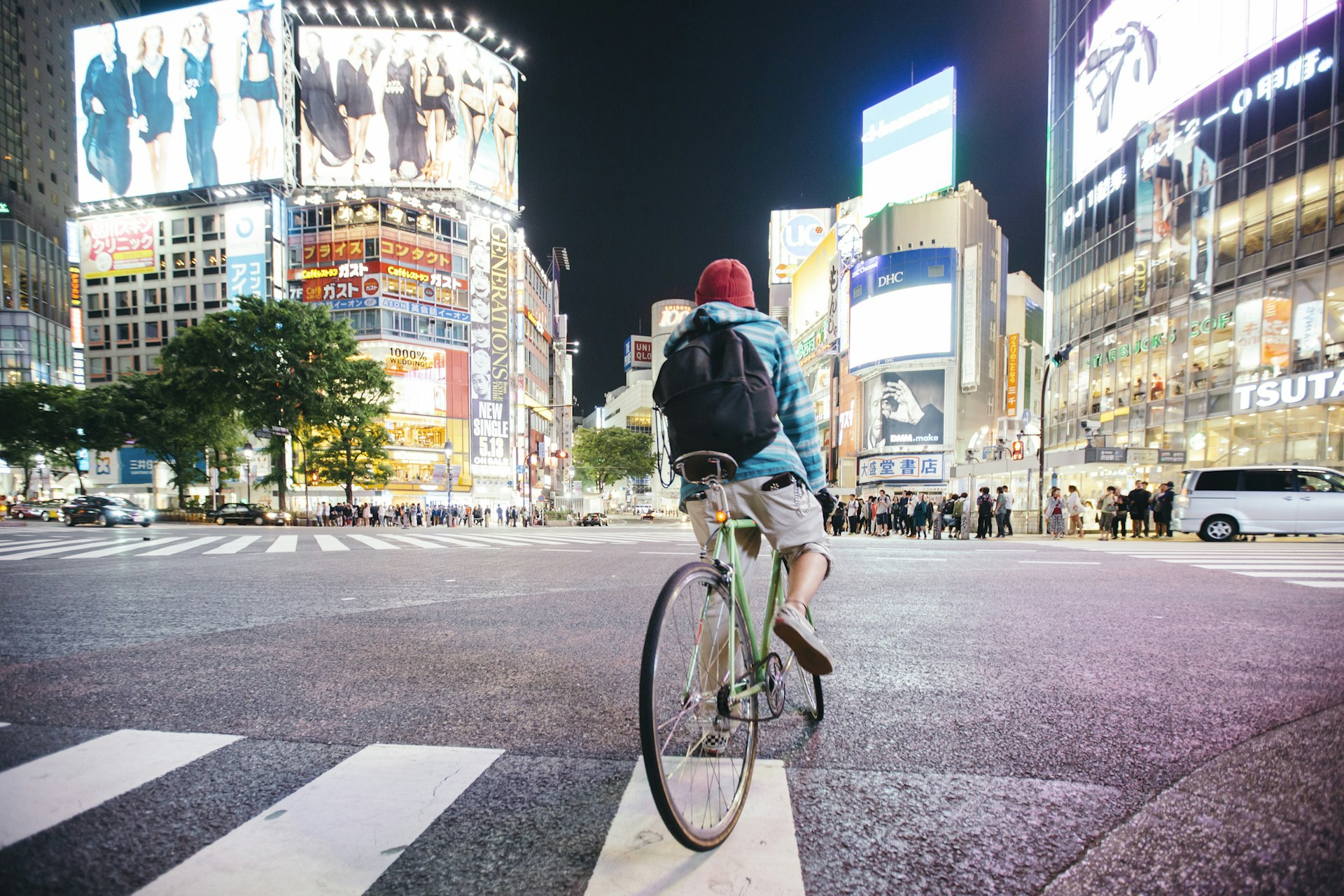
Cycling in Tokyo
At first glance, Tokyo doesn’t seem like a bicycle-friendly city: dedicated lanes are almost nonexistent on major thoroughfares, cyclists often come up against pedestrian overpasses that need to be scaled (though a few have ramps for walking bikes up and down), and you’ll see no-parking signs for bicycles everywhere.
Despite all this, you’ll also see plenty of pedaling locals. This is because Tokyo is a largely flat city, and much bike-friendlier if you’re cycling through city parks , in residential neighborhoods, along the river promenades near Tokyo Bay or around the maze of backstreets.
Cogi Cogi is a bike-sharing system with ports around the city, including some hostels.
Despite instructions in English, the system is a little complicated to use: you’ll need to download an app, register a credit card and have a wi-fi connection on the go to sync with the ports.
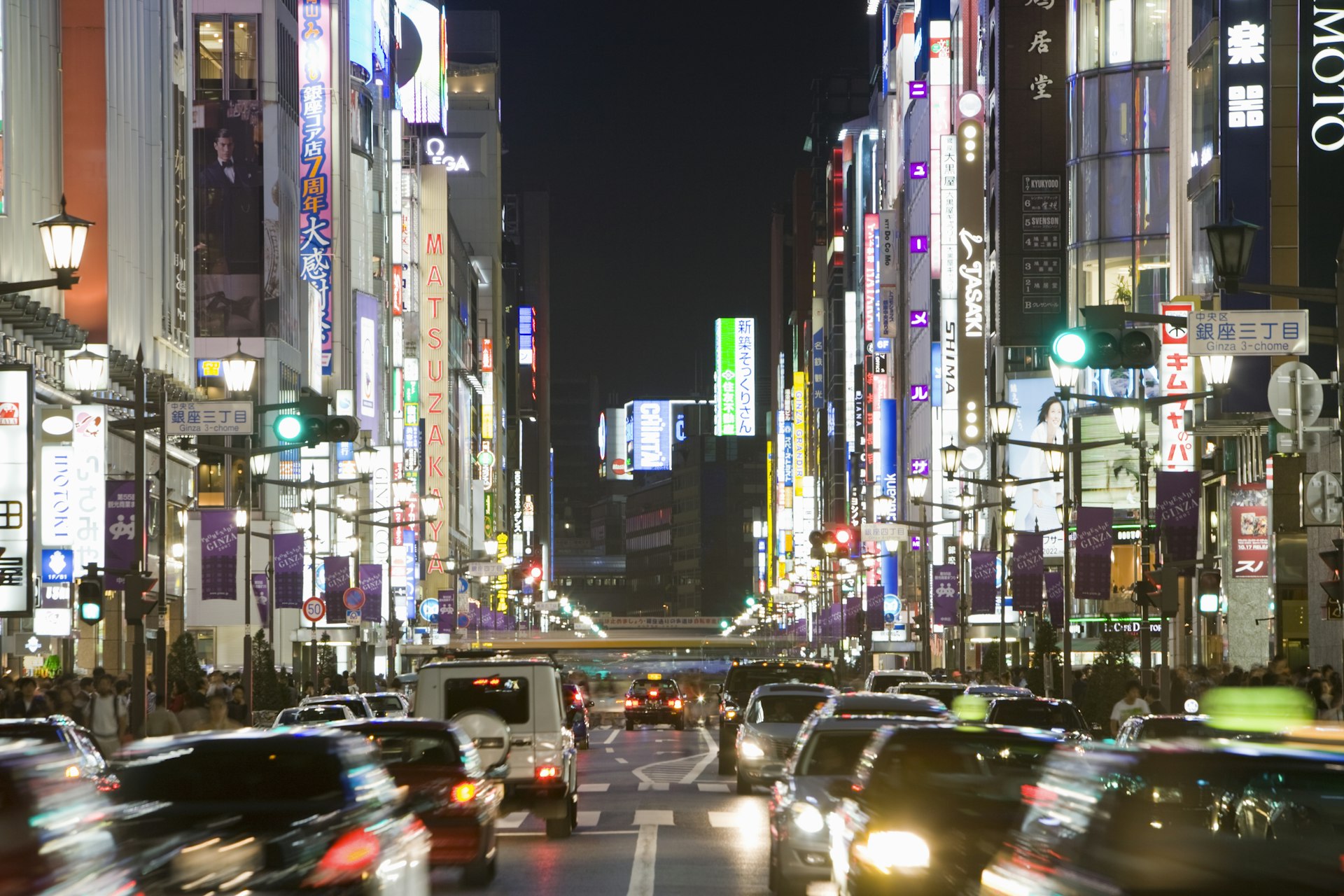
Think twice about hiring a car
Considering the traffic, the confusing and often excruciatingly narrow roads, and the ridiculous cost of parking, it’s best not to use a car to get around Tokyo; even most Tokyoties don’t bother owning a vehicle.
Day trips can easily be done by public transport, though renting a car will expand your options and allow you to explore regions rarely visited by the touring masses.
For rentals, you will need an International Driving Permit, which must be arranged in your own country before you leave; certain conditions must be met (see the Japan Automobile Federation website for further information).
Rental companies with branches around the city include Nippon Rent-a-Car and Toyota Rent-a-Car .
Local tips for car rentals in Tokyo
Rental cars are generally affordable, especially when the cost is split among passengers, and are economical with respect to gas mileage.
That said, highway tolls in Japan can be exorbitant – driving to Osaka and back, for example, would cost over ¥29,000 in toll fees, mitigating some of the money saved on skipping the bullet train.
Also be sure to pay the extra fee for damage insurance. In the event that you are in an accident, no matter how small, you must first call the police to record the incident before the vehicle is returned to the shop or you’ll risk incurring hair-raising financial penalties.
Rental operators are fairly unsympathetic to those who don’t follow these rules; it’s worth bringing a translator to go through the small print to avoid any such mishaps.
Accessible transportation in Tokyo
Tokyo is working hard to improve universal access – or bariafurī (“barrier-free”; バリアフリー) in Japanese. It’s estimated that at least 95% of Tokyo’s approximately 700 train stations have step-free facilities and accessible toilets, while 94% of buses are also wheelchair accessible.
Newer buildings have wheelchair-access ramps, more and more subway stations are introducing elevators (look for signs on the platform as not all exits have them), and yellow braille lines direct visually impaired passengers through major stations and guide them safely along platforms.
Train-station staff will also help wheelchair-using passengers on and off trains with a temporary slope.
A fair number of hotels, from the higher end of midrange and up, offer a barrier-free room or two (be sure to book well in advance). Note that what constitutes “barrier-free” is not always consistent, so check the details carefully.
Larger attractions, department stores and shopping malls tend to have wheelchair-accessible restrooms. If you need a wheelchair (車いす; “ kuruma isu ”) while in Tokyo, hotel staff can help you rent one.
Accessible Japan is the best resource for accessible travel. It also produces an ebook with lots of detail. Click here to download Lonely Planet’s free Accessible Travel guide.
This article was first published Apr 8, 2021 and updated Mar 23, 2024.
Explore related stories
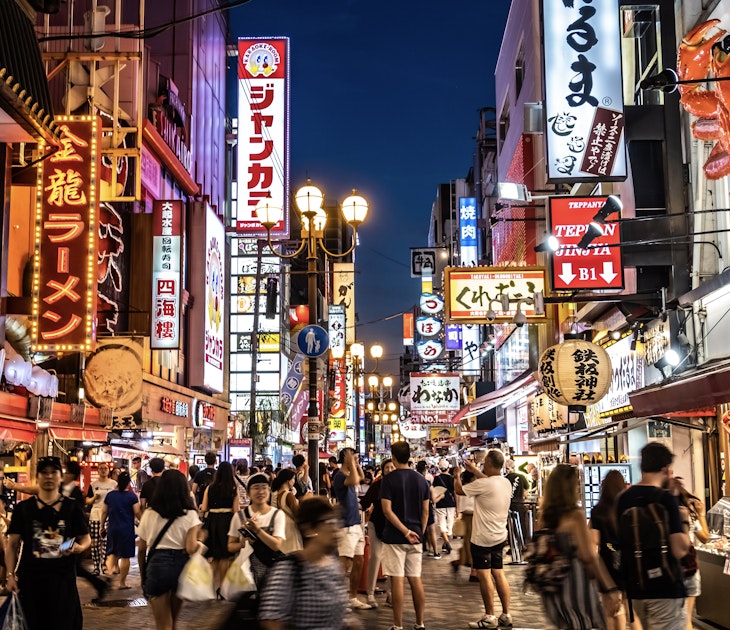
Art and Culture
May 1, 2024 • 9 min read
This four-day Osaka and Kyoto itinerary is a perfect add-on to any trip to Japan.

Apr 3, 2024 • 17 min read

Apr 2, 2024 • 10 min read

Mar 31, 2024 • 7 min read

Mar 28, 2024 • 7 min read

Mar 28, 2024 • 6 min read

Mar 28, 2024 • 11 min read

Mar 26, 2024 • 8 min read

Mar 25, 2024 • 6 min read
Why Disney fans will travel all the way to Japan for Tokyo Disneyland, DisneySea

- Tokyo Disneyland feels familiar with notable differences.
- Tokyo DisneySea feels foreign in the best way.
- There is no Disney Genie+ at Tokyo Disney Resort.
If you ever want to experience pure joy, go to Tokyo Disney Resort.
More specifically, The Happy Ride with Baymax at Tokyo Disneyland.
It may operate like Mater’s Junkyard Jamboree at Disney California Adventure or Alien Swirling Saucers at Disney’s Hollywood Studios , but the vibe is truly one-of-a-kind.
Cast members sing and dance in sync with the infectiously bubbly music. Fellow guests of all ages bop along while waiting patiently in line and wave their arms as the ride spins them around like kids who’ve had too much candy. You can’t help but feel happy.
“I want our guests to feel transported and to kind of escape from the daily grind. And I think that's what really Tokyo Disney Resort, the entire resort, does best,” Daniel Jue with Walt Disney Imagineering said ahead of Thursday’s opening of Fantasy Springs, the resort’s largest expansion since the opening of Tokyo DisneySea.
Disneyland may be the happiest place on Earth, but Tokyo Disney Resort is right up there. That’s just one of the reasons why Disney fans will fly across the world to visit its two parks: Tokyo Disneyland and Tokyo DisneySea. Here’s what travelers should know before they go.
A new Fantasyland? See inside Tokyo DisneySea’s new Fantasy Springs
Tokyo Disneyland feels familiar
Tokyo Disneyland feels very much like the original Disneyland in California and Magic Kingdom in Florida, with some notable differences.
There are numerous rides unique to the location, like The Happy Ride with Baymax and the wildly popular Enchanted Tale of Beauty and the Beast , which swirls and sways like Mickey and Minnie’s Runaway Railway through beloved scenes from “Beauty and the Beast” on trackless oversized dishes. The park is getting a totally new Space Mountain , expected to open in 2027. And it still has Splash Mountain , as Tokyo Disney Resort is owned by Oriental Land Company, which licenses from and partners with Disney.
Instead of Main Street U.S.A., guests enter the park through the glass-canopied World Bazaar. Instead of Frontierland, there's Westernland. The park’s Cinderella Castle may look like the one at Disney World, but guests can walk right through its upper chambers into Cinderella’s Fairy Tale Hall and throne room. The park also has a Toontown like Disneyland, whereas Disney World’s Mickey’s Toontown Fair closed years ago for New Fantasyland . Guests may also notice the Japan section of “ it’s a small world ” is larger than at other parks.
Tokyo DisneySea feels foreign in the best way
As Jasmine and Aladdin sang, Tokyo DisneySea is like “a whole new world.” Instead of lands, the park is organized into ports like American Waterfront, which looks like a coastal New England town, and Mermaid Lagoon, an indoor port, which makes fans of “The Little Mermaid” feel like they’re under the sea.
The park’s newest port, Fantasy Springs, opened Thursday. It features four new, location-exclusive attractions including the world’s only “Tangled”-theme ride, as well as Captain Hook’s ship, multiple restaurants, and stunning Disney-inspired rockwork fans will want to take time to explore. There’s also an adjacent Fantasy Springs Hotel overlooking the port with its own park entrance, like Disney’s Grand Californian with Disney California Adventure.
In the middle of Tokyo DisneySea, there’s a towering mountain, Mount Prometheus, and a large lagoon. One of the park's most popular and unique rides, Journey to the Center of the Earth , takes guests deep into the mountain, where unusual creatures await in the darkness. Nearby, guests can still ride 20000 Leagues Under the Sea , which closed at both Disney World and Disneyland years ago. At night, guests gather around the lagoon for the Believe! Sea of Dreams spectacular show.
There is no Genie+
There's no Disney Genie+ at Tokyo Disney Resort, but there are ways to cut waits for fees and for free.
Guests staying at the resort’s hotels can get a head start with Happy Entry . Instead of 30 minutes of early entry like at Disney World and Disneyland, Tokyo Disney Resort hotel guests get into the parks 15 minutes early through dedicated entrance lanes. That may not sound like much, but when you see the massive lines that form outside park gates early each morning, you’ll see what a difference 15 minutes make.
Instead of Individual Lightning Lanes, guests can purchase Premier Access for the parks’ most popular attractions. That lets them into shorter lines at designated times. Each one has a separate à la carte fee. Guests can also purchase Premier Access for reserved seating for parades and nighttime spectaculars.
Currently, Tokyo Disney Resort is also offering 40th Anniversary Priority Passes that work like Disney World and Disneyland’s old Fast Passes, granting access to shorter lines at select attractions and other experiences for free. Guests can request one pass at a time, pending availability on the resort’s free app.
The park app is also needed for free Entry Requests to Tokyo Disney Resort’s stage shows. These shows offer seating on a lottery basis rather than first-come, first-served.
During certain times of the year, a free Standby Pass may also be required to enter certain shops with high-demand, limited-edition merchandise.
Nearly everything is in Japanese
Guests who don’t understand Japanese will want to download a free app like Google Translate to read menu ingredients and ask for directions. Some cast members speak English, but unlike at Disney World and Disneyland, there are no paper park maps. There are only digital maps on the app.
Most rides are also in Japanese, but you can get the gist of what’s going on from other audio and visual cues, even on attractions like Sinbad’s Storybook Voyage , which has no equivalent in the U.S.
The food is almost too cute to eat
From custard-filled mochi that looks like the aliens from “Toy Story” to sandwiches made with fluffy white buns shaped like Mickey Mouse’s gloves to rice molded into Baymax sitting in a plate of curry, the food is almost too cute to eat at Tokyo Disney Resort. Don’t miss the many flavors of popcorn, like Matcha White Chocolate and the new Roast Beef, as well as the elaborately themed popcorn buckets and themed vending machines with both hot and cold drinks, depending on the season.
Guests with food allergies may want to bring a notecard indicating the allergy in Japanese to show at park eateries. Vegetarians may find fewer options than at Disney World and Disneyland. Picky eaters should note substitutions or modifications may not be allowed, particularly with set menu items.
Everything is cheaper
Flying to Japan is expensive, but nearly everything else is cheaper at Tokyo Disney Resort, including park tickets, food, and souvenirs like Mouse ear headbands, which are about half the price of those at Disney World and Disneyland. The favorable dollar-to-yen exchange rate also helps.
Disney fans will want to arrive with extra space in their luggage or a spare bag for the haul they’ll bring back home.
There’s no shame in Disney adulting
“I have this hypothesis that what so connects our guests here is that it is a place where they can be who they want to be,” Imagineering’s Jue said. “It’s OK to dance to the parades here. It's OK to walk around with a teddy bear here.”
And they do. Duffy the Disney Bear and his friends are a big deal. Not only do they have a whole show at Tokyo DisneySea, Duffy and Friends’ Wonderful Friendship , but there are numerous pint-sized photo opps for Duffy and friends plushies and tons of themed merchandise.
“I do think that we provide something very emotional that is necessary for our guests ... in a very safe place where you are not judged,” Jue said. “That's why they like their Duffys. Duffy does not judge them. Duffy accepts them for who they are.”
C ast members are magical
Cast members are the magic at any Disney destination, but they're especially effusive at Tokyo Disneyland. With exuberant smiles, they'll often enthusiastically wave with both hands.
Make sure to wave back.
The reporter on this story received access to the resort from Disney. USA TODAY maintains editorial control of reviews.
The Key Points at the top of this article were created with the assistance of Artificial Intelligence (AI) and reviewed by a journalist before publication. No other parts of the article were generated using AI. Learn more .

IMAGES
VIDEO
COMMENTS
Taking a food tour in Tokyo is essential for any trip to Japan. With more Michelin-starred restaurants than anywhere else in the world, Tokyo is the world's number one cuisine city. For alternative Tokyo gourmet travel experiences, check out: Tsukiji Outer Market Tours - experience Tokyo's atmospheric old fish market district
Spanning three geographical districts of Tokyo and…. Recommended by 100% of travelers. LIKELY TO SELL OUT*. 4. Tsukiji Fish Market Food Walking Tour. 280. Food & Drink. 3 hours. In this two-in-one walking and food tour, explore Japanese shrines and through Tsukiji Fish Market for seafood that has ….
Enjoy sampling different beverages in the lesser-known nightlife neighbourhood of Shinbashi on a Sake Tasting, Whisky, Cocktail and Pairing Tour →. Bring everyone along to Senso-ji and explore its surrounds on a Asakusa Family Food Tour →. Discover a different side of the Ginza neighbourhood on a Tokyo All-Star Food Tour →.
Torikizoku (Shinjuku, Shibuya, Tokyo, etc) Torishiki (Shinagawa) Kushiwakamaru (Nakameguro) 5. Japanese Curry. Brought to Japan in the late 1800 by the British, Japanese curry (カレー) is considered one of the nation's most popular convenience and comfort foods.
Pick 4: Tokyo Street Food Tour - 7 Japanese Foods Our Review: In the bustling streets of Tokyo, a tantalizing journey awaits foodies, offering a sensory experience like no other. Set out on a Tokyo Street Food Tour and learn about the vibrant flavors and rich cultural history of Japan. From the savory depths of ramen to the delicate artistry of sushi, this culinary adventure promises to take ...
Mochi and Traditional Sweets Making with Tea Ceremony. 7. Asakusa Family-Friendly Tour: Sensoji, Nakamise and Food. 8. Sumo Tournament, Chanko Nabe and Culture in Ryogoku. 9. Tokyo Ninja Food Experience. 10. Make Your Own Ramen and Gyoza in Asakusa.
In this travel guide of Tokyo for food lovers, find out where are the best places to eat in the city whether it's sushi, udon, ramen, yakitori, dessert, and more. This comprehensive list will make your trip planning that much easier with restaurant details, access to a map, and of course lots of photos.
Table of contents. Day 1: Traditional Snacks in Asakusa and Kitchen Utensils in Kappabashi. Day 2: Tsukiji Fish Market & Craft Beer in Yanaka. Day 3: Sushi Making Experience & Michelin-Starred Ramen. Day 4: Fancy Lunch in Ginza & Izakaya Hopping in Shinjuku. Day 5: Street Food in Sunamachi. Japan Wonder Travel Tours in Tokyo.
Quick Answer: The 7 Best Tokyo Food Tours For 2024. Best of Shibuya Food Tour. Izakaya Food Tour in Shinjuku. Shibuya Bar Hopping Night Food Walking Tour in Tokyo. Shibuya All You Can Eat Food Tour Best Experience By Local Guide. Shinjuku Omoide Yokocho, Kabukicho and Golden Gai Food Tour. Tsukiji Fish Market Food and Culture Walking Tour.
Eat like a local on a food tour. 11+ authentic tastings - from historic to modern eateries, savor genuine flavors. Explore 3 geographic districts of Tokyo - Nihonbashi, Tokyo Station & Akihabara. Culturally immersive experience including Shrine visit. Choose a private tour or join a small group with a maximum of 8 people.
A Tokyo Travel Guide. Tokyo Itineraries; Tokyo Hotels; Tokyo Ryokan; Tokyo Restaurants; Tokyo Districts; Best Time To Go To Tokyo ... cross the road and enter Mitsukoshi Ginza, which opens at 10:30am. Head down to B2 for the food hall. Any food purchased can be consumed on the 9th floor, home to a lovely open rooftop patio and field for ...
Shinjuku Golden Gai Night Tour. This is up there with the best food tours in Japan. Those looking for a wilder ride can take a night walk with an established guide in two of Tokyo's most notorious areas - Kabukicho and Shinjuku Golden Gai. For those looking for a beer and a bit of a party, this is the one for you.
Here is our carefully curated list of Tokyo's 10 best food tours: Tsukiji Fish Market Tour. Shibuya Food Tour. Ramen Tour. Sensoji and Asakusa Food Tour. Eating and Drinking Tour in Shinbashi. Shinjuku Food Tour. Japanese Sake Brewery Tour. Bar Hopping Tour.
Starting this list of incredible food tours in Tokyo is this comprehensive 3-hour trip around Tsukiji Fish Market around local dishes and culture. Led by a knowledgeable guide, you'll get the chance to explore the bustling outer market and learn about the rich history and culture of Japanese seafood.
The following are some popular Tokyo specialties: Nigiri- zushi. The most popular type of sushi today, nigiri-zushi originated as a fast-food dish in Tokyo. Consisting of a piece of seafood put onto a small ball of rice, it takes much less time and effort to prepare than more traditional sushi dishes.
7. Shibuya Food Tour. Go on an ultimate local food tour and taste Tokyo. This tour brings you to the glittering district of Shibuya, the center of culture, fashion, and food in Tokyo. The place is known for Shibuya Crossing but it's also filled with various tasty food.
Tokyo Food Tour. Our Secret Food Tour: Tokyo will introduce you to the best of Japanese cuisine. You'll learn from our guides about all the delicate nuances of flavor as they change with the seasons and how our appreciation for Japanese customs and traditions plays into the preparation and enjoyment of our local food. Most Popular.
Tokyo Local Bike Tour for Foodies. Explore the delicious flavors and attractions of Tokyo on two wheels! Join our Tokyo bike tour and experience the city's best eats in the eclectic neighborhoods of Nakano, Koenji, and Asagaya. Come and see Tokyo through a local's eyes! from ¥12,500. (9) With lunch.
Tokyo Bar Hopping Night Tour in Shinjuku. 1,801. Seeking out the well-concealed back-alley bars of Tokyo's Shinjuku district is notoriously tricky for outsiders. Take the guesswork out of your trip on this guided tour that takes you barhopping to Izakaya bars in two different alleyways in Shinjuku with a small group.
Senso-ji in Tokyo food trip photo by 1986-0125 via unsplash Day 1: Shinjuku Station. Hailed as the world's busiest hub, Shinjuku Station is a major railway station in Tokyo, Japan catering to more than 2 million passengers daily and is amongst the top favorite districts in Japan.
According to our food tour guide, Golden Gai is a favorite hangout among Tokyo's creatives like artists, photographers, film directors, and writers. Like Omoide Yokocho, it's teeming with character and a great place to get a drink. Check out Get Your Guide for a list of tours that take you to Golden Gai. 2.
The best thing about Tokyo for food-lovers is you can eat and drink well on any budget. This itinerary hits the higher end of midrange (you could spend less, but you could spend a whole lot more). Take it down a notch by swapping one of the meals for ramen, which hardly ever disappoints. Tamago-yaki (rolled omelette) from Yamachō makes for a ...
🤫 OUR ULTIMATE JAPANESE FOOD GUIDE: https://chadandclaire.com/shop/p/japan-food-guide 🤭 OUR ULTIMATE JAPAN TRAVEL GUIDE: https://chadandclaire.com/sh...
10,899. Tokyo, Japan. With its futuristic skyscrapers, unrivaled food scene, and wild nightlife, Tokyo is a rush of pure adrenaline. The city is famously cutting-edge, yet its ancient Buddhist temples, vintage teahouses, and peaceful gardens offer a serene escape—and a reminder of its past. Spend the morning in Asakusa, Tokyo's historical ...
Tickets start at ¥180 and go up depending on how far you travel. Tokyo has 13 subway lines, nine of which are operated by Tokyo Metro and four by Toei. The lines are color-coded, making navigation fairly simple - although a transfer ticket is required to change between the two networks. A Pasmo or Suica card makes this process seamless, but ...
Save money when you travel to Tokyo, Osaka & Kyoto using the Klook Rail Value Pass, the perfect JR Pass alternative! 5 Apr 2024 ... A Journey Through Food and Culture: a Guide to Discovering Bangkok's Floating Markets The floating markets of Bangkok are some of its most popular attractions. Visit one of its two most popular ones as well as a ...
Tokyo Disneyland feels familiar with notable differences. Tokyo DisneySea feels foreign in the best way. There is no Disney Genie+ at Tokyo Disney Resort. If you ever want to experience pure joy ...